
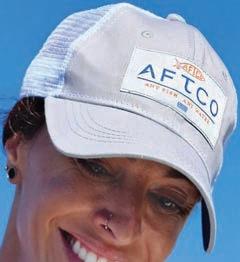
TIDE PREDICTIONS & SOLUNAR FEED TIMES INSIDE! Only $4.95 September 2023 TSFMAG.COM Middle & Lower Coast Trout Regs Revert to Pre-Freeze on September 1, 2023 Jay Watkins Shares REEF STRATEGIES BULL REDFISH Run Starts THIS MONTH
Introducing a new chapter in Total Boat Control with the Power-Pole MOVE™ Brushless Trolling Motor. These two models conquer the harshest conditions with unrivaled power, unmatched durability and unbelievable efficiency that operates with near absolute silence. Go farther. Fish harder. Make every move count.


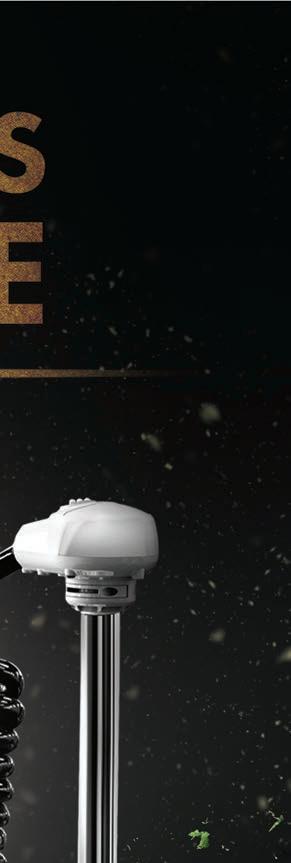


Power-Pole.com


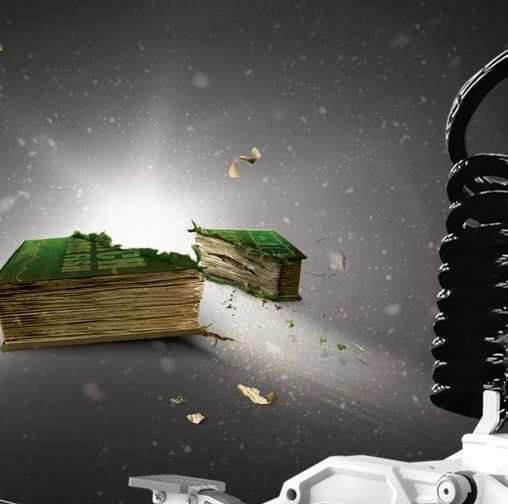
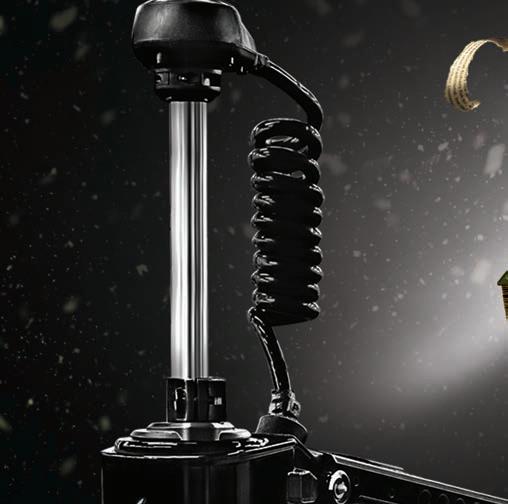
Now Available At Your Local Dealer
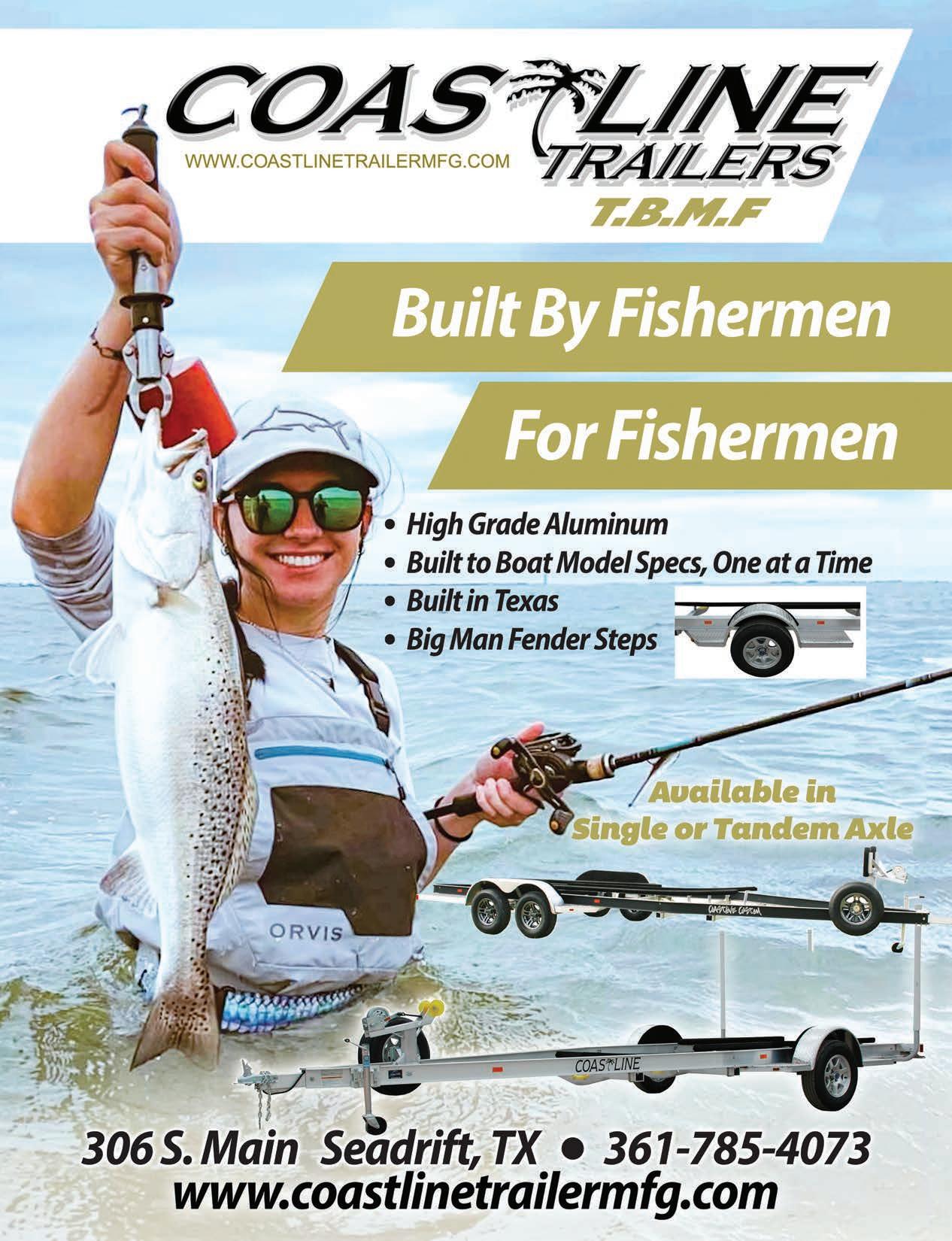

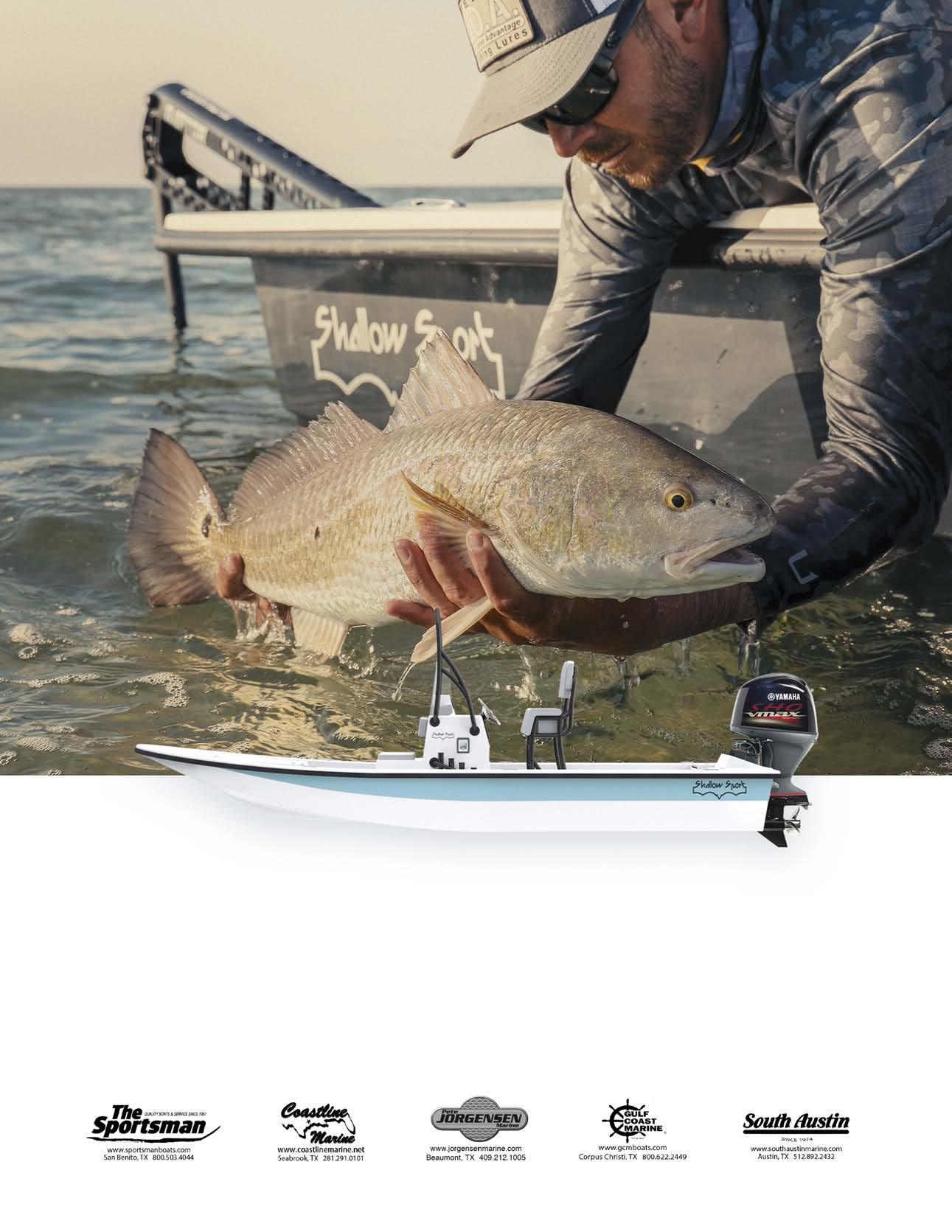

www.ShallowSportBoats.com Draft on Plane Draft at Rest Hole Shot Draft 4” 8” 10” The SPORT takes on rougher water with an unbelievably comfortable and dry ride. Hands down, the SPORT is our most popular model for guides and seasoned anglers.
21 SPORT
Powered By
Best all-around fishing machine
(Image from Interactive Builder)
ABOUT THE

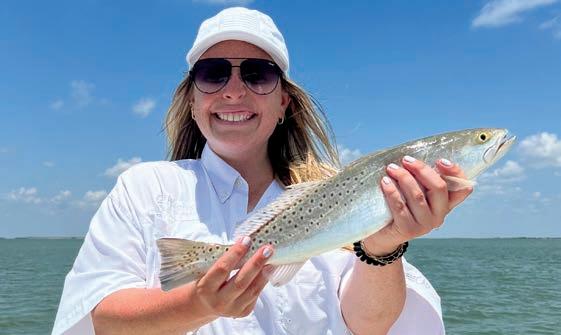
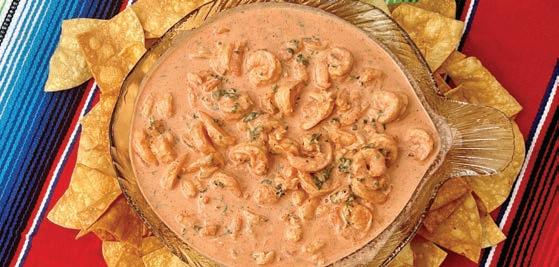
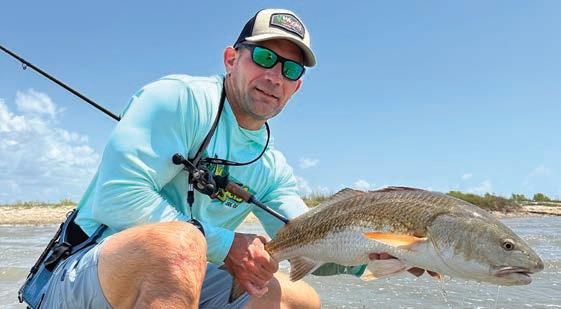

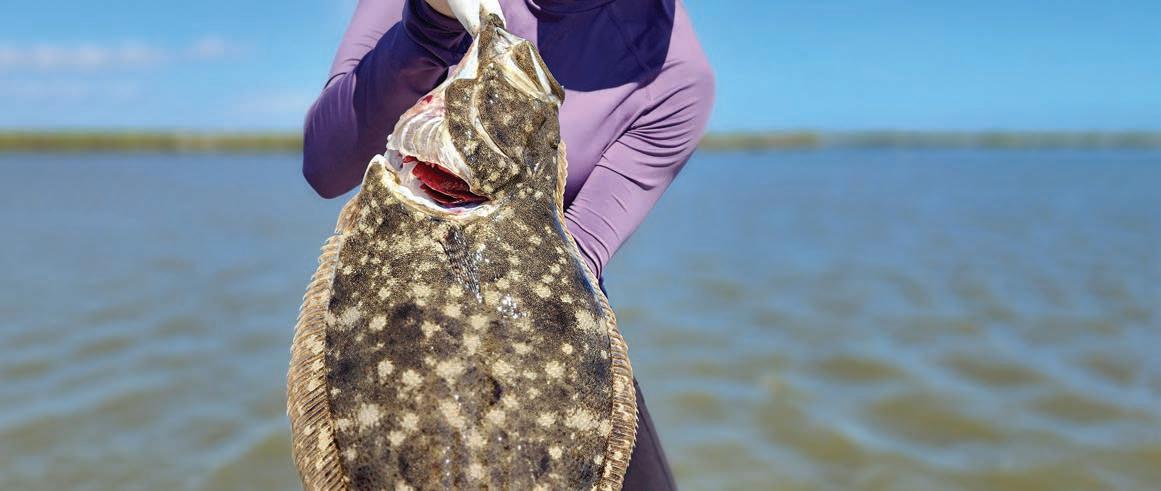
WHAT OUR GUIDES H AVE TO SAY 56 The View from Matagorda Bink Grimes 58 Mid-Coast Bays with the Grays Shellie Gray 60 Hooked up with Rowsey David Rowsey 62 Wayne’s Port Mansfield Report Wayne Davis 64 South Padre Fishing Scene Ernest Cisneros REGULARS 6 Editorial 52 New Tackle & Gear 66 Fishing Reports and Forecasts 70 Catch of the Month 72 Gulf Coast Kitchen DEPARTMENTS 32 Let’s Ask The Pro Jay Watkins 36 TPWD Field Notes Joel Anderson & Jillian Swinford 38 Shallow Water Fishing Dave Roberts 40 TSFMag Conservation News CCA Texas 42 Fishy Facts Stephanie Boyd 46 Extreme Kayak Fishing & Sharks... Eric Ozolins 48 Mostly Sight-Fishing Jake Haddock 55 Science & the Sea UT Marine Science Institute FEATURES 8 The Writing’s on the Wall Steve Hillman 14 The Eighty-Percent Rule Kevin Cochran 22 The Well-Rounded Angler Chuck Uzzle 26 Chumming Bull Reds Joe Richard 30 Fact or Fiction: Dispelling Myths... Nicholas Haddad 8 38 72 62 SEPTEMBER 2023 VOL 33 NO 5 CONTENTS
COVER
is our September cover angler…check out the size of that flounder!
Anne was fishing the San Bernard area and tricked her trophy flatfish with a Bio-Syn Baits soft plastic lure. Evidently the natural shrimp color was right on the money. Look for flounder
up as fall weather approaches. 4 | September 2023
Lea Anne Powell
Lea
action to heat
EDITOR AND PUBLISHER
Everett Johnson | Everett@tsfmag.com
VICE PRESIDENT
PRODUCTION & ADVERTISING DIRECTOR
Pam Johnson | Pam@tsfmag.com
Office: 361-785-3420 Cell: 361-550-9918
ADVERTISER REPRESENTATIVES
Bart Manganiello Bartalm@optonline.net
Pam Johnson | pam@tsfmag.com
Office 361-785-3420 Cell 361-550-9918
Everett Johnson | everett@tsfmag.com
Office 361-785-3420 Cell 361-550-3637
CIRCULATION
SUBSCRIPTION – PRODUCT SALES
Vicky Morgenroth Store@tsfmag.com
DESIGN & LAYOUT
Stephanie Boyd Artwork@tsfmag.com
SOCIAL MEDIA COORDINATOR Bob Barrera Texas Saltwater Fishing Magazine is published monthly. Subscription Rates: One Year (Free Emag with Hard Copy) Subscription $32.00

E-MAG (electronic version) is available for $15.00 per year. Order on-line: WWW.TSFMAG.COM
MAKE CHECKS PAYABLE TO: Texas Saltwater Fishing Magazine Attn: Subscriptions P.O. Box 429, Seadrift, Texas 77983

* Subscribers are responsible for submitting all address changes and renewals by the 10th of the prior month’s
Texas Saltwater Fishing Magazine (ISSN 1935-9586) is published monthly by Texas Saltwater Fishing Magazine, Inc., 58 Fisherman’s Lane, Seadrift, Texas 77983 l P. O. Box 429, Seadrift, TX 77983 © Copyright 1990 All rights reserved. Positively nothing in this publication may be reprinted or reproduced. *Views expressed by Texas Saltwater Fishing Magazine contributors do not necessarily express the views of Texas Saltwater Fishing Magazine.
Periodical class permit (USPS# 024353) paid at Victoria, TX 77901 and additional offices.
POSTMASTER: Send address changes to Texas Saltwater Fishing Magazine, Inc., P. O. Box 429, Seadrift, TX 77983.

issue. Email store@tsfmag.com for all address changes or please call 361-785-3420 from 8am - 4:30pm. The U.S. Postal Service does not guarantee magazines will be forwarded. HOW TO CONTACT TSFMAG: PHONE: 361-785-3420 FAX: 361 792-4530 MAILING ADDRESS: P.O. Box 429, Seadrift, Texas 77983 PHYSICAL ADDRESS: 58 Fisherman’s Lane, Seadrift, TX 77983 WEB: www.TSFMAG.com PHOTO GALLERY: photos@tsfmag.com PRINTED IN THE USA. TSFMAG.com | 5 SALT OFF® quickly and effectively flushes engines and removes salt deposits from metal, fiberglass, plastic, and painted surfaces. Plus, marine-grade polymers help prevent the formation of future deposits, so you can get your salt on without the worry of salt corrosion. Salt On! When you’ , get your Salt Off! ASK OUR EXPERTS STARBRITE.COM
NEW (OLD) MIDDLE & LOWER COAST TROUT REGULATIONS
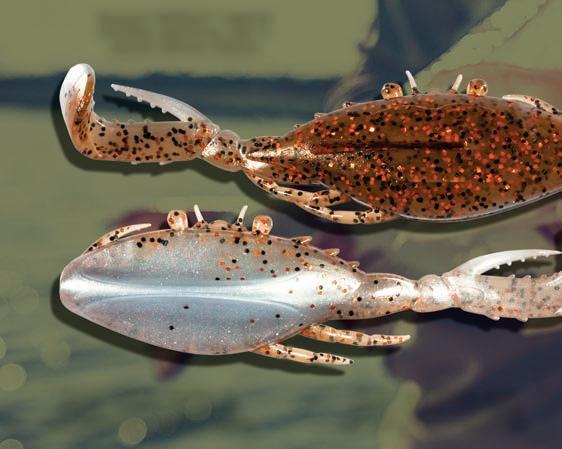
September has arrived. The 23rd will mark the first official day of fall, but don’t expect a sudden change in the weather. If the past two months are any indication, and unless we might see some tropical weather developments, I’m willing to bet the current heat wave could continue through the majority of the month. In the meantime; keep a stiff upper lip. Fall brings fabulous fishing, even if it takes its good old time getting here.
Spotted seatrout regulations are once again grabbing headlines. Effective September 1, the temporary three fish daily limit on Middle and Lower Coast bays enacted by the Texas Parks and Wildlife Commission (TPWC) in response to the February ’21 freeze, will expire and revert to the prior five fish daily limit. The size of trout anglers can retain will also revert to 15- to 25-inches, with one per day longer than 25-inches.
Why so soon – the fishery is just now showing solid signs of recovery? Excellent question, and there’s an easy answer, but it’s not popular with conservation-minded anglers, even less so with anglers who yearn to see more upper-class fish in the population…see also Yours Truly. What it boils down to is that the temporary regulations were enacted
in statute, which requires a sunset provision. Hence, the old regulations being reinstated. Does this make me as a concerned angler happy? No! I, like many, would have preferred another year, maybe two, but that’s not going to happen.
Was there benefit derived during the time the temporary regulations were in effect? Indeed, I believe there was, and I will enumerate.

First is the fact that Lower Coast bays made significant strides in recovery as seen in TPWD’s gill net surveys. There have also been remarkable strides in recruitment, new year classes, also recorded in population sampling, especially in the Matagorda bay system that got absolutely clobbered during the freeze. Also noteworthy is the debunking of the old myth; TPWC only takes…never gives back. Last but not least; fishing guides who said reducing trout limits will put me out of business. That didn’t happen.
So, where do we go from here? My personal plan is to continue fishing very conservatively. My friends and I will continue practicing CPR, except for occasional trout not likely to survive after release. I urge you do the same.
Make your voice heard. Attend TPWD public scoping meetings. TPWD maintains a comment portal, get online and tell them what you want to see in future management of the fishery. Join CCA Texas; they have been leading the way in fisheries conservation since 1977.
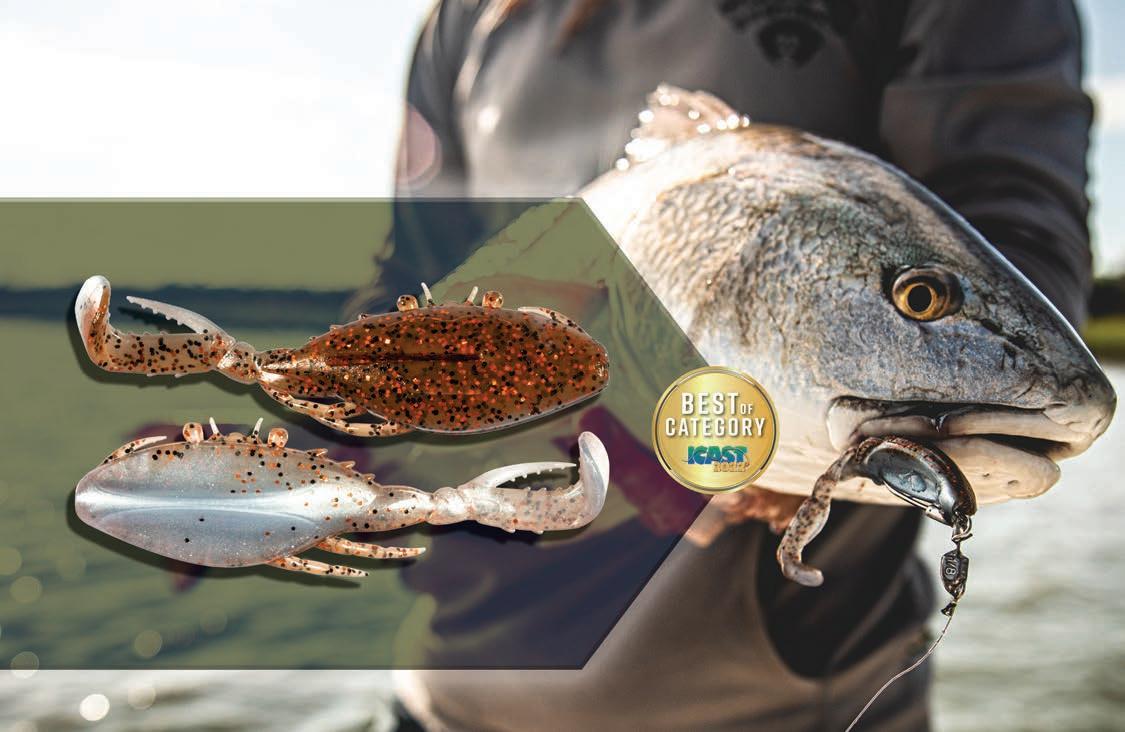

September is the beginning of cast and blast season. Get your kids involved!
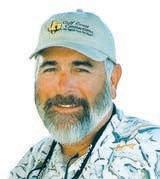
EDITORIAL
September Issue Highlights
6 | September 2023
View The Video Open Camera & hover over QR Code. When link appears, tap to open in YouTube.


Certain areas of our bays have lots of these little trout. We always say that it bodes well for next year, but we say that every year. Where do they go? Hmm.
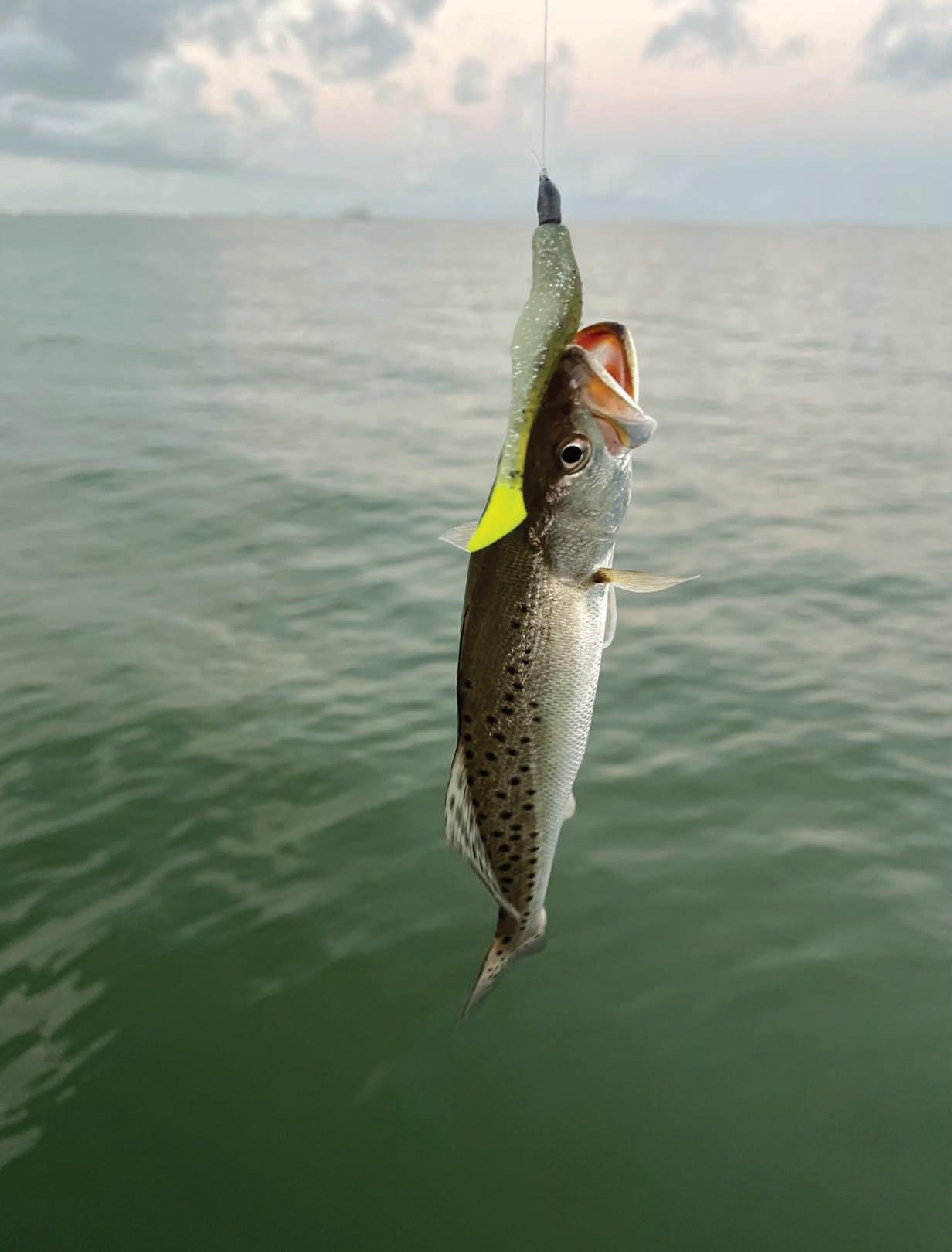
The Writing’s on the WALL
STORY BY STEVE HILLMAN
I’ve always had a tendency to recap our fishing by season because it just seems to make sense. With summer soon coming to a close I look back on the highs and lows and the reasons for both. While June 21 was the official first day of summer, I generally include the month of May because that’s when our water temperatures begin to stabilize and fish begin to exhibit more consistent warm-water behavior patterns.
May was by far our most productive month for catching trout, so far this summer. The majority of the legal trout ranged from 15- to 18-inches with the highest percentage averaging 16 inches. The majority were females. There were some days when we would hit patches that included fair numbers of healthy 19- to 22-inch specks. The largest Galveston Bay trout on my boat this summer was a 24.5 inch female caught while wading a West Bay shoreline. I also remember releasing one very chunky 23-incher that weighed almost 5 pounds, caught while drifting live oyster on the west side of Galveston Bay. We had many mornings where we caught 30 to 40 legal trout before 9AM. I’d say it was pretty good by today’s standards, on our part of the coast, anyway. Now, let’s dig a little into some of the reasons for our May success.
Prior to April and May, the Trinity and San Jacinto rivers dumped large amounts of fresh water into the back of Trinity Bay and Upper Galveston. The majority of the fresh water came from heavy upstream rainfall events. This scenario concentrated fish along the east shoreline of Trinity Bay, the west shoreline of Galveston Bay proper, and into portions of Lower Galveston Bay. To some this created the perception that we had millions of trout. The reality was that it was a combination of three things.
1. Resident trout being stacked up by fresh water as they fled from low salinity areas.
2. Tide-runner trout beginning to come in from the Gulf.
3. Light winds afforded anglers the opportunity to go catch them.
Everything came together. It was awesome to experience. However, it lasted only about five weeks.
TSFMAG.com | 9
All of June and continuing through July 26 as I am writing this article, has been a very humbling experience for me and my clients, and many others. Not only have we been plagued by near constant southwest winds and low tides, but the areas where we could traditionally catch trout in such conditions seem to be void of life other than a few undersized trout. And, as for those west side stretches of water that held so many fish for the five weeks prior…well, they vanished overnight as bay wide salinities rose and the fish spread out.
Wading and drifting near passes has been our saving grace as tide-runner trout in these areas traverse back and forth from the beach to the bay. The key phrase of the day here is “tiderunner trout.” In other words, they are not resident fish. It’s important to know the difference when trying to understand how to manage a fishery. Some deeper areas along the Houston Ship channel have been holding decent numbers of 10- to 14-inch specks, but very few legal ones. The only exceptions have been some wells and other deep water structure (10 to 14 feet) but those trout are being caught mostly on live bait and are few and far between. Catching 16 or 17 legal trout on lures is a good day for me right now. I remember when I used to apologize to clients for those kinds of days. The bar has definitely been lowered.
With the sunset date (August 31, 2023) of TPWD’s emergency trout regulations on the middle and lower coast fast approaching, discussions of spotted seatrout size and bag limits have once again become the hot topic up and down the Texas coast. For those not aware, TPWD implemented an emergency size and bag limit change roughly two years ago as a result of the February 2021 freeze. The impact of the freeze with regards to spotted seatrout mortality varied among bay systems with Matagorda and San Antonio being hit the hardest.
On September 1, 2023, spotted seatrout size and daily bag limits will revert back to 5 per day with 15 to 25inch retention slot, while also allowing one per day greater than 25 inches. The emergency regulations allowed only 3 trout per day between 17 to 23-inches with no trout over 23 inches allowed. The emergency rule was
implemented from FM457 southward to Brownsville. Galveston Bay and Sabine including their adjacent satellite bays were never part of the emergency rule.
Very recently, there have been petitions popping up and public outcry from concerned anglers to keep the “emergency limits” in place for not only the previously affected areas but also to include the Upper Texas coast. For the record, I’m in the same camp as those “concerned anglers.” It is my understanding that this will not happen because there was a sunset date already established. However, I’ve also heard that TPWD will be holding scoping meetings in the near future to revisit spotted seatrout limits, among other things.
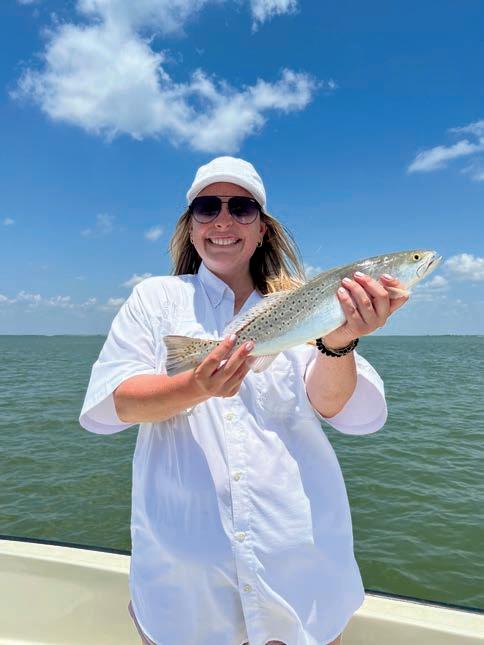
I’ve read tons of comments on social media and I find it interesting that a lot of folks have recommended a limit of 5 trout with a 15-20 inch slot. Their justification is that the larger females, say those 17-23 inchers, are some of our most prolific spawners. While this is certainly true there are far fewer specks in that range in the overall trout population. This is precisely why TPWD elected to protect the trout below 17 inches with their emergency rule. The 17-23 inch female trout are 2.5 to 4.5 year old fish. The 12-17 inch females are 1 to 2.5 years old.
Age Structure Percentage of Spotted Seatrout Population Coastwide: Age % of Population
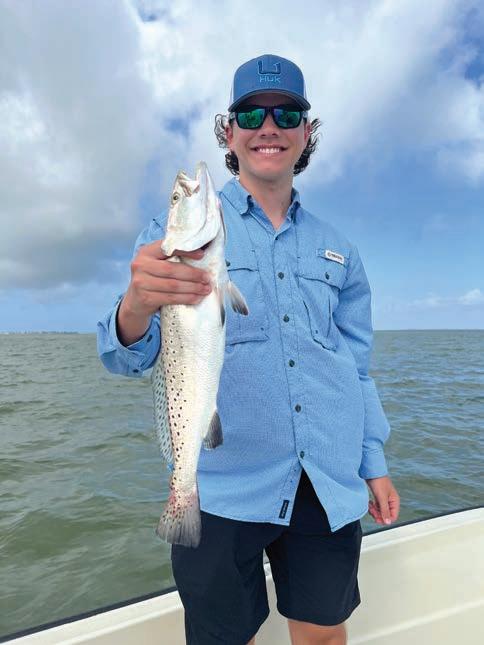
0 39.28%
1 27.52%
2 17.28%
3 8.82%
4 4.13%
5 1.59%
6 0.72%
7 0.48%
8 0.15%
9 0.03%
Source: TPWD Coastal Fisheries
Initially, I was thinking what most people probably were. Why would TPWD want us to retain trout that spawn so many more eggs than a 15 inch female? After having it explained to me by a TPWD biologist and then actually looking at the data, I realized that they were correct and had made a smart decision with regards to the emergency rule. In addition, I know
Gianreo Mire was happy to trick this solid midsummer trout on a slow bite kind of day.
10 | September 2023
Melissa Samperi with her first trout on artificials!
what I witness day in and day out on the water (Galveston and Matagorda Bays). My observations on daily trips have been that we catch many more 12 to 16.5 inch specks than 17-23 inchers. It all started making sense.
Here is my take on how to manage our trout fishery: Multi-Tiered Trout Management Plan
From a regulatory standpoint, a multitiered coastwide trout management plan should be implemented as soon as possible. This plan would focus on increasing our biomass first, and then once healthy resident populations of trout are re-established, we’ll look at managing our way towards a trophy trout fishery. This being said, not every bay system is the same. For example, the Lower Laguna Madre may need a different management plan than say, Galveston Bay. I know that here on Galveston, for whatever reason, there seems to be very few resident trout in some areas where they were once incredibly abundant; i.e. Trinity Bay, East Bay and West Bay. We have never fully recovered since Hurricanes Harvey’s flooding in 2017. Furthermore, as soon as our trout hit 15 inches they get harvested because there’s nowhere to hide. There are no secrets anymore.
Limited Entry/License Buyback for Fishing Guide Licenses
I don’t know what the exact number of Texas saltwater fishing guides might be currently, but it’s my understanding that there are somewhere around 1,700 and maybe more. I wouldn’t doubt it as I’ve personally seen the number of guides increase around here (Galveston) especially since we’ve gone to a 5 trout limit. We also experienced an increase during the COVID pandemic. There were 929 saltwater guides licenses sold in 2006 (“LimitsFood for Thought” Texas Saltwater Fishing Magazine, Steve Hillman, 2016) so the added fishing pressure should be obvious. With a drastic increase in guides and fewer fish, it’s safe to say that there needs to be a limited entry/ buyback program for saltwater guides’ licenses similar to what was established for the inshore shrimp fishery in 1995.
Sanctuary Areas
My good friend Mickey Eastman and
I talk quite frequently about our trout fishery along the Texas coast but more specifically here on Galveston Bay. He has told me for years that the waters north of the Fred Hartman Bridge in Baytown need to be established as a sanctuary area for trout. I couldn’t agree more as the waters north of the bridge hold really good numbers of trout and other species year-round (especially during the winter months when they become easy targets), and furthermore, this is one of the areas with a fish consumption advisory.

“Houston Ship Channel and all contiguous waters north of the Fred Hartman Bridge, State Hwy 146 including the San Jacinto River below the Lake Houston Dam.
Chemicals of Concern: Dioxins, Polychlorinated biphenyls (PCBs)
Advisories: Persons should not consume blue crabs or any species of fish from these waters.” - Source: TPWD Establishing sanctuary areas like this and possibly others will provide a serious boost in our spawning and recruitment numbers, which will ultimately help us re-establish resident populations of trout throughout the entire complex.
Atlantic Croaker
Atlantic croaker populations and size continue to decrease year after year. They once provided loads of fun and excellent table fare for those (me included) who targeted them during the fall croaker run. Croaker also afforded folks who were landlocked the opportunity to spend time with their families catching these hard-fighting, delicious fish. I’ll never forget me and my cousins dangling our feet off our pier on Dickinson Bayou catching 12 to 17 inch croaker and having my mom fry them up for us. Oh my God! Talk about delicious! I’ll take a croaker over a trout any day of the week.
A 10 inch minimum on Atlantic Croaker needs to be established ASAP in an effort to begin restoring our croaker populations.
Fishing Tournaments
Most of us in the fishing world are somewhat competitive; it kind of goes with the territory. I used to fish a lot of tournaments. Some were kill tourneys but most were live weigh-ins. Nowadays there are more tournaments than ever. Some are to raise money for
 These giant reds were trying to eat our small specks as we reeled them in. Some succeeded!
These giant reds were trying to eat our small specks as we reeled them in. Some succeeded!
TSFMAG.com | 11
JB with one of many solid trout he caught on an actionpacked morning back in late May (released of course).
charities and some are simply for the glory of taking home a trophy and some cash. Either way, with modern technology, there’s no reason to continue to have kill tourneys. My friend, Chad Peterek, has proven this with his Legends Tournament where every fish is weighed on the spot, videoed, and then released. There are other tournaments that have followed his lead and I believe there will be many more in the future. In the meantime, for those who choose to go the old school kill route, I think there they should pay restitution to TPWD for every fish killed. In addition, the days of large tourney creels like 5 trout and 2 reds should come to an end. I actually heard of a fundraiser tournament the other day where the creel was something like 5 trout, 3 redfish and 5 flounder. That’s just dumb.
Dead Dock Shots
We’ve got guides with 20-40 years of experience posting dock-shots of dead trout during a time in which we should be heavily promoting conservation. I would kind of expect some of the “younger” guides who perhaps don’t know any better (or don’t care) to spend time on TikTok or wherever doing silly stuff like that but not the old-timers. Hell, even some of the lure guides are doing it now. What an embarrassment to the profession! One of the issues with these types of posts are that they attract the type of clients who expect to go out and harvest as many fish as they see in the pics. And while this may be perfectly legal, it doesn’t mean it’s right or helping our fishery. The bottom line is that it’s not only a bad look for our industry but it’s simply out of style for these days.

Conclusion
We’ve been heading down a slippery slope for a while. We’ve dealt with habitat destruction from hurricanes, massive erosion, and many other natural and manmade problems. It continues to be an uphill battle. We all think we have the answers but there’s no silver bullet when it comes to managing our speckled trout fishery. I keep using the word manage but I think rebuild is more appropriate, especially here in the Galveston Bay Complex. If things don’t improve soon
everyone will suffer; fishing guides, lure companies, hotels, boat dealers, etc. Not to mention our kids and grandkids not getting to enjoy the bounties of Mother Nature.
I remember all those years I spent growing up in the commercial oyster industry. Some of the oyster dealers truly cared about sustainability but there were others who didn’t look past the next day. I feel very blessed to be able to make a living for me and my family from the resource God has provided. Unfortunately, I see many fishing guides who are only looking at today. I saw the writing on the wall then (in the oyster industry) and I hate to say it, but I see the same mentality when it comes to our speckled trout fishery today. I see fishing guides (lures and bait) who fish the same two or three spots every day and talk about how good it is as they whittle away on their little patch of trout, all the while knowing they are slowly fishing themselves out of business. It’s sad.
Unfortunately, we can’t control all of the environmental changes that occur year after year. That’s one of the reasons it’s so important for us as stakeholders to do everything in our power to not only stop the bleeding but improve our fishery. There’s got to be a common sense element. We know that some folks are going to want to keep a few fish, but when I see a group of four guides on their day off, going out dragging Flow Troll buckets full of live croaker and killing 20 trout just for a Facebook post, that to me is a problem. Last time I checked, hunting whitetail deer at night with a spotlight was illegal because it gives the hunter an unfair advantage. To me, grown men dragging buckets of live croaker are the same.
I’ve said it before but I guess I’ll say it again. It’s time we get our act together if we care anything at all about the future of speckled trout fishing here on the Texas coast. The writing is on the wall but I believe we have the ability to erase it if we care enough.
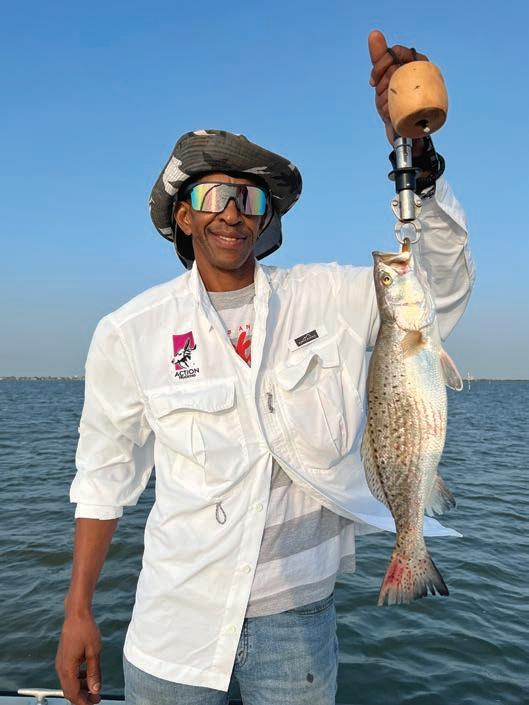
STEVE HILLMAN
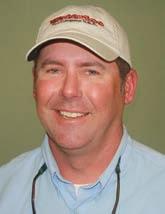
Late Summer Reds CONTACT Phone 4 09-256-7937 Email captsteve@hillmanguideservice.com Web w ww.hillmanguideservice.com
View The Video Open Camera and hover over QR Code. When link appears at top of screen tap to open in YouTube.
Steve Hillman is a full-time fishing guide on his home waters of Galveston Bay. Steve fishes the entire Galveston Bay Complex, wading and drifting for trout, redfish, and flounder using artificial lures.
Keith Horton’s trout was apparently almost a snack for a bottlenose dolphin. Notice the teeth marks. I see this a lot. Makes me wonder how many get eaten by dolphins (see my Nov. 2022 article “Would You Like Fries With That?” for a little insight on the impact of dolphins.


THE Eighty–Percent

Eighty–Percent RULE
 STORY
STORY
Across the sporting landscape, a popular myth prevails. Coaches and athletes repeat it regularly, though it has no real meaning. We’ve all heard them say, “It’s important to give 110% effort.” Any sane analysis reveals the silliness inherent to such a statement.
In its simplest form, 100% is an absolute. 100% literally means 100 out of a possible 100. The word possible is neither vague nor open to interpretation. To say a person can exert a physical effort which exceeds 100% indicates a basic miscalculation of the level which constitutes a maximal effort.
Extreme circumstances can add nuance to the discussion, of course. If imminent danger or other factors cause people to feel strong emotions and adrenaline begins pulsing through their veins, they can become temporarily capable of executing unusual feats. We’ve all heard of cases where a father, seeing his child clinging to life under the wrecked chassis of a car, summons seemingly superhuman strength and lifts the car up briefly to save the child.
BY KEVIN COCHRAN
Events like this don’t prove anything about the absolute value of 100% as a measure of capability, though. Adrenaline can temporarily change the amount of weight a person can lift, how fast they can run, or how far or high they can jump, essentially re-establishing the height of the 100% bar, but adrenaline surges don’t last forever, nor can they be summoned regularly, through will power. Coaches and athletes who repeat the mythical 110% mantra miss an important point―athletes need to properly calibrate their 100% exertion level and understand when to try and reach it.
Certainly, a sprinter running a 100m race needs to understand how to get out of the starting blocks and achieve maximum exertion as quickly as possible, then sustain it through the finish line. While doing so, the runner needs to avoid the tendency to press too hard in the process of attaining top speed. Pressing causes muscles to tighten, resulting in slower, not faster times. Sprinters have to learn to remain relaxed while running at full speed, and this is no easy task.

Track stars running longer races face more challenges, with regard to recognizing when and for how long to exert maximal effort. At about 400m or so, even the fittest and strongest humans lose the ability to run at full speed for the duration of a race, so participants in longer races must learn to pace themselves to produce their best results. Many of them recognize the need to push themselves to the limit either at the start or the end of a race, perhaps both, also the need for dialing back their level of effort somewhere along the way. Similarly, golfers generally recognize a need to limit their physical efforts while executing full shots. Many accomplished players say they normally swing at about 80% of top speed when striking full shots during competitive rounds. Certainly, some circumstances dictate swinging the club as hard and fast as possible, but no great player would attempt to do so on every shot. While track athletes intentionally power down during parts of a long race to conserve energy, golfers do so to increase consistency and improve accuracy. In both cases, athletes recognize the value in NOT attempting to give 100% at all times and in all circumstances.
A golfer participating in a long-drive competition would surely swing as hard as possible, at least some of the time. Long-drive competitions more closely resemble a series of sprints than a milelong run. But, the need to put a ball in play between the lines causes even golfers trying to win long-drive contests to intentionally pull back on the reins, at times. The realities related to this discussion vary in other sports, according to the details of the games, but the basic truth remains the same–sustaining physical efforts at the 100% threshold for long distances and long periods of time becomes impossible.
This tenet has application in the nebulous realm of the mind and soul too. Attempting to remain 100% focused on an intensely competitive activity proves every bit as difficult as running at full speed throughout a long foot-race; it’s impossible, at some point. If the competition takes enough time to play out, a person will simply not be able to keep the mind 100% engaged for the duration of the event.

Many golfers acknowledge the veracity of the last statement by intentionally distracting themselves from the tasks at hand while walking the fairways or standing and waiting between shots. They know their brain, like a gas tank, has finite capacity, and they don’t want to drain it prematurely by thinking too intensely about every detail of the game every step of the way. Once their turn to play arrives, they do strive to become fully engaged and committed to
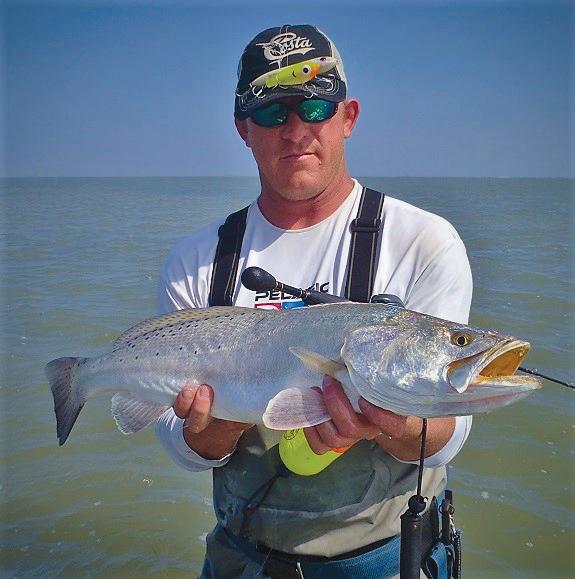
16 | September 2023
Randy Slocum shows excellent focus and dexterity when presenting topwaters and slow-sinking twitch baits.
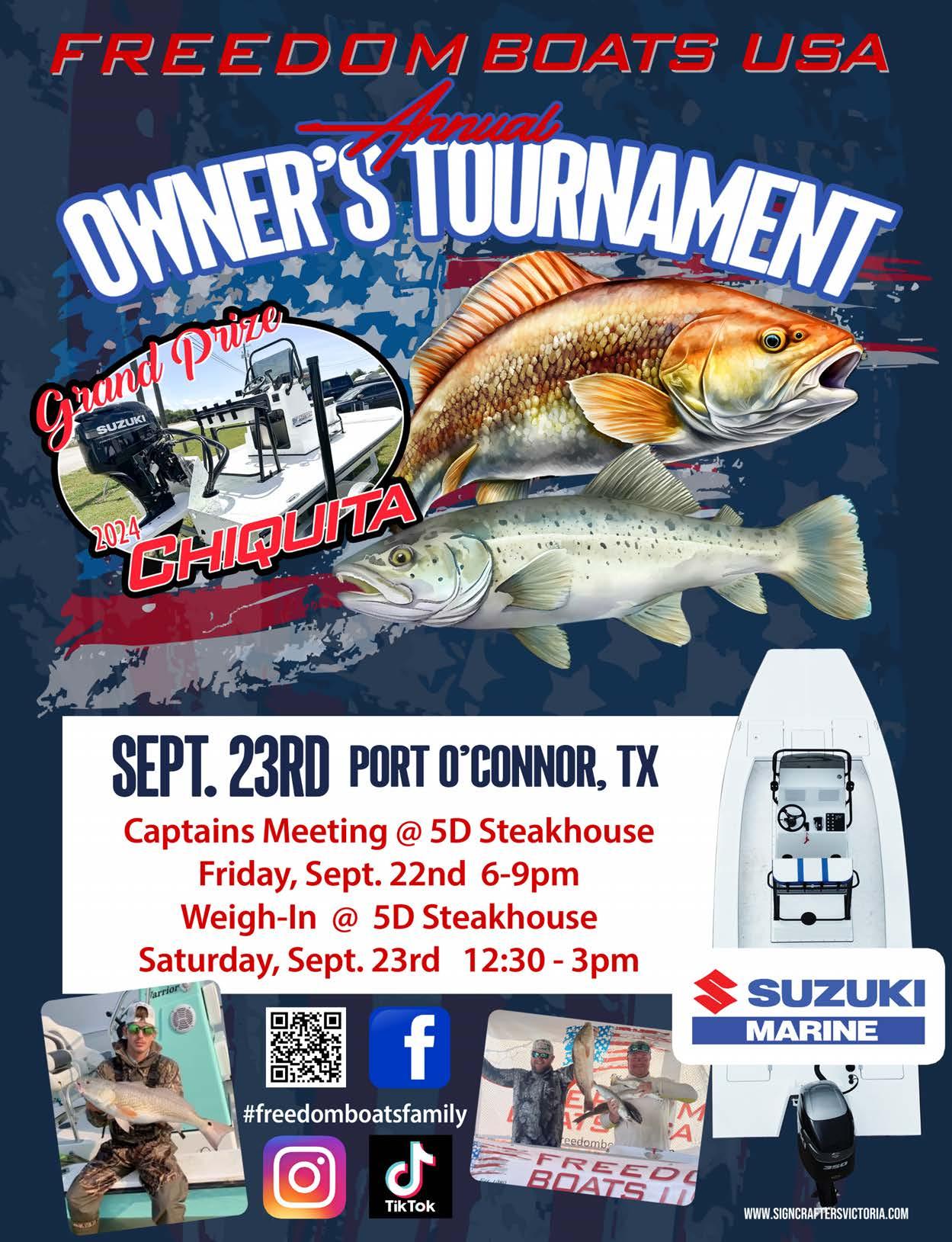
executing every shot. So, a golfer attempts to reach 100% mental capacity on each shot, but curtails the physical effort in the interest of achieving more consistent control.
Ideally, anglers should emulate golfers in some, but not all, ways. It’s important to fully define the term angler. In the context of this discussion, an angler is someone who fishes for sport, using artificial lures, with some kind of serious purpose in mind. A person competing in a tournament provides the classic example of an angler here.
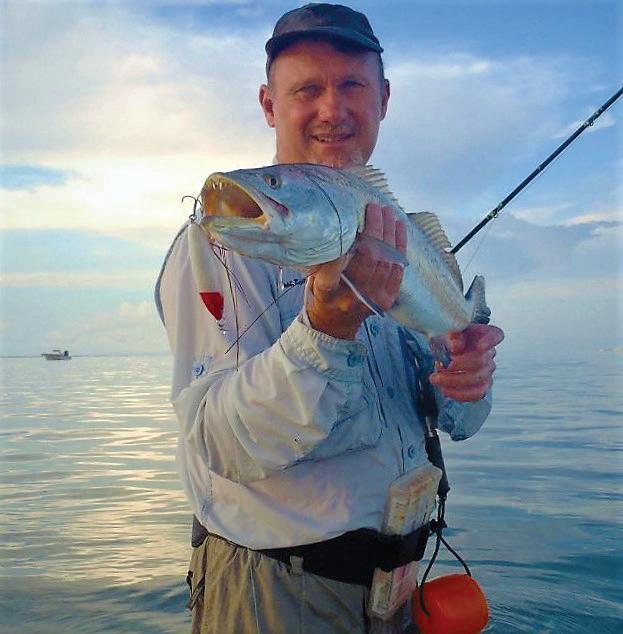
Fishing for sport resembles other athletic endeavors in many ways, one of which proves most relevant in terms of its influence on this discussion. Fishing for sport involves both physical and mental components. I’d say anglers should do what golfers do in the physical realm, meaning they should consciously resist the temptation to try and execute all casts with dead-full effort. For most people, executing casts at about the 80% level of effort will provide better accuracy and control, as it does for golfers striking full shots. A cast, like a single shot in golf, involves more physical than mental components.
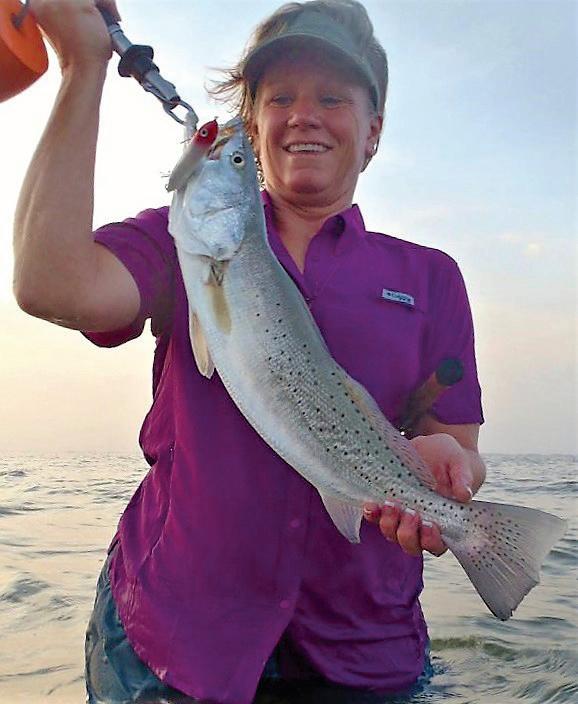
Though both golf and fishing events play out over a span of several hours, the two endeavors differ in a critical way. Golfers attempt to execute the fewest possible shots within a span of four or five hours, making somewhere around 70 100% mental efforts along the way, each of

the efforts starting and ending in a matter of seconds. Anglers make more casts than golfers do shots, but the productivity of their efforts rests less on the quality of the casts they make than on the precision of the presentations they execute.
Each presentation takes considerably more time to unfold than is required to strike a single golf-shot. Angling presentations closely resemble putts executed in super slow motion. Additionally, working lures in subtle ways does not require a 100% vigorous physical effort, the same way hitting putts relies much more on feel and finesse than on power and speed. For these reasons, executing presentations involves more mental than physical components.
As a general rule, anglers benefit from consciously toning down the intensity of their focus and concentration to about 80%, when executing presentations. Just as a track star cannot run a marathon at full speed, an angler cannot focus at full capacity on the vagaries of presentations for hours on end. A golfer should attempt to achieve 100% focus while executing each and every shot, but an angler should operate at some lower level of intensity while executing each presentation.

By doing so, an angler saves gas in the aforementioned tank, fuel which can be used sparingly, and in the precisely right moments, meaning when they recognize some sign indicating the presence of a feeding fish within
 Different types of lures call for different types of presentations; anglers with better focus execute presentations more precisely.
Anglers deploying topwater lures benefit from maintaining eye-contact with the lures while making presentations.
Different types of lures call for different types of presentations; anglers with better focus execute presentations more precisely.
Anglers deploying topwater lures benefit from maintaining eye-contact with the lures while making presentations.
18 | September 2023
Karen Mcleod used a topwater to trick this nice trout on an early-morning summer wading session.


TSFMAG.com | 19
their reach, usually when a fish strikes their lure. An angler deploying a topwater lure will eventually encounter a situation which well illustrates this point. I’ve described it many times before, with spoken words, and in print, and I’ll do so here again. When a fish blows up on a floating plug and misses, an angler’s level of intensity should increase from 80 to 100%.
When they see the fish strike and miss, the angler should instantly channel a bird-dog on point. The first reaction should involve pausing, to allow the lure to bob on the waves and to allow the fish to regroup and potentially strike again. After a second or two, the angler should snap the head of the lure vigorously from side to side by sharply twitching the rod tip, without moving the lure forward over much distance. Then, the angler should pause again, and repeat. Once the lure moves more than three or four feet from the site of the original strike, said angler should reel it in as fast as possible, cast it out just beyond the site and work it right into the strike-zone again, pausing it as close as possible to the point where the attack occurred.

While doing all this, the angler should strive to achieve 100% focus and concentration on the task at hand. An angler who succeeds in urging a fish to strike again and who catches the fish should attempt to maintain their focus level as high as possible while making the next
few presentations. Eventually, they should reduce their intensity of effort back to around 80%, the perfect cruising speed for any athlete or angler consciously acknowledging the impossibility of maintaining 100% levels of exertion over long spans of space or time.
To be clear, optimal cruising speed is not the same as auto-pilot; anglers in auto-pilot generally fall into the trap of mindlessly repeating insanely unproductive movements, and track stars begin simply jogging, exerting efforts somewhere south of 50%. When in autopilot mode, anglers lose their ability to make subtle adjustments to presentations and to react appropriately when something positive happens. But by operating at the 80% level most of the time, anglers can sustain a more mindful state and remain vigilant, ever ready to ramp up their efforts, not to the mythical value of 110%, but to the supremely useful real value of 100%, when the need predictably arises.
KEVIN COCHRAN

T ROUT TRACKER GUIDE SERVICE
Phone 361-688-3714
Email kevincochran404@yahoo.com Web www.captainkevblogs.com
 The Captain describes details related to the catching of his longest trout to date
View The Video Open Camera and hover over QR Code. When link appears at top of screen tap to open in YouTube.
The Captain describes details related to the catching of his longest trout to date
View The Video Open Camera and hover over QR Code. When link appears at top of screen tap to open in YouTube.
CONTACT
Kevin Cochran is a long-time fishing guide at Corpus Christi (Padre Island), TX. Kevin is a speckled trout fanatic and has created several books and dvds on the subject. Kevin’s home waters stretch from Corpus Christi Bay to the Land Cut.
20 | September 2023

Revisiting old techniques and places I haven’t fished in a long time has been paying off.

THE Well-Rounded Angler
Just recently I was thumbing through an article and read an amazing quote by D.H. Lawrence that said, “Never set a child afloat on the flat sea of life with only one sail to catch the wind.” Talk about a deep thought. Pinning your hopes on only one solution sets the stage for the ultimate boom or bust situation, and that is exactly what many anglers do every time they go fishing.
More often than not anglers fall into a routine or rut where they repeat the same pattern, go to the same spots, and use the same techniques because they had success doing it a couple of times, so now it’s all they feel comfortable doing. If you fish enough and do the exact same thing day in and day out, the odds as well as conditions will eventually repeat themselves allowing you to catch fish once again. But what happens when those conditions don’t repeat?
Well, the angler who has no alternate plan often suffers through a less than stellar day while the angler who can adapt to the current situation experiences success. The ability to change with the variables presented each day is what separates consistently successful anglers from all the others.
As a guide, I cannot stress the importance of being well-rounded. It’s critical to your success because of the ever-changing clientele you encounter. Each morning brings a potentially different style of fisherman to my boat and it’s my job to do whatever I can, within reason, to make their day on the water as enjoyable as possible.
STORY BY CHUCK UZZLE
Sometimes that might mean I have to adapt or alter a technique in order to accomplish the desired goal due to the anglers skill level. Not everyone who gets on my boat is a seasoned angler who is ready to jump over the side and wade while throwing topwater plugs all day. Although I do get my fair share of hardcore fishermen, I also get those who are new to the sport and just want to learn in order to get better. These folks are some of the most enjoyable to fish with because they are open to new techniques and different options.
So, for me, it’s very possible to go from one end of the spectrum to the other on a day to day basis, which means I have to be wellrounded enough to handle a variety of situations. It’s this process that allows me to enjoy so many different styles of fishing and also in some ways keeps things from getting stale or boring on the boat.
About a year or so ago I was having a conversation with my good friend Johnny Cormier, who is one of the best fishermen I have ever been around, about how we have evolved or changed the way fish here on Sabine. We both couldn’t think of a good answer as to why we got away from doing some of the things we did for years that were tried and true fish producing patterns and techniques.
Sure, some of it was weather or storm related as we were forced to deal with some never-before-seen flooding and freezes, but for some unknown reason we just got away from things that worked for us for years. It was at that time I decided I was going to go back to doing some of those things and see if they still worked, see if they still helped
TSFMAG.com | 23
me catch fish, and much to my surprise they did just exactly that. Part of my desire in going back and adding these older techniques to my everyday playbook was the fact that each time I step foot in my boat I cannot help but think about my mentor Dickie Colburn and all the things he taught me. I get a very special feeling when I go back and catch fish in a place that we once fished together and that makes my trips even more enjoyable. Going back to these areas and fishing the way we once did has been like a shot in the arm for me, a sense of rediscovery, so to speak, that opens up so many great options.
So far we’ve talked a lot about being well-rounded and different styles of fishing, but I haven’t been very specific. Despite what some may think, there are way more folks who just want to get a bite than there are who go out in search of trophy fish. If you are one of those folks who do nothing but chase trophy fish and that’s all you are interested in, that’s great, more power to you and I wish you all the success in the world. If you are just an average weekend angler who likes to have their string stretched regardless of species, then this is for you.
In order to maximize your success on the water it’s necessary to become flexible and proficient in several areas or techniques. Reading the conditions of the water, knowing how tides affect your area, being willing to use a variety of baits including both live and artificial, are tops on the list.
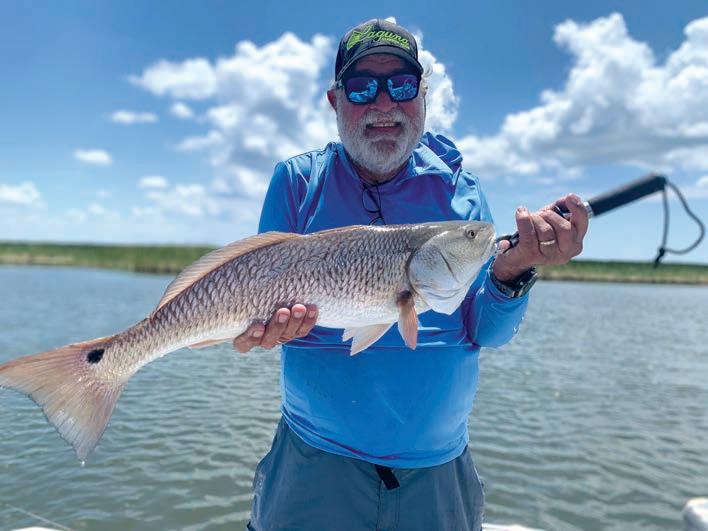
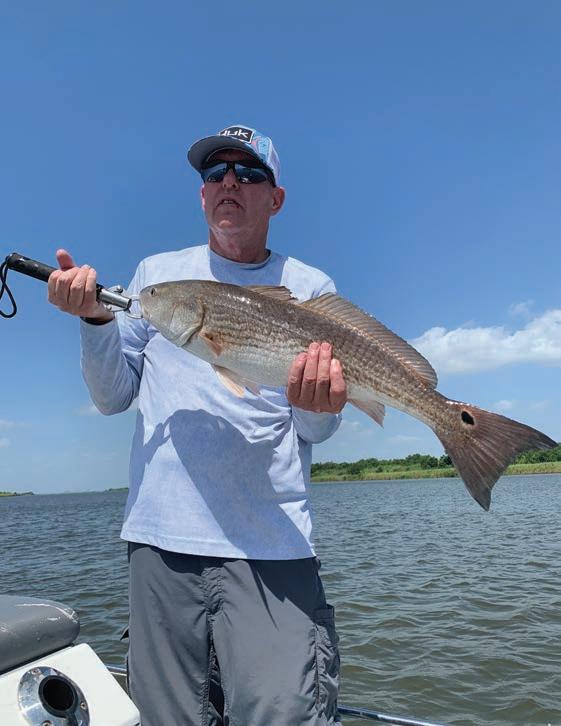

Well-rounded and then some…who’d ever thought to dangle a ZMan plastic under a 4-Horsemen cork to catch grouper from the rocks down in the waters of the Mexico Baja Peninsula?
Reading the conditions and knowing the tides goes without saying, they are a given in the fishing equation. Lure or bait choices on the other hand take a little more time to figure out. If you have a particular style of fishing that you are not good at, take the initiative to learn how to do it better, don’t just keep fishing with a lure or technique that you are comfortable with when there are better options out there.
Neal Frazer with a beautiful slot redfish that ate a live shad.
24 | September 2023
Charlie McDowell with a solid summer redfish.
Learn to throw a cast net, and learn how to properly rig live bait. Learn how to keep your bait alive and, most importantly, learn where and when to use it. Become willing to change your approach when things are slow and don’t be afraid to try new things. The worst thing in the world is a stubborn angler.

One more thing on the subject of being a well-rounded angler, and that’s not being afraid to experiment with a new technique. I thoroughly enjoy talking to anglers from other places and hearing how they fish in certain situations. I have picked up many great tips like this that have helped me out many times over the years. It’s also very cool to bring a technique and share it with others when I travel as well.
I’ve spent a great deal of time in Mexico on the Baja peninsula and I’m always trying out lures or techniques that I use here at home. On a recent trip I hit it big with one of our favorite ways to fish and that’s using a rattling cork with a soft plastic. My buddies who live down there were amazed at how well it worked and couldn’t wait to try it out on some other species.
I got tired of catching fish from the beach as all sorts of species would readily eat the soft plastics as they hovered just above the big
rocks along the reefs. It was a tug of war to get some of those better fish out of the rocks, but more often than not I was able to land them all the while grinning from ear to ear, knowing I was catching fish in a place using a technique that probably nobody ever had tried or even heard of before and that was very satisfying.
I guess the point to all of this is to stress the fact that being wellrounded as an angler will do nothing but help you catch more fish and become a better angler. By learning different methods and being willing to try those methods you increase your odds exponentially for success on the water. Keep an open mind and learn as much as you can because it can and will pay dividends in the future. As always, enjoy your time on the water and don’t forget to take a kid fishing whenever you can.
CHUCK UZZLE
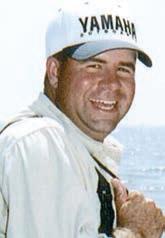
Phone 409-697-6111
Email wakesndrakes@yahoo.com
Website wakesndrakes.com

CONTACT
Chuck fishes Sabine and Calcasieu Lakes from his home in Orange, TX. His specialties are light tackle and fly fishing for trout, reds, and flounder.
View The Video
TSFMAG.com | 25
Open Camera and hover over QR Code. When link appears at top of screen tap to open in YouTube.
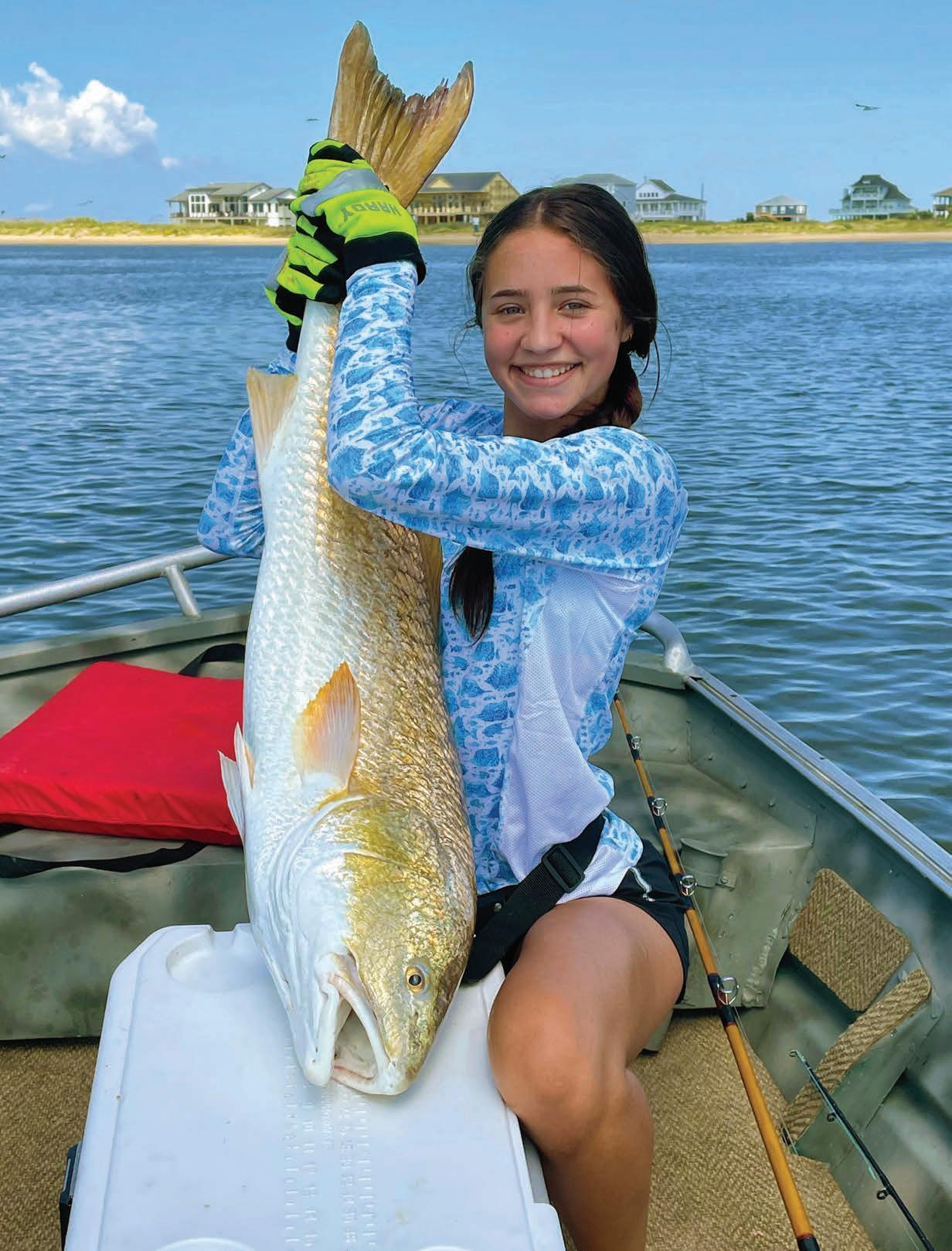 Typical bull redfish landed off Crystal Beach.
Typical bull redfish landed off Crystal Beach.
BULLChumming REDS
STORY BY JOE RICHARD
With bull redfish season in full swing, anglers will be seeking these brutes along various beaches and fish passes along the coast. One of these guys will be fishing just off the beach or in jetty pockets in only 8-10 feet of water, after perfecting a method for attracting those big fish. Mike Spencer of Port Arthur has built a PVC chum pipe that is dragged on the bottom and used to attract greedy reds from near and far. Stuffed with the best of all chum (chopped menhaden) along with an optional mix of “pogey oil” from tackle stores or found on the internet, the pipe emits a powerful odor and impressive slick on the water.
He’s discovered that big reds are fun to catch in only 8-10 feet of water, when hooked close to the boat. Using 40-pound tackle, they don’t play these reds for too long, or wear them out; the fish are released in good shape. I suppose one could be caught with 12-pound line or even lighter tackle, except during a prolonged fight, the cruel “gray-fin express” may be lurking nearby, ready to make mischief. Or collect his dues.
Which is why Spencer’s chum pipe is designed to be pretty much shark-bite proof and weighted with a little lead. They drift the boat and set the pipe out on the upwind or upcurrent side, then stack 2-3 weighted baits (mullet, menhaden, pinfish) around the pipe and wait. The rods can be held or set in holders. Big circle hooks practically insure those 40-inch reds are lip-hooked and you won’t even have to set the hook. Set your drink down, walk over and wrench that bent rod out of the holder. If you can.
With today’s plentiful coastal sharks, they’ve been lucky so far that a big one hasn’t inhaled the chum pipe and bit off the sturdy rope. Something a big tiger or bull shark would be capable of. Twice, Spencer has had big bull sharks attack his hooked, five-foot blacktip sharks off the beach; they were both hit right at the gills. There’s an old tale that shark heads make other sharks uneasy, and that’s why they won’t eat an entire, smaller shark. If Spencer’s chum tube is ever bitten off, he will probably switch to cable in the future.
TSFMAG.com | 27
They use their chum tube at different venues such as the jetties, under piers or while anchored in salty bayous, as long as there is current. Otherwise, the scent won ’t travel and attract gamefish. At the Galveston jetties, he’s had several big trout approach his chum tube on the surface, before darting off. You need calm Gulf water, for a day like that.

(As I write this on June 23, they tell me the wind has been blowing for 43 consecutive days off Port Arthur, before a light north wind calmed things down. Mix that with the complete draining of Dam B into the Neches River, and it’ s turned Sabine Lake fresh. With another LNG refinery going up near Sabine Pass, and miles of backed-up plant worker traffic early and late each day, local fishermen have turned to other pursuits until things settle down).
Chumming isn’t new. We used to chum tarpon and reds in Pass Cavallo, usually at night when we camped out in my boat, a 23-foot SeaCraft with a low cabin. (A boat
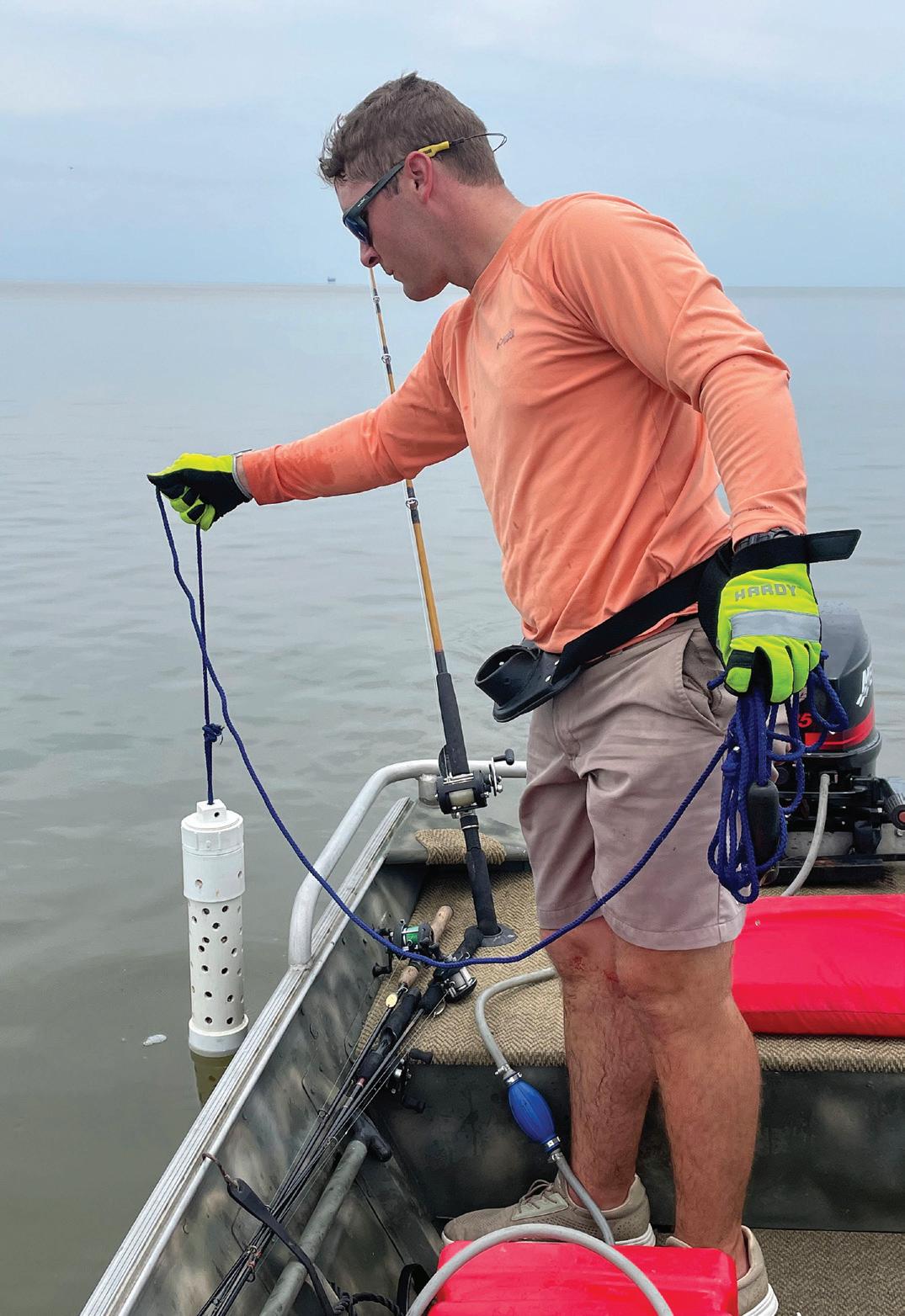
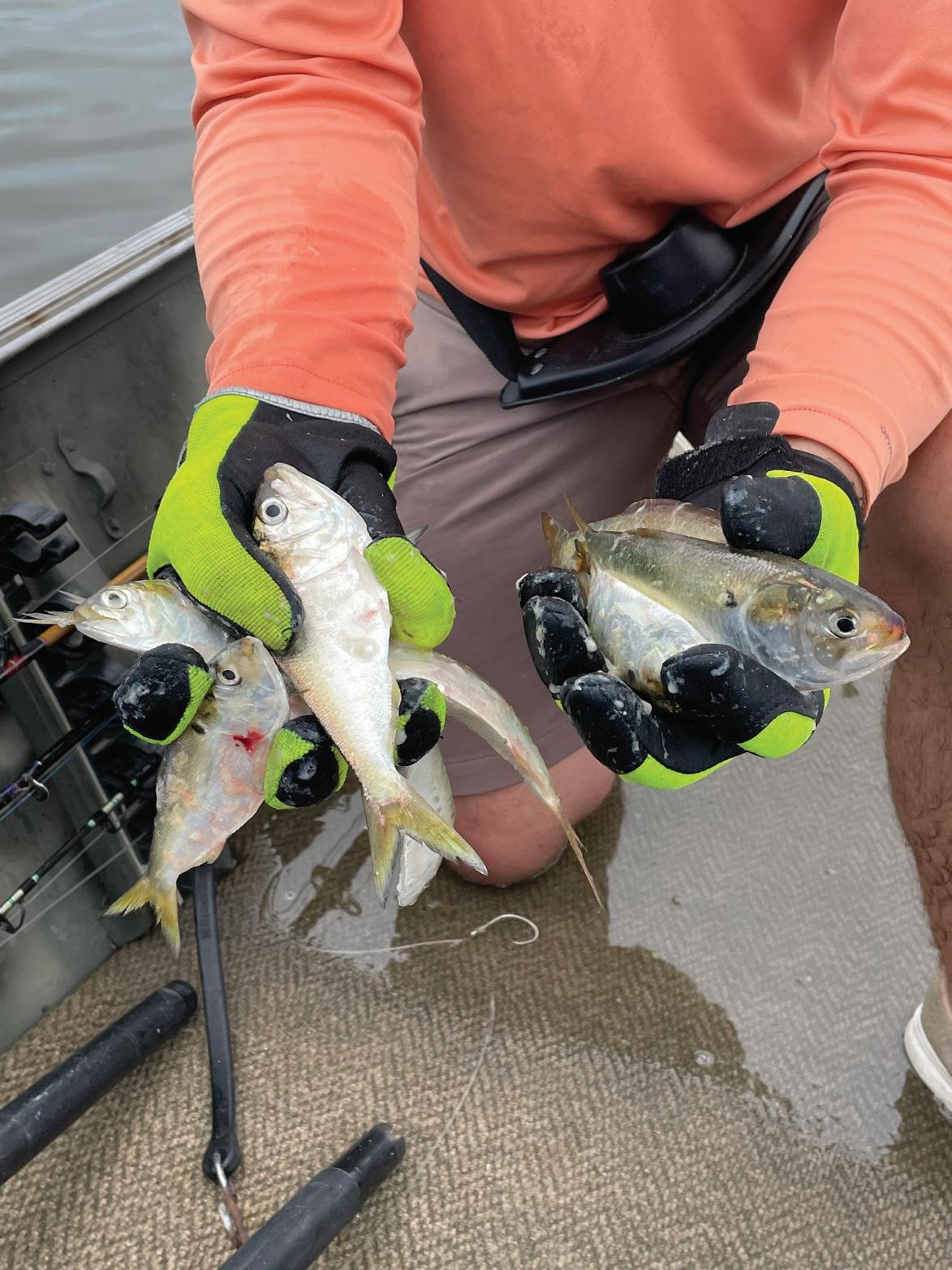
I never should have sold). We must have been mad at the fish back then, staying out there all night instead of heading back to town at sunset for happy hour like everyone else. For a chum bag we used an onion or citrus mesh bag glommed from the local grocery, filling it with slightly-ripe shrimpboat cull and weighed down with a red brick. The sack was held by sturdy 300-pound mono line that the current wouldn’t grab and pull on. There was enough smell down there to call up all sorts of monsters, and one night it happened.
We’d had considerable action with bull reds and a tarpon. It was late, so we stowed the tackle and tried to sleep. Then I heard this groaning sound and the boat seemed to tilt slightly. I got up, tried to grab the line but couldn’t pull it off the gunnel, it was tight as a bow string. I backed away and watched that heavy leader surge this way and that. Finally, pow! Something big really wanted that bag. It may have swallowed it brick and all. (Good luck later on, passing that brick). We slept uneasy the rest of
Homemade PVC chum tube with drilled holes.
Pogey (menhaden) fresh from the castnet, perfect chum.
28 | September 2023
Once filled with pogey, the chum pipe is lowered overboard.
that night, knowing there was only thin fiberglass between us and something huge and loathsome only 20 feet below. Jimmy Crouch’ s rustic rental trailer back in POC suddenly seemed a lot nicer place to sleep. After a long night spent out there in calm but chilly October fog, the coffee and breakfast at Josie’s diner was heaven-sent.
One recent challenge with chumming is actually finding pogies for sale. The net boats from Louisiana are mostly gone from Texas waters, which is a good thing but it has a downside. Where to find them?
Sabine Pass once had its own pogey plant back in the day, and with a SSW wind we could smell it across the lake in Port Arthur. Fifty-pound wooden boxes of menhaden were cheap, something like $20 even in the 1980s, used for partyboat bait, chumming offshore or crab traps. Thousands of tons were unloaded at the plant in Cameron, La. where I heard they gave away boxes. You could say we were raised on pogies. Today they’re hard to find except off the beach, using a castnet in calm summer weather. They can be used fresh or frozen for future trips; they’re the best of all chum because of their strong smell.

A word of caution when fishing with chum: Be sure to bring fish towels on such a trip. You don’t want to be washing your hands over the side, even for a moment. Earlier this summer a young guy fishing near the remote village of Flamingo in far South Florida did just that, after being warned not to. Washing his hands after catching a snook, his last words were, “Two seconds won’t hurt.” Wham! A six-foot shark came out of the water, grabbed his hand in an instant, yanking him overboard. (The video can be found on YouTube.) It appeared to be a lemon shark with thin needle teeth, instead of a Texas-raised blacktip shark with triangular, chopping teeth.
The angler got back in the boat real quick with the help of his buddies. He even used his shark-bit hand to climb aboard, so the damage may have been fairly light. Although he was life-flighted to the nearest hospital, so there’s that. If you combine shark bite with hedge-fund owned air ambulance service, you’re looking at an expensive day. Including surgery that will hopefully restore full use of that hand. It’s the smallest things that can make a difference on the water, like forgetting a simple fish rag or two.
So, be careful when chumming out there. Don’t stick your feet in the water to cool them off, because almost anything may show up for the party.
JOE RICHARD
Joe Richard has fished the Gulf since 1967, starting out of Port Arthur, but his adventures have taken him up and down the entire coast. He was the editor of Tide magazine for eight years, and later Florida Sportsman’s book and assistant magazine editor. He began guiding out of Port O’Connor in 1994. His specialty is big kingfish, and his latest book is The Kingfish Bible, New Revelations. Available at Seafavorites.com
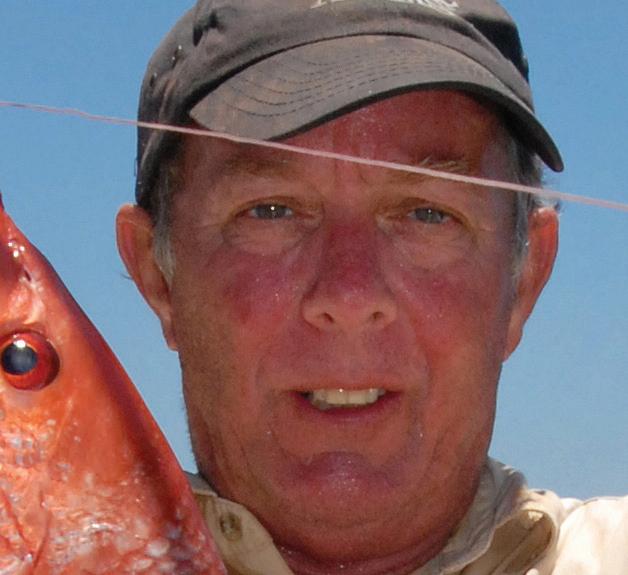
CONTACT
TSFMAG.com | 29
Fact or Fiction
Dispelling Myths About Barotrauma, Venting, & Descending
STORY BY NICHOLAS HADDAD
Sustainable Fisheries Communications Manager | Florida Sea Grant, University of Florida
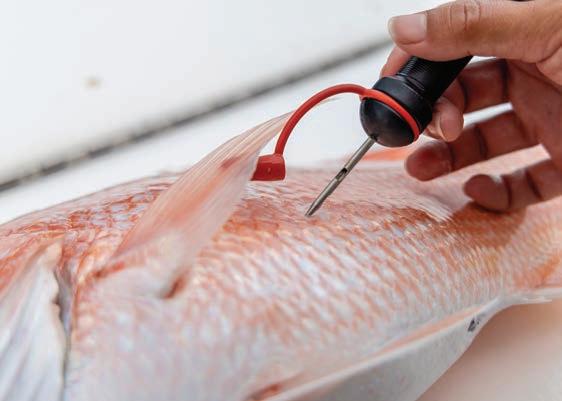
New regulations for venting and descending reef fish have sparked conversation and controversy across the Gulf of Mexico. From Facebook fishing groups to online forums and on-the-water fodder, everyone seems to be an expert when it comes to releasing fish. With opinions circulating faster than a frigate diving for food, it’s important to get the facts straight so we can do our best to help fish survive release. Let’s dive right into some of the common myths about barotrauma, venting and descending.
Myth 1: Just pop the swim bladder sticking out of the mouth. This prevalent misunderstanding about barotrauma has circulated for years. Most fishermen are aware that reef fish have a swim bladder that expands when reeled to the surface from depth. Many assume the organ sticking out of the mouth of a fish is the inflated swim bladder, but in reality, the swim bladder expands internally and pushes the stomach out of the mouth of the fish. This is known as stomach eversion. Anglers may see some stomach contents expelled upon ascent or near the mouth of the fish when stomach eversion occurs. Another example is when a snapper bites their own everted stomach “deflating” it, yet there is still air in the body cavity from the swim bladder expanding. You never want to pop the stomach coming out of the mouth as it can do more harm than good for the fish and doesn’t successfully release the gases in the body cavity.
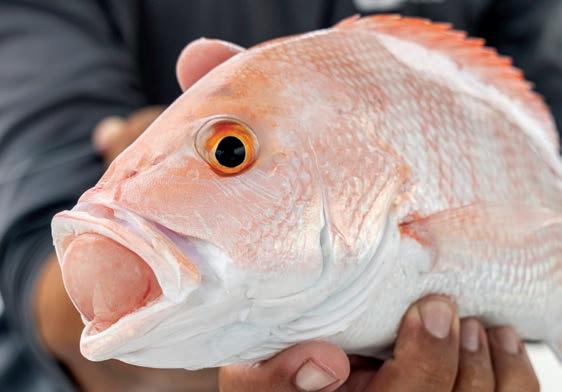
Moral of the Story: If you choose to vent fish (although descending is preferred under most scenarios), ensure you are venting the correct spot behind the pectoral fin!
Myth 2: Descending devices spoon-feed sharks and dolphins. This argument primarily arises from anglers having their catch eaten while fighting it to the surface, commonly referred to as depredation. If you are an avid offshore angler, more likely than not you’ve reeled up a half of a fish before. The simple truth is that a fish being descended acts nothing like a fish fighting for its life on the way up. Sharks are attracted to the vibrations and struggle of a fish fighting to survive and get off the hook. Spearfishermen are aware of this as you are more likely to have your fish eaten by a predator when it is struggling on the shaft rather than when you gain control of the fish.
If the subjective evidence isn’t enough for you, let’s look at some data:
- Runde et al. (2022) examined depredation on descending devices off the coast of North Carolina by descending fish in capture depths of 24 to 244 meters. Of 1,176 non-videoed descents, zero descending devices were lost to predators. Of 114 videoed descents, predators were observed seven times with zero instances of depredation observed.
o https://afspubs.onlinelibrary.wiley.com/doi/ pdf/10.1002/nafm.10815
30 | September 2023
- Researchers from Mississippi-Alabama Sea Grant are teaming up with charter captains across the Gulf of Mexico to examine depredation of descended reef fish with GoFishCams attached to the line. Through one season of data collection, seven captains descended 464 fish with an average capture depth of 114 feet. The team examined the video footage and found one instance of depredation by a shark, one predation event after release by a dolphin and the rest were successful releases, including a few with predators in the frame. These results are preliminary as the study is ongoing.
o https://masgc.org/news/article/depredation-on-descender-devices-an-update
You’d be naïve to say that sharks, barracudas, dolphins, or other predators will never eat descended fish, but it’s much rarer than on ascent and not a reason to dismiss descending devices. If the sharks are fired up under your boat, you’re unlikely to get a fish to the surface anyway and moving spots is the best course of action. Dealing with predators is one issue while barotrauma and discard mortality is an entirely separate issue.
Moral of the Story: Letting a fish float off on the surface is spoon-feeding predators and a vented fish still has to swim wounded and tired past predators to the bottom to survive. Don’t knock descending devices until you give them a shot!
Myth 3: That fish is dead anyway.
Our last myth comes from the gruesome image of a fish fully blown up from barotrauma. When anglers see the eyes bulging out of the head or the stomach protruding from the mouth of a fish, they often think it has zero chance of surviving release. In reality, a fish that looks lifeless at the surface often has a great chance to survive release to grow, spawn and contribute to the future of the stock.

Let’s look at three lines of evidence that debunk this myth:
1) Video Releases: Underwater videos attached to fishing line have been used for years to determine what happens while fish are being descended. In many instances, you can see the fish recompress as it’s being descended and seemingly come back to life. Return ‘Em Right is a great resource to see some of these videos.
2) Acoustic Telemetry Studies: Researchers will often tag fish with transmitters that track their movements after release. By examining these movements, they can document long-term survival of fish suffering from barotrauma.
a. Runde et al. (2021) tagged 44 red snapper with electronic transmitters, monitored their movements and found 87% of red snapper survived release when caught and descended in roughly 120 feet of water off North Carolina.
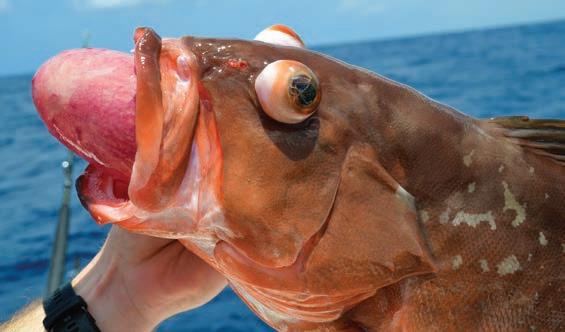
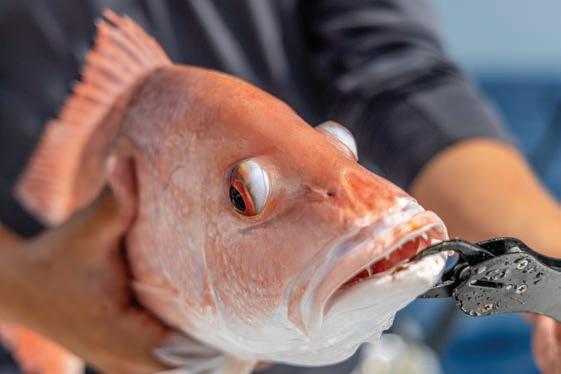
i. https://afspubs.onlinelibrary.wiley.com/ doi/10.1002/mcf2.10175
b. Wegner et al. (2021) used acoustic telemetry to evaluate long-term survival of rockfish off California and found “… that physoclistous fishes captured at depths up to ~180 meters (590 feet) and experiencing extreme barotrauma can survive if properly released using a descending device, and that increased capture depth for such deeper-dwelling species does not necessarily increase mortality.”
i. https://academic.oup.com/icesjms/article/78/9/3230/6378054
Continued on page 51... TSFMAG.com | 31
LESSONS LEARNED DURING A LIFETIME OF FISHING OYSTER REEFS
This month we are going to talk about wade fishing oyster reefs. First, hats off to TPWD and the coalition of conservation organizations responsible for the restoration efforts and new laws that now protect many of the reefs in San Antonio, Mesquite and Aransas bays. I grew up fishing reefs; a neighbor who owned a small skiff took me and my dad fishing occasionally and we typically fished reefs in Copano and St. Charles. I remember him saying that if the mullet were up on top of the reef the trout had them pushed up there. This was reinforced by a couple of guys I fished with during my high school years.
The late Robert Brooks and I waded these same reefs early in my career with MirrOlures on cold winter days. We would unscrew the eyelet and place it in the nose, filling the top hole with clear fingernail polish. We wanted the lure to swim and shine more side-to-side versus digging down in the water column. Both ways were very productive. Easy to catch ‘em when there are literally thousands of them. If I showed you the photos of the trout we caught you might still not believe the size. Robert passed a month back so those memories of us fishing together have become even more precious.

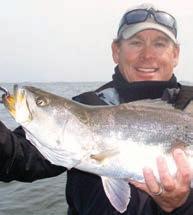
Reef fishing was probably at the core of my beginning as a fisherman. My dad and I waded a lot from the banks,
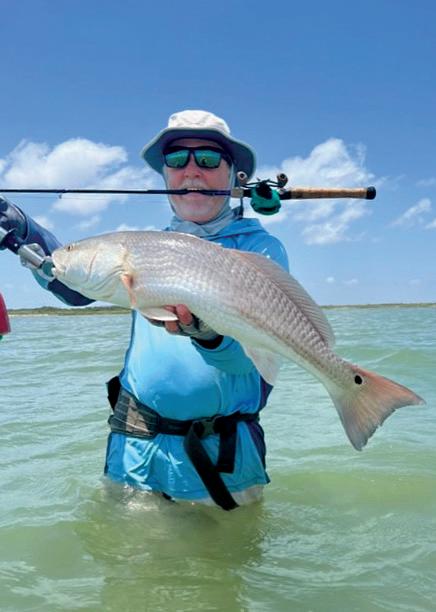
fishing shallow grass and sand, but back then I’m not sure whether we even realized the importance of bottom structure. We just fished wherever we could get in the water and start casting.
During the summer months, when water temperatures are higher than normal and winds are typically lighter than normal, it is possible to fish the more open waters where many of the reefs in middle coast bays are located. If you are familiar with reefs, you are likely aware that many of them lie in a half-moon shape. Seems every bay system has a Half-Moon reef. This shape is created largely by predominant SE wind.
There are also some unique names out there. Some in our area that I like are Grandma’s, Chicken Foot, Panther, Magnum, Lap, Newcomb’s, Shell Banks, 40 Acre, Mullet’s Toe Head, Rattlesnake, Oyster Claim, and Scotch Tom. All the names have stories and are worth a listen if you’re ever lucky to engage a knowledgeable old salt on the subject.
I personally prefer smaller reefs with well-defined crowns that transition to a scattering of clump shell. There are not many left with these features but those that do continue to be productive most any day the weather allows us to fish them. By having three well
JAY WATKINS ASK THE PRO
Matt Lund with a very nice summertime trout – CPR.
32 | September 2023
Redfish are fun all year long, just ask James Stonecipher.

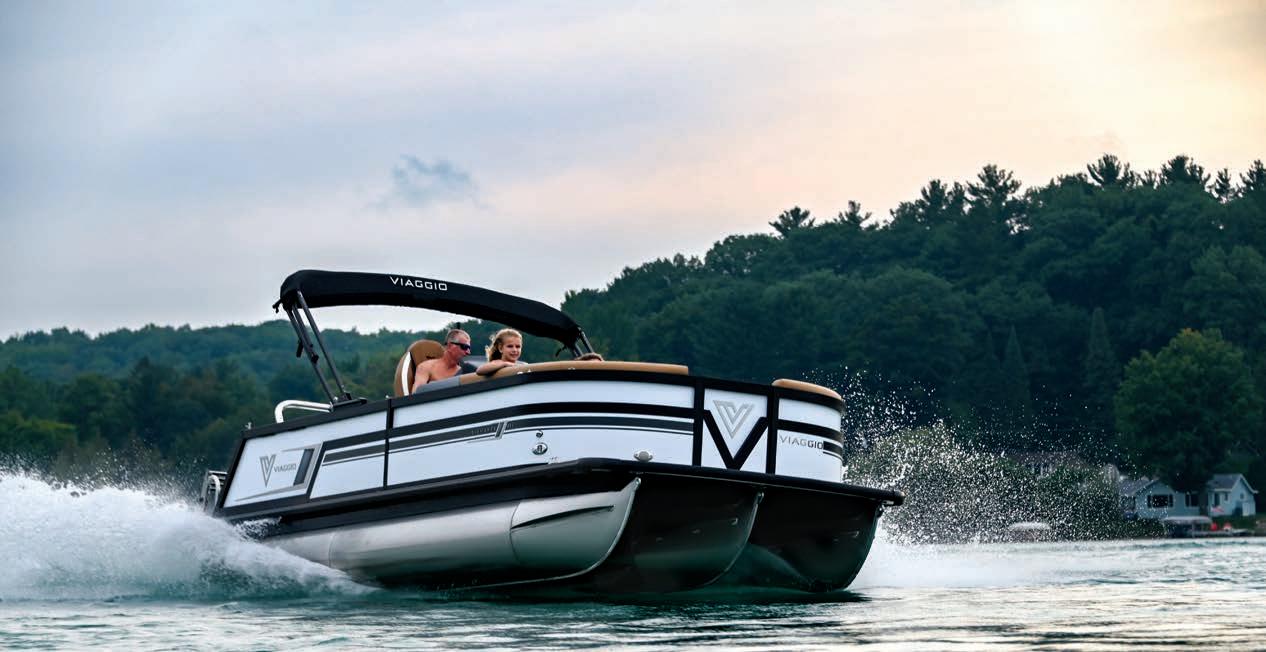
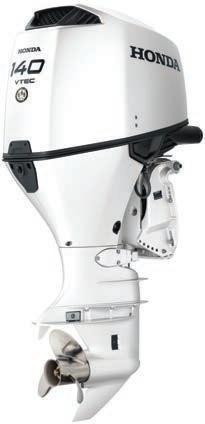
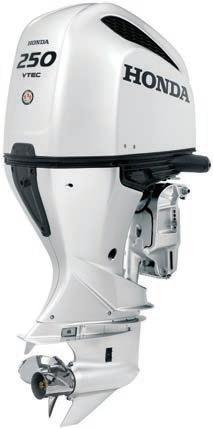

TSFMAG.com | 33 Viaggio’s Diamante Series stands alone in the market as the most luxurious and well-built pontoon boat available! With our exclusive Matte Metallic finish and heavy 3” rail system, the Diamante is built to last and turn heads every time you hit the water. [dee-a-mont-eh] (noun), Italian for Diamond Boat Dockter 7650 PARK ROAD 4 WEST BURNET, TX 78611 Now Open 2nd Location! 525 FM 1431 KINGSLAND, TX 78639 512-756-5000 boatdockter1@gmail.com boatdockter.com Boat Dockter For optimum performance and safety, read the Owner's Manual before operating your Honda Marine Product. Always wear a personal flotation device while boating. -OR- Always wear a personal flotation device while boating and read your owner's manual.
defined structural elements within one specific structure, we now have areas on the reef that fish can use throughout the day as conditions change. More choices in bottom contour usually equates to more opportunities for a predator, this I believe is a key to our success many days. Anglers still need to become knowledgeable of these features and the only true way to do this is to walk it. I have to say that my wading boots have touched just about every inch of shell along the Middle Texas Coast. Speaking of which, I have found no wading boots of any brand that hold up very long on live oyster reefs.
Reefs are singular structures for the most part, and concentrate both bait and game fish, making them highly productive at times. I also prefer to find reefs that have moving water during periods when tides are moving. In this case I am looking to the points of the reef as well as any deeper portion that will allow water current to pass through or across the crown. I have several small reefs that I use only in these situations and from the very beginning of my career to the current (no pun intended) they produce for me during periods of tide movement.
The opening of Cedar Bayou has restored some much-needed movement to many of the reefs in the Mesquite, San Antonio and Aransas Bay areas. In all cases, I am still looking for bait fish activity around the reef structures just as I would on any other type of bottom structure. It still seems to be true that when the mullet are stacked on top of the reef, trout or redfish can be found somewhere around the perimeter.
Here is a bullet-point version of my thoughts on how anglers should approach and fish a shallow reef:
-First, I slow my boat, reverse the engine to slow the drift, then cut my engine and drift in. Try to ease the Power Poles or anchor down as quietly as possible. The sound of an anchor or Power Pole dragging bottom is notification to the reef’s residents that they have visitors.
-I like to stand off the shell on sand whenever possible and ease along parallel to the targeted area. I refer to walking on shell as “crunching them off” and I’m a firm believer that it does just that.
-I try to position my anglers where we can all cast at a slight angle to the reef edges and points. Moving slowly, stopping and making multiple casts, is an absolute must if the best results are to be achieved.
-If your lure gets hung on shell, DO NOT walk forward to free it, just break it off. Losing a lure now and then is a hazard of the sport. If you only brought one of your favorite lures, then that was your first mistake.
-When working reefs that present opportunity to fish moving water, anglers would be advised to position themselves where the current is most likely to stack the bait, because that’s where the predators will congregate. I have a ton of small areas like this within our reef systems where I feel confident we will catch at least a few every visit.
-Success hinges on our ability to place ourselves in such areas during peak tidal movements. But remember this, wind also moves water. Keep this in mind when your fishing schedule does not align with tide movement.
-I like reefs that have scattered clump shell along the tips and edges of the main reef. On some clumps you will notice a type of algae that looks like grass. I love this combination. You need quality glasses to see it, though. I use Smith Optics and have found them to be of excellent quality and they seem to hold up very well.
-Through quality polarized lenses, the reef will have three distinct colors. Sandy areas will appear light green, oyster shell often appears somewhat rust-colored, and scattered clumps of shell with grass (algae) appear almost black.
-Standing clump shell is tailormade for wintertime with slow-sinking and suspending lures – Texas Customs Double D, Custom Corky Fat Boy, and MirrOdine XL. I call my presentation the “swim and stick.” Swim the lure over the structure with some erratic twitches and then dead stick it to allow it to briefly fall into the small pockets of sand or flat shell between clumps. The action is deadly when performed properly.
-As I mentioned earlier, to qualify for our consideration, a reef must have bait present and some water movement. Yesterday we fished a very typical reef in the Aransas complex. Tides were low and the water was very hot. The wind was light SW and we had an incoming tide.
-You should always construct a game plan based on seasonal patterns as well as weather and water conditions. I knew of an area where the wind velocity and direction would be favorable for an early morning wade. As we approached the reef we noticed three small slicks drifting off the northern tip of its half-moon shape. Many would have likely motored closer to the sweet spot and just went right to catching them. Honestly, that is not the proper approach if you are wanting
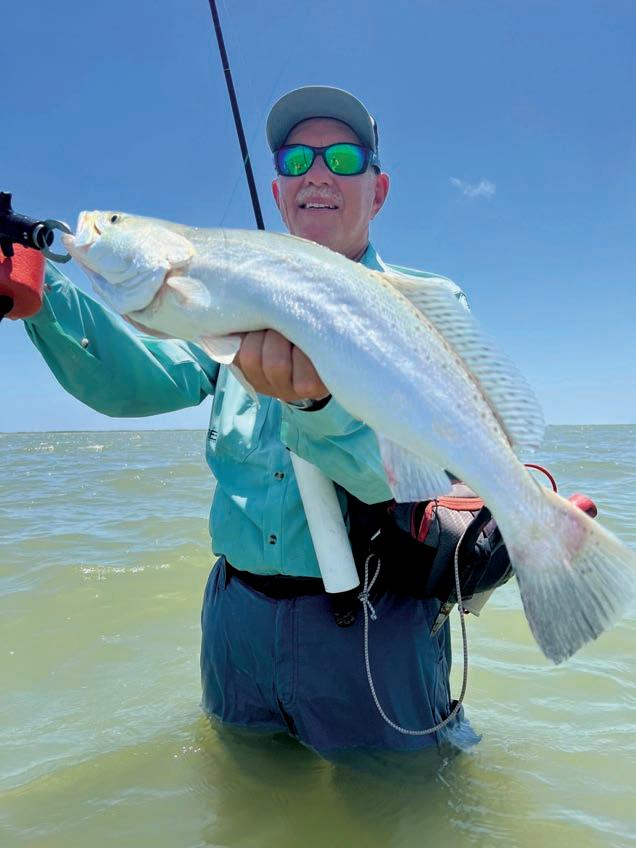
34 | September 2023
Lloyd (Corky) Warrington scored with an excellent summertime speck – CPR.
to experience the best the reef can provide.

-We dropped the Power Poles about a hundred yards away and got out in waist-deep water over sand bottom. A quiet deployment is critical as much as the area will allow. Bait was stacked along the up-current side and I gave instructions to position offshore and cast to the bait line, which was also where the reef began to break down into clump shell and the water became deeper.
-Bites did not come quickly. As we eased along we continued to see small slicks popping from a couple locations on that northern tip. We started catching fish as soon as we worked our way into casting range. Not big trout, just slot-sized fish to maybe 20-inches.
-One of the toughest things to teach anglers is the importance of STOPPING and continuing to work the area where the very first bite was received. I absolutely can’t stand waders that persist in walking through the fish. Just because you haven’t received a bite while your buddies have does not mean there are no fish in front of you. On fixed structures such a reef, we must allow the area that is holding fish to reload as we pull fish from it. This is especially true when dealing with moving water situations.
-Watch the birds that are feeding on the reef in the area where you are catching fish, if any are present. We had a royal tern working that small pocket on this day. Many times, I focus on finding gulls or pelicans working small pockets or areas of moving water around the reefs.
-Have you ever watched a brown pelican idling in the current just off a small reef? Paddling with their feet enables them to remain in one spot despite the current. It is amazing how they can hold position –nature’s version of “spot lock.”
There are numerous lure types that will work when fishing reefs. You should use the lures that you have the most confidence in to start the day. I always have plenty of MirrOlure Lil Johns in my box along with a few Double D series. When large bait fish are strung out along the edge of a reef I usually tie on a Double D. I can literally bang in down into the bait, and then dead stick it, allowing it to suspend and float into the pod of bait. It’s a basic swim and stick retrieve and easy to master. Sounds like a great tip to discuss on Instagram account: official_jaywatkinssrfishing.
May your fishing always be catching. -Guide Jay Watkins
Jay Watkins has been a full-time fishing guide at Rockport, TX, for more than 20 years. Jay specializes in wading yearround for trout and redfish with artificial lures. Jay covers the Texas coast from San Antonio Bay to Corpus Christi Bay.
Telephone 361-729-9596
Email Jay@jaywatkins.com
Website www.jaywatkins.com
 View The Video Open Camera and hover over QR Code. When link appears at top of screen tap to open in YouTube.
View The Video Open Camera and hover over QR Code. When link appears at top of screen tap to open in YouTube.
CONTACT
TSFMAG.com | 35
By Joel Anderson (Facility Manager, Perry R. Bass Research Station) and Jillian Swinford (Natural Resource Specialist, Perry R. Bass Research Station)

FIELD NOTES
FROM SEA TO STREAM: TRACKING THE ELUSIVE AMERICAN EEL AS IT SLITHERS FROM TEXAS’ ESTUARIES INTO ITS RIVERS
The American Eel (scientific name Anguilla rostrata) is a species of eel that is found throughout the eastern part of North America, inhabiting coastal streams and rivers from as far north as Canada, to as far south as northern Mexico. Texas is located squarely in that range, and adult American Eels can be found in many of the freshwater habitats of Texas, including rivers and reservoirs. It isn’t a species that is easily observed; adult eels are bottom dwellers that are most active at night, and for this reason they are unlikely to be encountered by recreational anglers very often. However, thanks to Texas Parks and Wildlife Department’s Inland Fisheries Division, adult eels have been caught using a variety of scientific fishing gears meant to target and detect the species directly (Figure 1).
American Eels have a biology that is unlike any other species of fish. They are “catadromous”, meaning that they spawn in saltwater, and thereafter juveniles migrate
on currents into coastal and freshwater habitats. There are several species of catadromous fishes in the world, but American Eels take the practice to its extreme: every individual of the species is born in a single location, the Sargasso Sea, which is a large oceanic gyre located off the Atlantic Coast of North America near Bermuda. So, all of the eels that enter coastal inlets across the North American continent (including Texas’s estuaries) start out in the middle of the Atlantic Ocean, spawned at the same time and in the same place. But beyond that, not much at all is known about the pathways they take to get to Texas, or even when they arrive.
Throughout most of the known range of the species on the Atlantic Coast, large migrations of juvenile eels (also called “glass eels” due to the fact that their bodies are devoid of pigment at the earliest stages), have been documented occurring in late winter through early summer. These glass eel runs on the east coast are so
36 | September 2023
Figure 2. An eel ramp set up on the Tres Palacios River near Markham, TX, with the lid of the ramp opened for display purposes. American eels crawl up the ramp in an effort to get up stream and are washed into the blue collection bucket.
numerous that in a handful of the Atlantic states they support a commercial fishery driven by high demand from international markets. In contrast, virtually nothing is known about the arrival of juvenile American Eels in Texas, or even in the greater Gulf of Mexico. None have ever been observed in Texas’ estuaries, nor have glass eels ever been reported from Texas’ rivers. That is, until now.
To address this knowledge gap, researchers from the Environmental Institute of Houston (located at the University of HoustonClear Lake, hereafter UHCL) recently headed up a collaborative study aimed at documenting the arrival of juvenile American Eels in Texas. The collaborative team included biologists from UHCL, the Inland Fisheries and Coastal Fisheries divisions within TPWD, as well as biologists at the Lower Colorado River Authority (LCRA). The team set up Irish eel ramps in lower river reaches of 9 rivers and streams across coastal Texas, from Victoria to Port Arthur. Irish eel ramps are a sampling gear that specifically target migrating juvenile eels, and they are usually set up in sections of the river where there is a dramatic change in elevation, such as near dams, culverts, or natural elevation changes. Juvenile eels have a remarkable ability to climb over most obstacles they find in rivers, so long as water is present, so the ramps provide an alternative and easy migration route. The ramps use the force of a gravity fed siphon flow to push the eels into a partially submerged collection bucket that is located next to the ramp (Figure 2). In addition to the ramps, the team collected water samples at ramp sites to detect “cellular” clues from juvenile eels that might be floating in the water column. These cellular clues refer to the DNA that fish (and all organisms) shed in water naturally as they pass through an area. This technique is referred to as “environmental DNA detection” and has been used successfully to monitor the presence of eels on the east coast without seeing the eels themselves.
Both methods paid off. In May of 2022, a late-stage juvenile American Eel (also called an “elver”) was observed in a ramp in the Colorado River near the Bay City dam. Then in January of 2023, the first two glass eels ever observed in Texas were found in an eel ramp in Lynn Bayou, Port Lavaca, less than ½ a mile from the mouth of the bayou in Lavaca Bay (Figure 3). An additional 17 glass eels and 5 elvers were caught in subsequent weeks of the study. Although eels were not
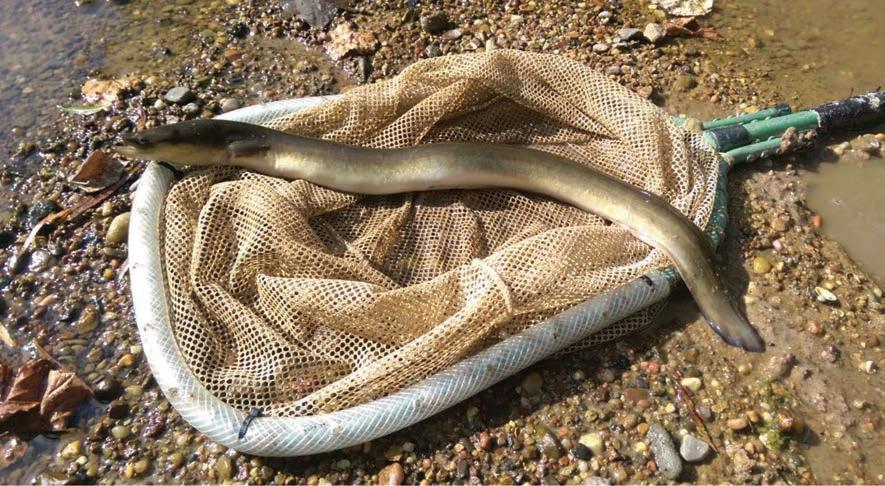
observed in every eel ramp in the study, their DNA was. DNA detection of American Eels was made at every ramp site at least once, with the bulk of detections occurring in winter and early spring, which lines up with when juvenile eels are usually detected on the east coast.
Using these innovative sampling methods, the team was able to fill in an important knowledge gap related to the “when” and “where” American Eels traverse Texas’ estuaries and enter the rivers (Figure 3). These types of data can be used for planning more conservationminded infrastructure along river pathways that can benefit migration of juvenile eels as they make their way upriver. For instance, the LCRA biologists that partnered on the study are now using what they know about juvenile American Eel migration to brainstorm innovative solutions to improve migration for the species. The knowledge gained through the study will also be used to paint a clearer picture of the ways that American Eels fit into estuarine and riverine fish communities as a whole in Texas and will assist biologists as they try to build future strategies for conserving this elusive, imperiled species.

the TPWD Outdoor Annual, your local TPWD Law Enforcement office, or tpwd.texas.gov for more info.
Check
Figure 3. This juvenile American eel was caught in Lynn Bayou, Port Lavaca, using a specially designed “eel ramp.” This is the first glass eel stage juvenile ever observed in Texas. The photo was taken using a camera mounted on top of a microscope.
TSFMAG.com | 37
Figure 1. An adult American eel caught during sampling by the Inland Fisheries division of TPWD.
DAVE ROBERTS SHALLOW
WATER FISHING
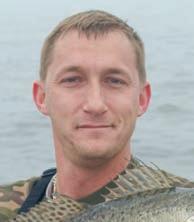
LOS BUZOS, PANAMA: PART 1
If you are a serious kayak fisherman, chances are that you have heard of a place called Los Buzos. If you haven’t, then let me introduce you to a one-of-a-kind fishery that is tucked away on the southern coast of Panama. Los Buzos is a fairly new lodge located on the Pacific side of the country, and they have been breaking IGFA world records ever since they have opened. Given the remoteness of the lodge they have no way to maintain officially certified scales for weighing fish, which means their records are all length based, still very impressive, nonetheless. They have over 30 species that have been recognized by the organization with some of the more reputable being Cubera Snapper, Broomtail Grouper, Big Eyed Trevally and the majestic Roosterfish. They have even landed a few Blue and Black Marlin which is an impressive feat in itself. Oh, and before I forget, they have accomplished all of this from kayaks!
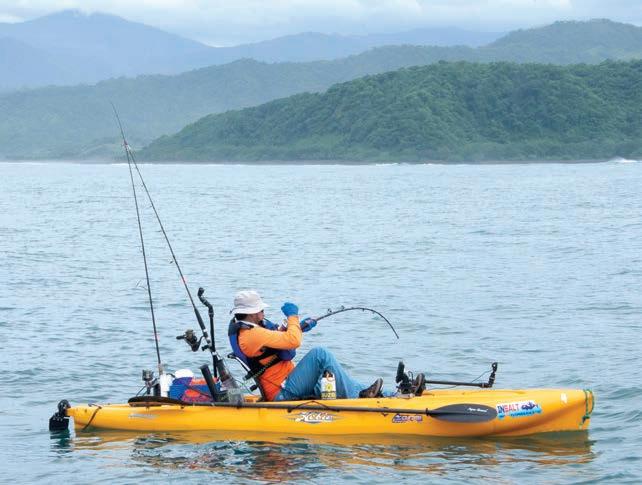
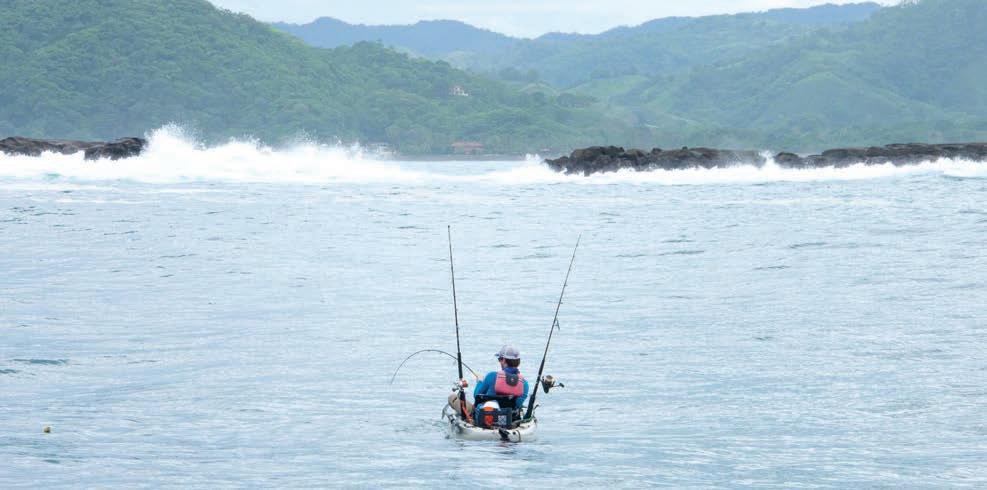
Last summer I had a buddy call and the first words out of his mouth were, “I’m planning a trip and you are not going to be able to turn me down.” I played along and asked where and when, to which he replied, “Next summer, at Los Buzos.” Without hesitation I told him I was in and to please send me the dates.
Fast forward a year later and I am meeting up with our group outside the gate to board a flight to Panama. I was somewhat of the odd guy out, being that I knew only two of the other nine members of the group, but getting acquainted was easy as we are all very likeminded. We landed in Panama after a four hour flight and headed to our hotel to stay the night and then head out first thing in the morning. The drive across the country to the lodge takes six hours. We were greeted by the Los Buzos crew and shown to our living quarters for the coming week. After getting settled we were called to a safety and itinerary briefing, followed by a fantastic dinner of fresh
38 | September 2023
Yellowfin Tuna and grilled Mahi-Mahi. What a treat!
The next morning we were up early and headed down to the beach where breakfast was served. The crew had our kayaks laid out and prepped, ready to hit the water. The gameplan was to first kayak out to a small reef and catch bait, which you would rig onto a live-bait setup and begin slow trolling. The ideal bait was a lively Blue Runner; Roosterfish, they said could not resist them. Within an hour, between our group and the guide boats, everyone had a lively bait rigged up and began to spread out. Each boat was equipped with a small GPS/depth-finder loaded with multiple pin drops and we were told to hang around any of these as they were all known to be productive spots. Most of our group headed towards the rocks to slow troll the outer edges, but I had other plans. I had noticed a mark notated as Rooster CT, (Rooster City), and I questioned immediately how anybody could pass up a place with a name like that.
The morning started off slow but the tide was incoming, and they said when it peaks, there should be a few bites. Sure enough, JC started yelling over the radio that he had a fish on. The coolest thing was that you could hear the drag screaming in the background. The pangas rushed toward him to lend any assistance needed and not long thereafter the first Rooster was landed. Knowing that they did indeed exist, we all stayed carefully focused and patiently awaiting our turn. Around noon a little summertime storm began brewing in the mountains and looked to be headed our way. Hoping for a bit of relief from the heat, I was personally welcoming it.
Dakota came on the radio just as it was coming over the hills and told us to get ready and stay alert. They call them “Rooster Rains” and they turn on when it hits. I would not have believed it if I had not seen it; maybe less than a minute after it started we had two guys hooked up. One got away during the fight and another really nice fish was brought to the kayak.
We kept at it, and after about ten minutes of cooling rain my line began peeling off the reel. I fed it line, counted to ten as instructed, and then cranked down. I could tell it was not a giant, nonetheless I was fighting my first Rooster. I called over the radio and Jeff came over in the panga to assist and instruct. It was as beautiful as I had imagined and I quickly got her back into the water for a successful release. I am now a firm believer in the Rooster Rains and, even though the rest of the day passed slowly, we were off to a good start.
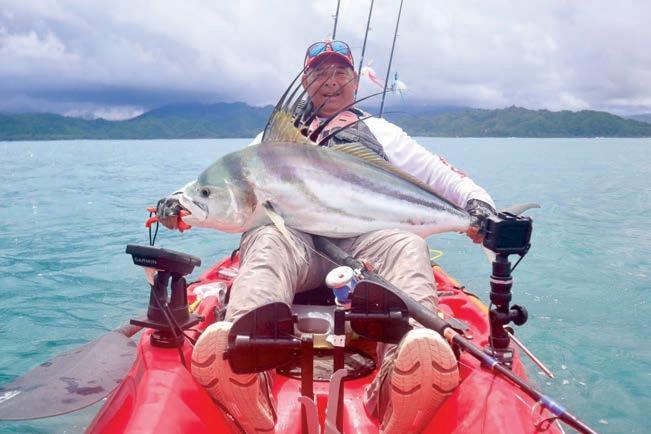
The next day started the same as the first and we all scattered about after getting live bait. I headed back to the same area I had fished the day before with hopes of finding another fish. The morning again passed rather slowly, a few good runs but no hook-ups. Just as the incoming tide was peaking, Blake came over the radio with news that he was hooked up. Once he got it in, Dakota came over the radio announcing that we had a new leader for biggest fish. Stoked for him,
the rest of us kept grinding away. It was not long until Jeff, the other guide boat, said he hooked one while vertical jigging for bait. He had been catching a few fish throughout the past weeks while trying to catch Blue Runners. We continued on through the day and not long before time to head back in, Ryan radioed a hook-up. After a decent fight he, too, had his first Rooster.
Back at the kitchen for another great evening meal, talk soon turned to the next day’s gameplan. Dakota and Jeff laid it out, describing the next day’s weather and tides looking perfect for a mothership trip down to a place called San Patricio. It is a federally protected area and commercial fishing is off-limits, but recreational fishing is allowed. Dakota knew the area well and said that it is worth making the trip, and at times, it can be plain stupid good. So, with confidence in our guides, the next morning would see us loading up the kayaks and heading to San Patricio!
CONTACT
Email: TexasKayakChronicles@yahoo.com

Website: www.TexasKayakChronicles.com
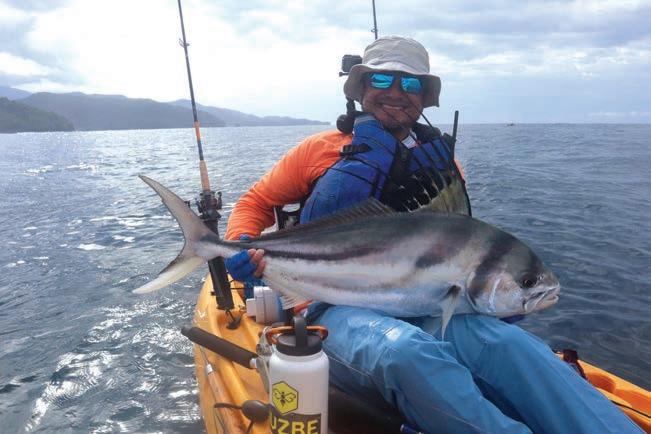 Dave Roberts is an avid kayak-fishing enthusiast fishing primarily the inshore Upper Coast region with occasional adventures to surf and nearshore Gulf of Mexico.
View The Video Open Camera and hover over QR Code. When link appears at top of screen tap to open in YouTube.
Dave Roberts is an avid kayak-fishing enthusiast fishing primarily the inshore Upper Coast region with occasional adventures to surf and nearshore Gulf of Mexico.
View The Video Open Camera and hover over QR Code. When link appears at top of screen tap to open in YouTube.
TSFMAG.com | 39
Redfish Mayhem-Chasing Huge School of Bull Reds
ST. CHARLES BAY: BIG TREE UNIT LIVING SHORELINE REEFING CONTINUES
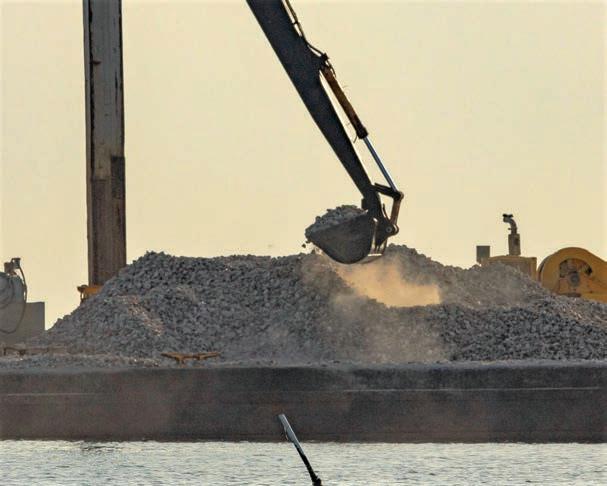
CCA Texas and Tito’s Handmade Vodka recently teamed up to add an additional five reef beds in the Goose Island State Park Big Tree Unit Living Shoreline project. This recent effort is the fourth phase of deployments into the permitted site, bringing the total number of reef beds to forty-four within the twenty-plus acre reef site. The Phase IV cost was $226,250 and funded by CCA Texas and Building Conservation Trust (BCT), and included a contribution of $50,000 from Tito’s Handmade Vodka.
“At Tito’s Handmade Vodka, we are always looking for opportunities to keep Texas flourishing. That’s why
we’re so excited to support the work that CCA Texas is doing to benefit Texans and our coastal ecosystems for years to come.” -Lindsey Bates, Director of Philanthropy Operations for Tito’s Handmade Vodka
CCA Texas originally partnered with Harte Research Institute for this living shoreline project in St. Charles Bay along the Big Tree Unit of Goose Island State Park in August of 2017. CCA Texas and BCT originally funded $75,000 along with funds from TXGLO, USACE, NMFS and others. Phase I resulted in seven reef beds constructed along the Big Tree Unit. The second phase of this restoration and creation effort took place in the spring of 2020. CCA Texas once again provided funding in the amount of $50,000. These funds were secured through the Harvey Relief Fund donation from Lone Star Breweries and were part of an effort that created an additional ten reef beds. In the spring of 2022, Phase III placed an additional twenty-one reef beds in the site. In Phase III CCA Texas contributed $360,000 to the project. This included $100,000 from Lone Star Breweries and $60,000 from Cheniere Energy. This additional funding allowed HRI to expand the Phase III effort by an additional six beds, from the fifteen planned. To date, CCA Texas has funded $711,250 to the St.
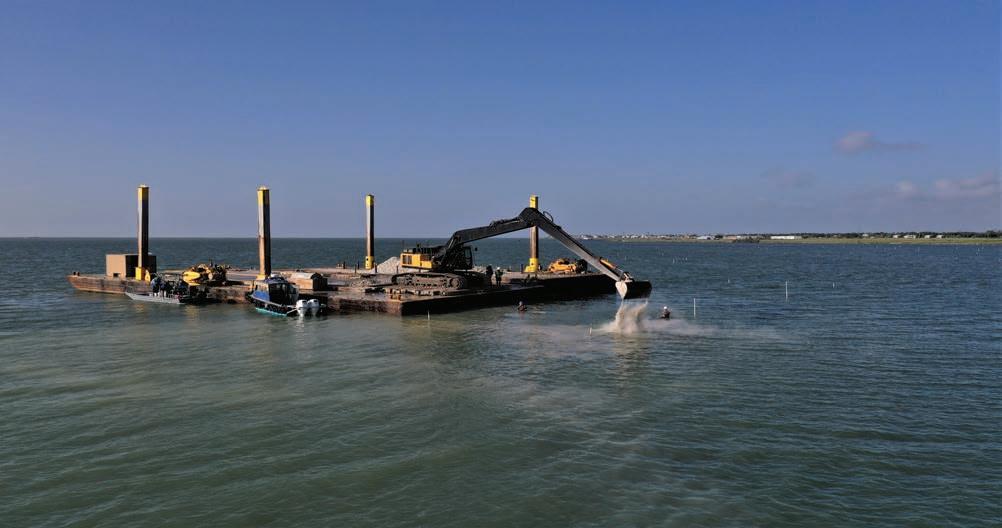
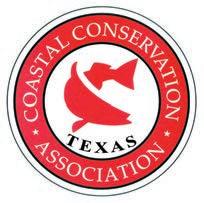
TSFMAG CONSERVATION NEWS
John Blaha
Contractors place rock cultch into the St. Charles Bay Brig Tree Unit reefing area. Each reef bed is checked continuously through construction to ensure proper amounts of material are placed and settled properly. CCA TX Photo
Derrick Construction puts the finishing touches on seven reef beds in St. Charles Bay Big Tree Unit reefing area. After the initial rock cultch is laid, contractors then place a coating layer of recycled oyster shell from area restaurants and shucking houses.
40 | September 2023
Photo courtesy of Janae Evans
Charles Bay Living Shoreline project. The funds have included those from the grassroots banquet fundraising efforts from across the state and supporters such as Tito’s Handmade Vodka, Lone Star Breweries, Cheniere Energy and others.

The original deployments of materials in the site took place in early August of 2017. Seven reef beds were built only weeks before Hurricane Harvey. Not only did these freshly deployed beds survive the force of Harvey, but the storm also kicked off a large oyster spawn,

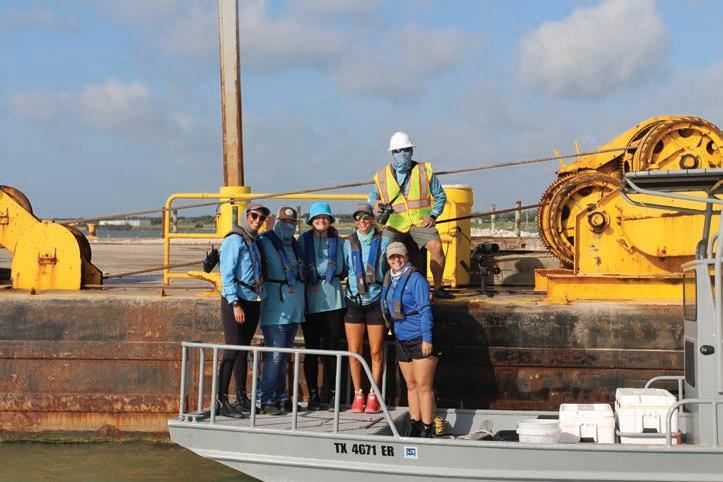
leaving the new beds covered in fresh oyster spat only weeks after Harvey’s passing. The site now boasts forty-four reef beds that supply many ecosystem services to the immediate and surrounding areas, and critical shoreline protection to the Big Tree Unit, which is a major wintering ground for whooping cranes.
This project exemplifies the importance of healthy and growing reefs, and the need for sanctuary reefs. These designated reefs provide seed source for adjacent reefs; serve as habitat for over 300 aquatic species; offer numerous ecological benefits; determine currents; slow water surges and shoreline erosion; and provide recreational fishing opportunities. On any given day, one will see recreational anglers fishing these reef beds in St. Charles Bay by kayak, boat, or simply walking to them from Lamar Beach Road. While oyster reefs do not carry the glamour of seagrass meadows or marsh shorelines, they provide 4.5 times more aquatic biomass than seagrass beds and 11 times more aquatic biomass than estuarine marsh shorelines. Oyster reefs are the bedrock of the ecology and health of Texas coastal resources.

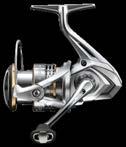

CCA Texas, BCT and our partners are dedicated to continuing the support of the restoration and creation of sanctuary and conservation oyster reefs up and down the Texas coast. For more information about CCA Texas efforts with oyster reefs, please visit www.ccatexas.org/oysters.
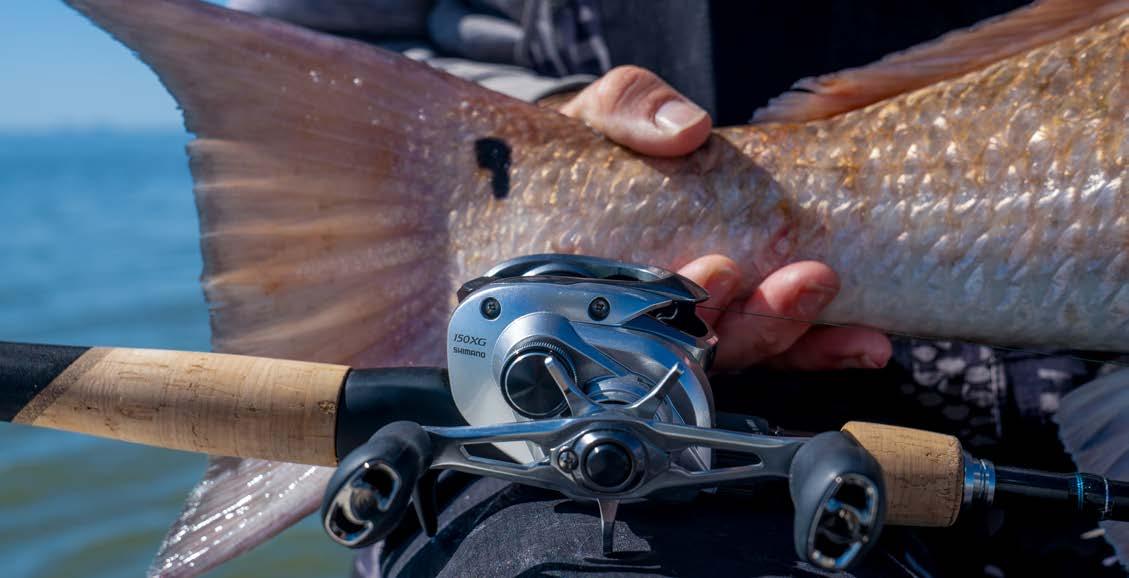
roysbaitandtackle.com TSFMAG.com | 41
Members of Harte Research Institutes Coastal Conservation & Restoration Lab were on hand to observe new reef construction and monitor development of reefs constructed earlier in the program. CCA TX Photo
STEPHANIE BOYD

FISHY FACTS
SALPS
Salps are semi-transparent barrel-shaped zooplankton resembling jellyfish. However, despite the resemblance, salps are in a separate phylum from jellyfish, their ancestries having diverged some 800 million years ago. Jellyfish are in Phylum Cnidaria, along with corals. Salps are in Phylum Chordata, same as us, making them taxonomically closer to humans than jellyfish. In fact, they are related to all the animals with backbones. Larval salps have a notochord running down their back – a tough, flexible rod which protects the central nerve cord and provides an attachment point for muscles, functionally similar to our backbone. Adults lose their notochord as they grow, but the larval notochord is one of the ways we know that salps are one of our closest living invertebrate relatives.
By contracting bands of muscles that ring the body, salps draw water in from the front and pump it out the rear, which pushes the animal along through the water, like a very slow jet engine. When a salp pushes water in one direction, its body moves in the opposite direction. Individual salps vary from about 4 to 12 inches in length, but chains of them can be much longer. They are often overlooked, but are sometimes so numerous that they can even challenge krill populations by sheer numbers.
Tunicates (salps and their relatives) are the second most abundant class of zooplankton (the first being copepods). Salps are found worldwide in equatorial, temperate, and cold waters. They are found at depths from the surface to nearly 5000 feet. The most abundant concentrations are found in the Antarctic Ocean. Salps are filter feeders that eat everything they trap in their feeding net of mucus that hangs inside their bodies. Although the mesh of their feeding net is efficient enough to catch a variety of different sizes of particles, their main food is phytoplankton. They pump water through their hollow bodies and sieve out the phytoplankton. The feeding net is like a conveyer belt, always moving the bits of food into the animal’s stomach. Because of the net’s sticky design, particles frequently build up, which effectively creates a net with increasingly smaller holes, thus allowing the salp to consume phytoplankton in quite a wide range of sizes. This may help explain how salps can survive in the open ocean where the supply of larger food particles is low –where not many other grazers survive. Also, it highlights the importance of the salp’s role in cycling carbon from the atmosphere into the deep ocean. As they eat, they consume a very broad range of carbon-containing
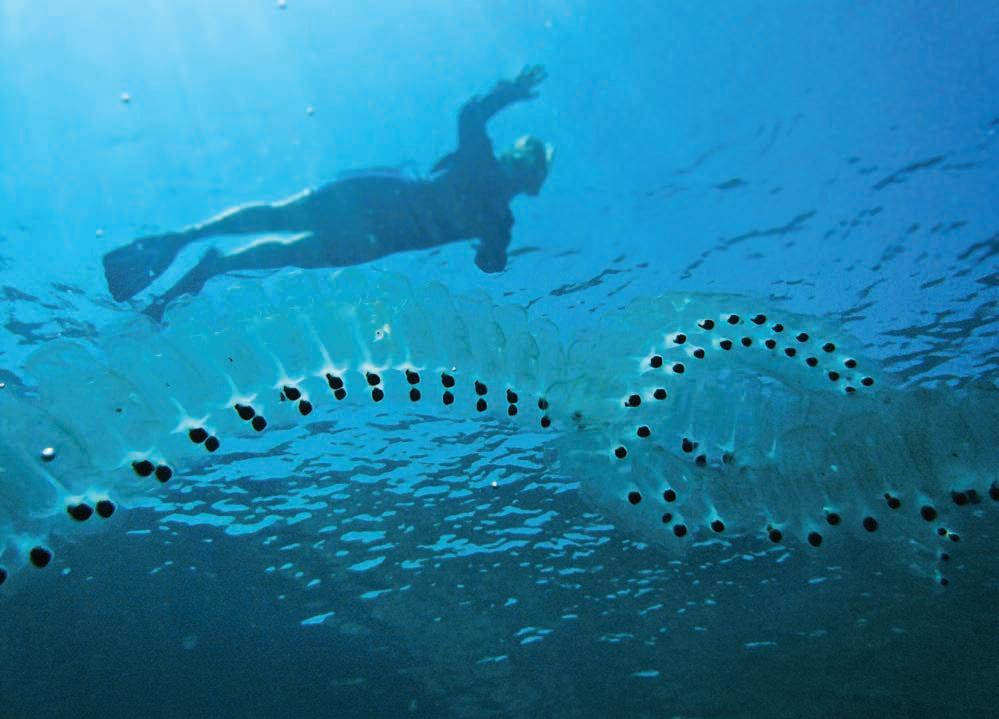
42 | September 2023
Photo by Lars Plougmann. Licensed by CC BY-SA 2.0.

particles, which are then concentrated into fecal pellets that sink rapidly to the ocean depths, where that carbon won’t see the light of day for years, or even centuries. This reduces the amount of carbon in the surface waters, letting more carbon dioxide enter the ocean from the atmosphere. Even though they are much larger than the microscopic phytoplankton they consume, salps are also considered plankton, as they are carried by currents stronger than their own propulsion. The word plankton comes from the Greek planktos, meaning wandering.
Because of their very effective feeding nets, when salps are in very dense populations of phytoplankton, they can actually become clogged with their food source and sink. When this happens, it is not uncommon for the beaches to be full of salp bodies that have washed up due to food comas, especially during phytoplankton blooms. Salps were once thought to be “trophic dead ends,” meaning they have little caloric value as food for other species. However, it seems they are more nutritious than previously thought and provide a gelatinous feast for fish, seabirds, sea turtles, shellfish, whales, other plankton, and siphonophores, such as the Portuguese man o’ war.
Salps have a complex life cycle alternating between a sexual and asexual form. A solitary salp reproduces asexually by budding a chain of clones that bioluminesce. A string of cells comes out of its body and each divides itself up, resulting in many tiny salps. The clones are all identical and all connected together. As the string gets longer and the babies grow larger, they break away as a long, independent chain. Another string forms after the first one, and then another, until many chains of babies have been released into the ocean. These strands can reach more than fifty feet, and the chains of some species form complex shapes, such as giant wheels or double helixes. Salps that are linked together communicate through electrical signals to synchronize their movements, which can produce a chain of harmonized light pulses that snakes or spins its way through the water. Each member of a salp chain is a sequential hermaphrodite, starting life as a female with one or two eggs, and then turning into a male. Mating occurs with chains of older salps that have already transformed into males. A fertilized salp female broods her embryo in a placenta-like membrane until the young salp can survive on its own. Released embryos grow into solitary creatures that asexually bud their own chains of clones, which will then reproduce sexually. By the time she releases her embryo, the mother salp is already turning into a male.
Asexual cloning is an extremely fast form of reproduction but can lead to an evolutionary dead end because it doesn’t result in the genetic diversity needed to adapt to changing conditions in the environment. Sexual reproduction creates genetic diversity within a species, but it’s a comparatively slow way to reproduce. Salps have somehow arrived at a strategy that combines the best of both reproductive methods. When food is abundant, salps clone themselves extraordinarily fast, reaching maturity in only 48 hours. This quick turnaround time lets them take advantage of algal blooms, increasing their population size rapidly – though as mentioned previously, this gluttony can lead to massive die-offs of overstuffed salps.
A swarm of salps can emerge in just a few weeks, and can cover hundreds, even thousands, of square miles, quickly taking advantage of sudden phytoplankton blooms. The effect salps have on the ocean’s carbon cycle wouldn’t be a big deal if there were just a few salps, but in large swarms, in particular, there is enough of both the fecal matter and the bodies sinking to the ocean floor that they can have a huge impact on the biological pump of the ocean, not only affecting the ocean’s carbon cycle, but even contributing to climate changes in the area. Scientists from the Woods Hole Oceanographic Institution, in expeditions conducted in the Mid-Atlantic Bight region (between Cape Hatteras and Georges Bank in the North Atlantic), estimated that a swarm of salps consumes up to 74 percent of phytoplankton from the surface water each night, and their sinking fecal pellets can transport up to 4,000 tons of carbon a day to deep water. (Salps feed in surface waters at night and retreat several hundred meters down during the day, possibly to avoid predators.) Their bodies sink even faster than pellets, so the ones that don’t wash up on the beach are sending even more carbon to the deep. Though they look like lumps of limp gelatin when they’re stranded on the beach, apparently swimming with salps has been described as a pleasant experience, like swimming with marshmallows.
Where I learned about salps, and you can too!

World Register of Marine Species
www.marinespecies.org/aphia.php?p=taxdetails&id=137217#distributions
44 | September 2023
Australian Museum australian.museum/learn/animals/sea-squirts/what-is-a-salp/
Marine Education Society of Australasia www.mesa.edu.au/tunicates/tunicates01.asp
Woods Hole Oceanographic Institution
www.whoi.edu/oceanus/feature/salps-catch-the-oceans-tiniest-organisms/ www.whoi.edu/know-your-ocean/ocean-topics/ocean-life/ecosystems/polarlife/the-watery-world-of-salps/
It’s Nature itsnature.org/sea/other/salps/
Coastal Interpretive Center interpretivecenter.org/salps-a-mystery-on-the-beach/
Mexican Fish mexican-fish.com/salps-of-the-salpidae-family/
Dive and Discover divediscover.whoi.edu/archives/expedition10/
Earth Life earthlife.net/inverts/thaliacea
Science Daily www.sciencedaily.com/releases/2006/07/060702085004.htm
Live Science
www.livescience.com/4181-ocean-gummy-bears-fight-global-warming.html
Oregon Marine Reserves oregonmarinereserves.com/2018/02/15/salps/
The Nippon Foundation Nereus Program nereusprogram.org/works/our-jelly-like-relatives-common-misconceptionsabout-salps/
Kidadl kidadl.com/facts/animals/salp-facts
Evolution News & Science Today evolutionnews.org/2023/02/meet-the-ghostly-organisms-that-rescue-theplanet/
The Weather Channel weather.com/science/nature/news/salp-antarctic-oceans-krill-decreasewarmer-waters
Wikipedia en.wikipedia.org/wiki/Salp
View The Video

Open Camera and hover over QR Code. When link appears at top of screen tap to open in YouTube.
Facts: The Sea Salp

TSFMAG.com | 45
ERIC OZOLINS EXTREME KAYAK FISHING & SHARKS FROM THE SAND
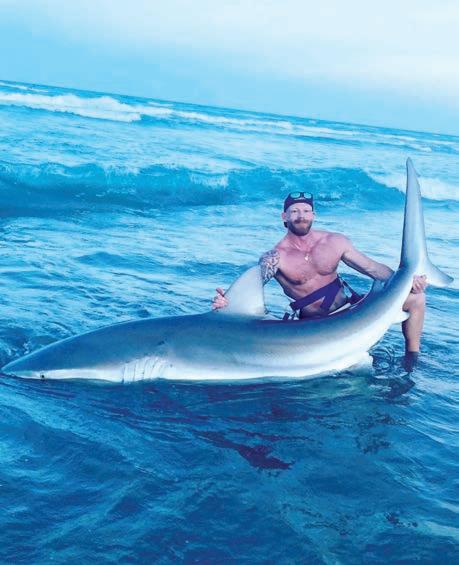

YEAR OF THE DUSKY
Some fish fascinate people more than others. A few species seem capable of casting spells on the anglers who revere them. The speckled trout serves as the main source of obsession for some citizens of the Lone Star
State. Across the globe, in the cobalt depths of the open ocean, others feel a kind of magic when they think of the mighty blue marlin.
Personally, I’m enthralled by a particularly elusive devil of a shark. Some might surmise I’m thrilled by one of the two biggest species of sharks which frequent Texas waters—the tiger or the great hammerhead. Others might guess my wonder fish is a monster mako. But, while these sharks all hold special places in my heart, they don’t rank at the top of my list of favorites.
Throughout the seasons, a wide variety of sharks visit the nearshore waters off the Texas coast. Some stick around longer than others, and some are more abundant than others; a few occur only quite rarely. My research indicates Texas anglers have landed about 15 species of sharks from our beaches. Of these, one rare species with a partially appropriate Latin name, piques my interest more than the others—the dusky shark, aka (Carcharhinus obscurus).
Dusky sharks typically prowl the waters far offshore. They’re capable of attaining impressive size; anglers have landed specimens measuring up to about 14 feet in length and weighing over 700 pounds. The current world record is 764 pounds. Because the species is federally protected, this mark might stand the test of time.
Like sandbar sharks, dusky sharks prefer cool water.
 Oz landed this 10-foot 10-inch dusky recently during the cold-water upwellings.
Oz landed this 10-foot 10-inch dusky recently during the cold-water upwellings.
46 | September 2023
Christian Halterman enjoyed success this summer with several dusky landings.
In Florida, during the winter months, anglers hook decent numbers of them in the shallows lying close to the panhandle, one of the prime locations in the Gulf to catch a dusky, mako, or even a great white during cold weather. Conversely, anglers in Texas are unlikely to encounter a dusky during winter; we have our rare shots at the species when abnormal cold-water upwellings occur during the summer months.
Every few years, a strange anomaly affects the nearshore waters of Texas. All these events happen between June and August, after strong south winds have blown for extended periods of time. The persistent breezes stir strong currents which trend northward along the sandy margin where the land meets the sea, pulling cool water from the depths to replace the normally warm water close to the beach.
During the hot season, when the water on the beachfront runs a whopping 10 to 13 degrees below average, seemingly crazy events occur. In this scenario, the churning water typically turns murky, driving many of the fish either up or down the coast, or offshore. Most forage species flee from the cool, dirty water, and with so little available food in the surf, predators become scarce.
While most other sharks move out of the shallows when the water turns brown and cold, the dusky sharks move in. Perhaps they arrive in search of some kind of specific prey, or perhaps they come strictly for mating purposes. All the dusky sharks encountered during these events are mature adults. Regardless of the answers to the questions about why these sharks prefer water like this, savvy sharkers realize their chances of catching a dusky in Texas improve dramatically in such situations.
In the realm of Texas land-based sharking, dusky sharks rank in the upper echelon of rare species. Until a few years ago, only a few Texas anglers had reported landing one from the surf. More recently, with the cold-water upwelling events increasing in frequency, a greater number of anglers have reported catching duskys.
I landed my first one almost 10 years ago. Extraordinarily rare, this was the first catch publicly documented since Billy Sandifer and his client caught a dusky back in the 90s. On the 9’6” specimen I landed; I attached a satellite tag for the Harte Research Institute. After this memorable event, several years passed before another angler dragged a dusky onto the sand of the Texas surf.
Then, roughly six years ago, conditions similar to the ones we’re experiencing this summer prevailed. When this happened, the dusky sharks came back around in numbers. I remember a single trip from that year on which we beached five! The largest of those, a 10’10” monster, stood at the time as the largest dusky confirmed as caught from the Texas surf. Several of my friends caught smaller specimens during that unforgettable run. This year, anglers landed more of these prized predators, when the cold water lingered longer than ever before.
2023’s unprecedented cold-water upwelling event started in June and lasted all the way into August. On South Padre Island, my friend Joel Ybarra and his clients landed multiple large specimens during June. Then in July, on North Padre, a record number of dusky sharks were landed by many of my friends, all mature adults measuring up

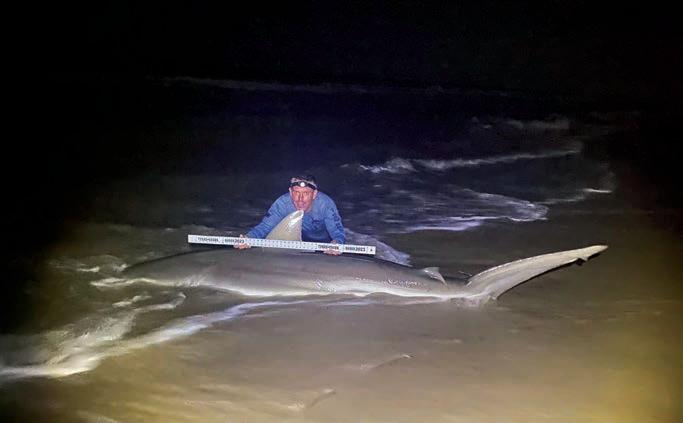
to over 11 feet and weighing several hundred pounds. Even when calmer weather returned in August, people continued to catch an occasional dusky.
During this historic run, most anglers used jackfish to tempt dusky sharks to take a bite; only a small number bit stingrays. Most likely, a related phenomenon, the presence of massive balls of menhaden just offshore during these events, spurs this truth. Jack crevalle feast on large menhaden, and are often abundant during times like these, whereas warmer water favors larger amounts of smaller dusky anchovies, rather than the menhaden, breaking the link in the food chain, atop which the duskys reign.
Surely, the abundance of appropriate prey and the cold water comprise two of the main magic ingredients which lead to anglers landing numbers of dusky sharks in Texas. These brutes provide about every elixir to quench a shark angler’s thirst. Like supersized blacktips on steroids, these long, sleek sharks have large, wide mouths, replete with teeth. Their rarity adds to their mystique and makes them a truly prized catch among the people in my community. With so many dreams fulfilled, 2023 will certainly be remembered as the year of the dusky!
For the past decade Eric ‘Oz’ Ozolins has been promoting shark catch and release and assisting various shark research programs. Eric offers guided shark fishing on Padre Island National Seashore. Also renowned for extreme kayak big game fishing, Eric is the owner of Catch Sharks Tackle Company.
Email oz@oceanepics.com
Websites oceanepics.com | catchsharks.com
CONTACT
Deon Hunter with a 10-foot 6-inch dusky shark landed and released during July 2023.
TSFMAG.com | 47
Joel Ybarra brought this fine specimen of a dusky shark to the South Padre Island beach.
JAKE HADDOCK

MOSTLY SIGHT-FISHING
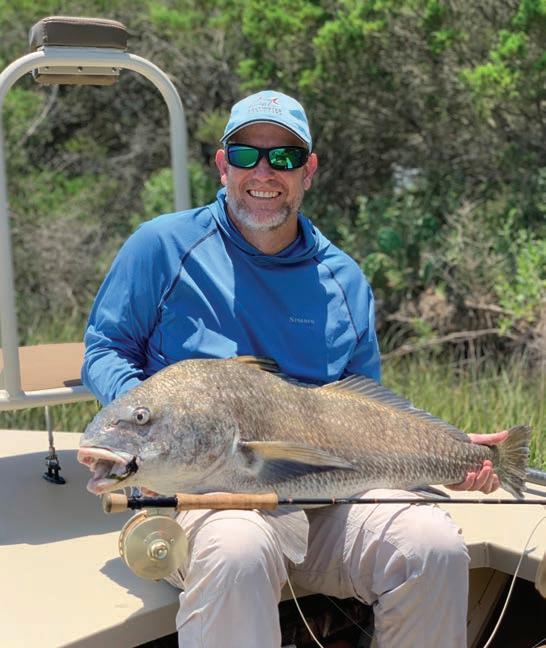
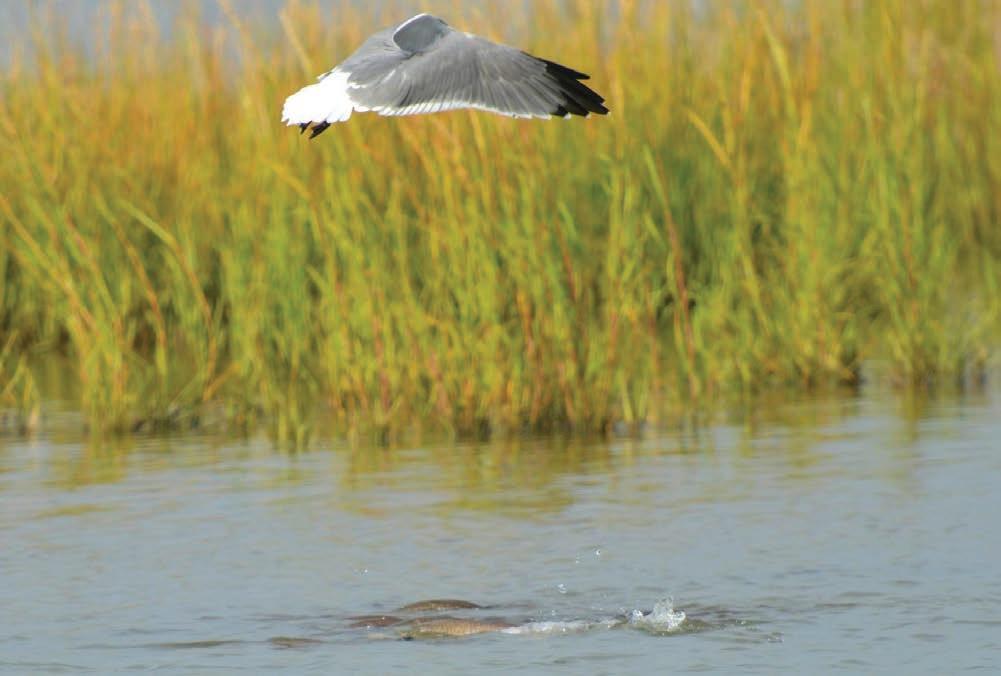
PLAY IT AS IT LIES
I often find when too much time has passed since my last fishing trip, my mind will begin to drift to a picture-perfect fishing scenario. Usually occurring a day or so before the wind gods will bless us with the next window of opportunity, vivid daydreams start to occur. Having a particular honey-hole in mind based around what the half-witted weatherman predicts, I start to imagine fish of trophy-size swimming on X marks the spot. The sun at the right angle over my back, light wind, and the slightest flowing tide, all that’s left to do is place a cast anywhere near those giant elusive fish.
Unfortunately, more times than not, I arrive at these sacred grounds to find the current conditions not anywhere near how I’d imagined in my mind’s eye. In that moment, it’s easy to get frustrated, setting yourself up for failure the rest of the day. Yet with just a few adjustments you can transform a day of boat riding into a day of catching.
Be Observant. This simple aspect is what often turns a decent day into a great day. From the minute you arrive at the ramp, you should be looking for clues. A simple observation of
Spotting a large tail while underway led to this angler’s largest fish ever on fly!
48 | September 2023
Keep your head on swivel; a low hovering gull might be worth investigating (photo by Brad Sears).
the water level can make or break your day. Yes, the tide chart on your phone might say it’s nearing high tide, but what if the wind blew from a particular direction all night and pushed it out lower than predicted? Once on plane and headed to the grounds, instead of peering constantly at the GPS screen, observe all that you can and ask questions. What are those egrets doing on the shoreline? Why did those mullet jump suddenly, as if avoiding certain death? Or what about that small slick on the water just off the channel edge? Did the crabber just re-bait his trap or was it made by feeding trout? If something you see continues to look interesting as you approach, stop at a distance and observe for a few moments. Don’t be in such a hurry to get to “a spot.” Chances are someone is probably already there anyway.

Make the news, don’t fish yesterday’s. How many times have you received a phone call from your buddy on the other side of the bay that goes something like this; “Hey man, the bite’s on fire over here at XYZ.” Yet when you make the run and arrive on the scene, the bite has gone stone cold and there’s nothing to write home about. I too have been guilty of this and personally detest getting those phone calls. Sticking to your own puzzle for the day will often yield greater success. I would rather work a small group of undisturbed fish that are more likely to eat than pick through someone else’s leftovers. However, the problem is that it’s easy for this phone call to instantly get in your head. Knowing someone else is seeing fish at this very moment when you are not can be frustrating. You must remain confident in your own process and knowledge in this moment, knowing that you’re just one small move away from making your own news.
Do your homework. I feel it was beneficial for me to have grown up in the era when a GPS on your flats boat did little more than provide a route to a given waypoint. Savvy backcountry fisherman that wanted to see what was around the next bend printed out satellite images from Terra Server USA to study at home. My uncle, going one step further, kept a binder in his boat with the latest satellite shots of areas that were next on the list to be explored. If needed, you could take a quick glance at the cheat sheet before running creeks into an unknown area. It is likely much safer than people attempting to navigate with their eyes glued to a GPS the size of a computer screen. My current flats boat, which is a simplistic tiller-steer Sabine Skiff, doesn’t even have a GPS, and for fishing the shallow backwaters of the Texas coast, I prefer it that way. While out on the flats, it’s more beneficial for your attention to be focused on studying the water and birds that may be flying above it. Dry ground is the proper place to study Google Earth. If you get in a bind while exploring, you can take a peek at the satellite mapping that comes standard on most smart phones. The only time I feel it is beneficial to have a big GPS with satellite overlay is during winter when we have thick, lingering sea fog. However, every winter I see many people using their track lines with way too much confidence. Running their boat at full throttle through the grey abyss, completely oblivious that there might be a boat parked on that track line. The point is do as much of your homework AT HOME as possible. When you’re out there hunting fish, your eyes need to be scanning the water, not a screen.

TSFMAG.com | 49
Lots of barnacles exposed at the ramp, sure sign of a low tide morning.
In conclusion, finding concentrations of fish in shallow water is a skill that takes hundreds of hours on the water to learn all the tricks of the trade. No amount of YouTube video can teach you the intuition and insight that’s needed. Going with seasoned guides and picking their brain can shorten your learning curve tremendously. When receiving word of a hot bite, rather than racing to that exact spot, try to get information on things such as what depth of water the fish are holding in, what the bottom structure might be, and what bait has been producing the most bites. Apply that information to the area you’re already working. Running right to the numbers someone hands you doesn’t help you learn a thing.
While learning a new area, study the topography on Google Earth until you are cross-eyed. You’ll know when you’ve done your homework thoroughly because you can go into areas you’ve never actually been to with confidence as if you’ve been there dozens of times. When striking out on your own, try to leave your right brain at home and utilize your left. In other words, stick to the facts of the conditions in real-time and don’t let your imagination drift away. You must play the fish as they lie, if you don’t, you’re only lying to yourself.
CONTACT
Jake Haddock grew up in the back bays of Port O’ Connor where he developed a great passion for saltwater fishing. In his younger years he was a youth writer for this publication. In present day he enjoys guiding light tackle and fly clients in Galveston and occasionally Port O’ Connor.
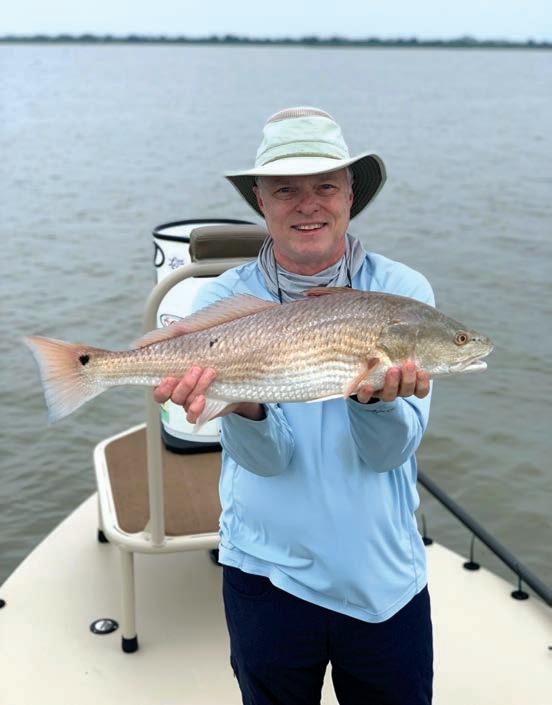
Phone 713-261-4084

Email frigatebirdfishing@gmail.com
Website www.frigatebirdfishing.com
50 | September 2023
Ralph Midkiff took advantage of the conditions that were given this day.
3) Mark-Recapture Studies: Tagging fish with simple dart tags and evaluating which ones are recaught provides valuable information on which release types are most successful.
a. Stallings et al. (2023) found that red snapper and red grouper were two to two and a half times more likely to survive release when descended to 20 meters than when vented, per tag return data. Fish descended to only 10 meters had similar survival rates to those vented.
Moral of the Story: Not every fish will survive release but it’s our responsibility to give each one their best shot!
Return ‘Em Right to Earn Another Fight
The Return ‘Em Right program offers anglers a free 15-minute online education module on barotrauma, venting and descending. Upon completion, offshore anglers that fish in the Gulf of Mexico will receive $100 worth of release gear for FREE. Yes, it is completely free. If you haven’t gotten your gear from them, don’t wait too long! Visit returnemright.org for more.
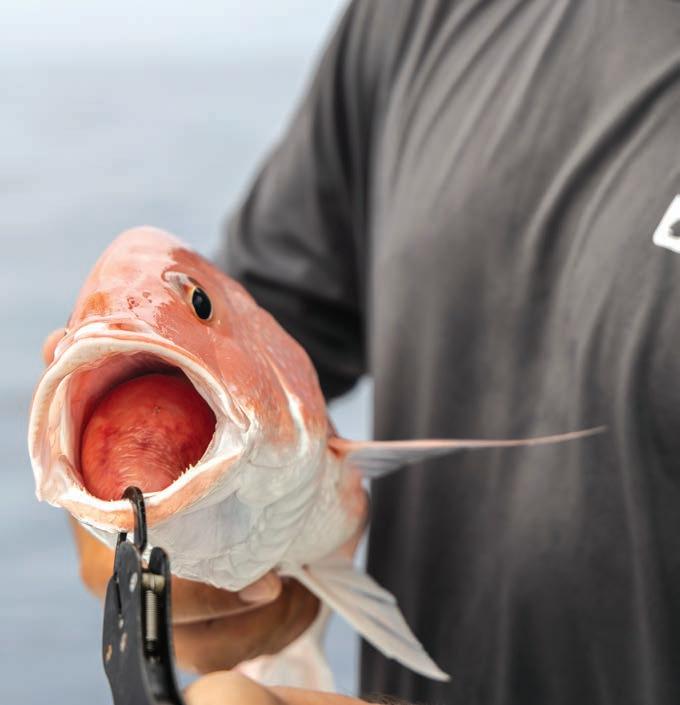

...continued from page 31. TSFMAG.com | 51
NEW
Okuma Inspira Isx Spinning Reels

Introducing the Okuma Inspira ISX Spinning Reel, a game-changing innovation in the spinning reel market. Its diecast aluminum Torsion Control Armor (TCA) technology provides up to 40% greater torsion and flex resistance with a double arm body design ensuring perfect internal alignment. The Inspira ISX is stronger, more efficient and guaranteed to deliver outstanding fishing experience. Available in 2000, 3000, 4000 and 5000 size, the Inspira is perfect for most all of your fishing applications.
OkumaFishingUSA.com/products/inspira-isx-spinning-reels
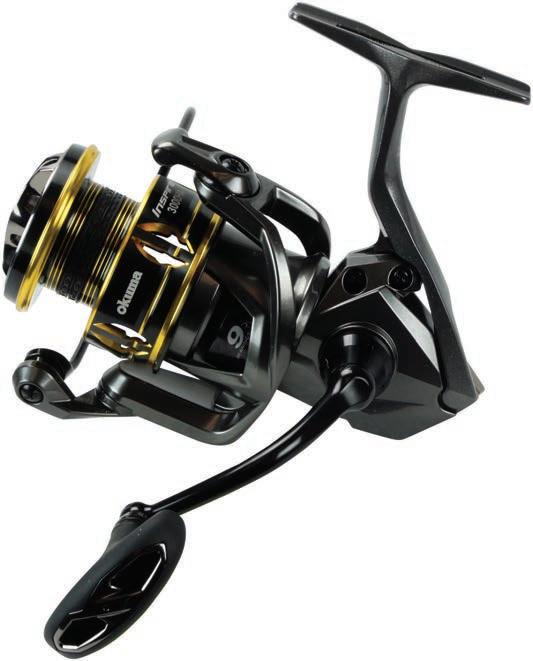
Gone Coastal Jewelry
Our Sterling Silver Sand Pendant is a perfect memory for you or a loved one’s favorite summertime vacation spot.
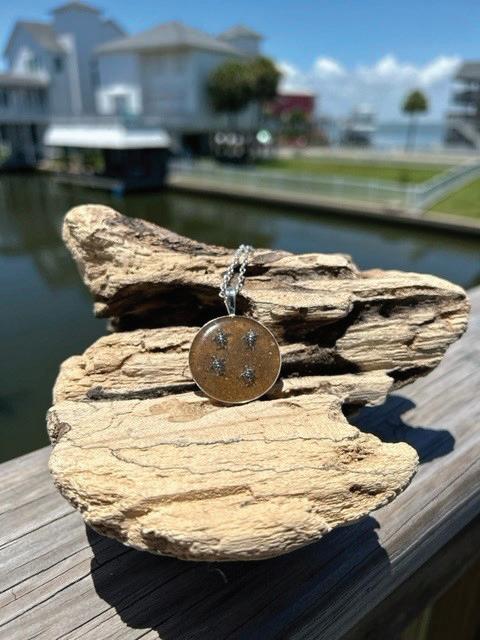
You can make a pendant with your own sand with an option to add turtles, waves or plain to make it your own unique custom pendant of yours or loved one’s favorite memory.
You can also choose from our already made pendants with sand from various tropical countries. Pendants come in a variety of shapes and sizes. www.GoneCoastalJewelry.com
MirrOlure’s Newest: The Duke Dog
The Duke Dog is MirrOlure’s newest surface walking lure. Built for explosive topwater strikes, the thin shad profile of this bait provides a smooth walking action. Perfect for shallow and mid-depth waters. Named after our mascot, Duke, the Airedale Terrier, who passed away this year. Duke loved to go fishing on the boat and always got excited watching trout explode on topwater baits. This is our tribute to him. The Duke Dog is intermediately sized at 3.5 inches and weighs 3/4-ounce. Available in seven new custom colors, specifically made for this new bait.
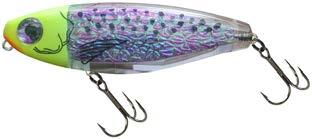
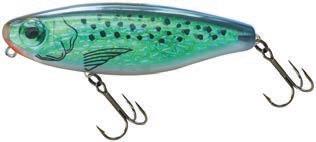
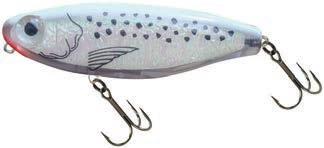
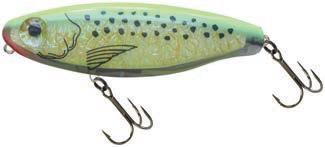
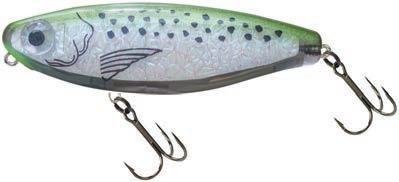
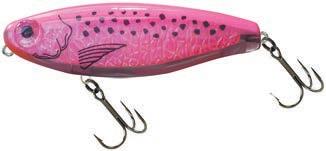
www.ShopMirrolure.com
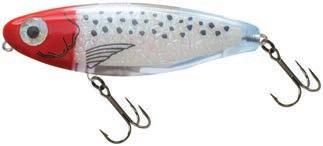
52 | September 2023
Meet the Z-Man® Mulletron™
New finger-mullet-imitating ElaZtech® swimbait goes coastal “We created the Z-Man Mulletron to draw primal responses from fish working key ambush points,” notes Jose Chavez, Z-Man Director of Product Development. “Put it in nervous water. Swim it right through and alongside rafts of finger mullet, and see what happens.”
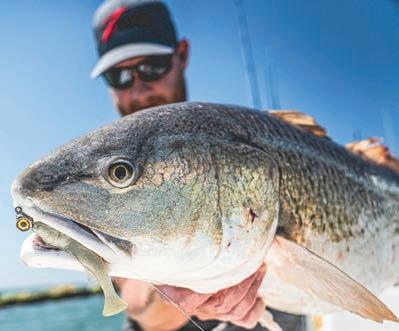
Formed with a true-tolife finger mullet profile, including authentic head and body shape, lifelike gill plate, eye and fin details, Mulletron swimbaits are sized to replicate the most edible and ubiquitous inshore baitfish in nature. Breathing life into the Mulletron’s swimming action, a rounded, wedge-shaped tail activates at a wide range of speeds, including the often critical and seductive slow roll.

Available in 3.3- and 4-inch sizes in the ten most popular inshore color schemes. Slated for October retail release. For more information, visit www.ZManfishing.com
Dixie Jet Pro Series Gizzard Spoons – Now at Fishing Tackle Unlimited!

Dixie Jet Pro Series Gizzard Spoons are effective for almost any fishing application, especially suited for surf fishing or casting in open water. This spoon is the perfect size and weight for long casts or fast drops at 3.25” length, 1.25” width, and 1.35-ounce weight. Made from marine-grade brass and cupped teardrop shape, it creates an irresistible fluttering action that perfectly mimics a dying shad falling through the water column. Whether fishing open water, pumping deep ledges, or vertically jigging offshore structure, Dixie Jet Pro Series Gizzard Spoon has perfect bait profile for any body of water.
www.DixieJetLures.com
Brand New from Hunt Monkey!
Hunt Monkey Gloves presents The Heater...Perfect for deer hunting, and long boat rides on cold winter mornings!

Designed by deer hunters for deer hunters, The Heater will keep your hands warm and comfortable in even the coldest conditions.
The Heater comes in Mossy Oak Bottomland camo and features a sherpa lining which is extremely warm, yet quiet. This glove has an outer shell that is Water Resistant and Wind Proof, constructed of 20g Polar Fleece material. The Flip Top Mitten has magnet stays so you can easily access the trigger when the time is right. Under the Flip Top is a Hand Warmer Pocket. The palm is synthetic leather with 100g insulation.
The Heater is sure to keep your hands toasty and quiet in the deer stand. Don’t let cold fingers get in the way of your hunting success. Get The Heater from Hunt Monkey Gloves today!
www.HuntMonkeyGloves.com

PRODUCTS
TSFMAG.com | 53
Telephone
713-552-0505
Email
jbashaw@ifgrr.com

Address 5701 Woodway Dr Suite 330 Houston, TX 77057
FINANCIAL MANAGEMENT & PLANNING FOR TEXAS ANGLERS & OUTDOORS ENTHUSIASTS
Patience is a Virtue
I was recently on a guided fishing trip in West Galveston Bay with a friend and my son. We had a pretty good morning going—lots of action but few keepers—typical summertime fishing. After about 20 minutes, my friend asked the guide, “Are we gonna stay here or do you have another place we should try?” I chuckled and shook my head. While my friend is an accomplished fisherman, he lacks patience—at least in fishing. He is a wildly successful businessman, father, grandfather, philanthropist—but in fishing, he seems to forget all those lessons he’s learned AND taught. He wants to catch keeper trout NOW! How many times have you been on a guided trip and the guide spends all his time talking to his guide buddies on the cell phone? Where are you? – Anything working? – I guess we’ll make a move!” In my mind, those aren’t guides—they are tour operators.
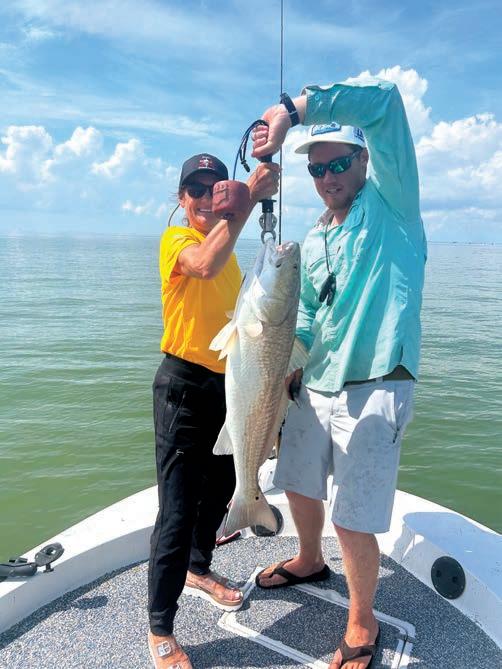
Being a professional guide or a financial advisor is a full-time job. There are no part-time Sherpas on Mount Everest. It requires skill, conditioning, training, commitment, equipment, and knowledge. The most important part of a Sherpa’s job is not to get their clients to the top of Mt. Everest—It’s to get them back down safely!
I have had the good fortune to fish with many of the best guides on the Texas coast. I encourage everyone to use a licensed fishing guide—it’s the smallest expense you will ever have in fishing. One of my favorites is Jay Watkins. Jay isn’t just a guide—he’s a Sherpa. He trains you along the way. When you meet him, he is ready for the conditions—wind, rain, tidal movement, salinity, structure—he has a plan. But Jay is patient. “Patience is a form of wisdom. It demonstrates that we understand and accept the fact that sometimes things must unfold in their own time.” (Jon Kaba Zinn).
Jay is a wading guide, so sometimes for the novice, it looks like a march.
Jay and his clients will wade the same spot seemingly endlessly. Jay knows where the fish are, he knows where the structure is, and he is patient. Jay also knows that sometimes things change. However, Jay will give his spot a decent amount of time to “develop.” In a lifetime of commitment to the sport, Jay understands the job is to get the clients on the fish, but he also knows, of everyone in the boat—he is the most accomplished and studied. In 30 years, I’ve never seen Jay take fishing directions from a customer.
In my business, investment management and financial services, it’s the same way. Patience is a virtue—and a successful advisor will be a patient advisor. As, Warren Buffett says, “Successful investing takes time, discipline, and patience. No matter how great the talent or the effort, some things just take time: You can’t produce a baby in one month by getting nine women pregnant.”
Diversification—or as I call it “De-worsification” can kill an investment portfolio like it can kill a good fishing trip. The most often question I hear asked of guides is, “Why here?” Well, it’s because the guide—he or she-- has fished these many waters for many years, and they know that on a day like today, the place to fish is here. And not simply because it’s on the GPS from last month. As Mr. Buffett says, “Wide diversification is only required when investors do not understand what they are doing.”
So, if you have ever fished with a guide and over the course of 4-5 hours, they move two to three times, and the last move you “really get on them” don’t be surprised—or disappointed. That place may not have worked at 7am or 10am, but at 11am it was absolutely the best place to fish. Hiring a professional guide gives you that edge. The same is true in investing in the stock market. I have been a registered representative for almost 40 years. I have seen good markets and bad markets and, more importantly, bad markets that no one saw coming—just like a midday squall on a pretty day on San Antonio Bay. However, because I’ve seen it before, I know what to do and try to move everyone to safety.
The market is at all time highs and that should give investors a chance to reflect. Patience is a virtue. I see a bright future for this country. As Warren Buffett says, “For 240 years, its been a terrible mistake to bet against America, and now is no time to start.”
Looking forward to fall fishing!
Chief Executive Officer James E Bashaw & Co.
JEB BASHAW PAID ADVERTORIAL
Securities and advisory services offered through Independent Financial Group, LLC (IFG), a Registered Investment Advisor. Member FINRA/SIPC. Jeb & Co, James E. Bashaw & Co. and IFG are unaffiliated entities.
Securities and advisory services offered through Independent Financial Group, LLC (IFG), a Registered Investment Advisor. Member FINRA/SIPC. Jeb & Co, James E. Bashaw & Co. and IFG are unaffiliated entities.
54 | September 2023
My wife Laurel Bashaw, the catch of my lifetime; with guide Brandon Overton and Laurel’s catch of the day.
and the


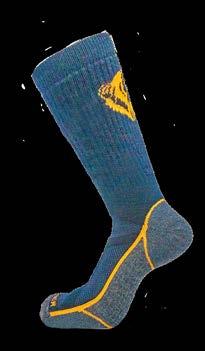
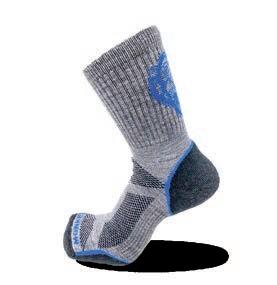

The Case of the Caribbean Killer

In the middle of the COVID-19 pandemic, another epidemic began under the waves of the Caribbean Sea, extending from the coast of Florida to the northern coast of Venezuela. Starting in January 2022, long-spined sea urchins began losing their spines and dying off by the thousands. This species had already nearly disappeared during a massive die-off in 1983-84, when the population fell by about 98%. Scientists never figured out why the die-off happened, but the event had dire consequences, since these sea urchins eat algae that otherwise grow out of control and destroy corals. The 1980s die-off devastated nearby reefs, so when urchins started suddenly dying again, biologists were anxious to find out why.
A year later, the world has an answer to the mysterious case of the Caribbean urchin killer: the culprit is a single-celled animal called a ciliate, a protozoan named for the tiny hair-like structures, called cilia, they use for swimming. Conditions were likely ideal for these ciliates to reproduce in large numbers and disperse throughout the Caribbean where they infected the sea urchins. The mystery was solved by the efforts of an international team of biologists from many universities and organizations throughout the Caribbean and led by a professor at the University of South Florida.


Thanks to the collaborative approach of these disease detectives, the forensic marine investigation took only four months, instead of the years it might normally take. They collected urchins from 23 sites throughout the Caribbean and performed various tests that pointed to the ciliate. Although most ciliates don’t cause disease, this particular one had already been known to kill other marine species, including sharks. Knowing the answer, however, has led to plenty of new questions, including how to prevent future similar events. But now, scientists have a place to start.

fishmonkeygloves.com 100% Satisfaction Guaranteed Made in the USA INTRODUCING PERFORMANCE WOOL FISHING SOCKS to FISH www.ScienceAndTheSea.org © The University of Texas Marine Science Institute Science Sea
TM
TSFMAG.com | 55
A ciliate (similar to the one in the inset) caused a die-off of longspined sea urchins in the Caribbean Sea. Urchin credit: Miranda Manross, CC BY 2.0. Ciliate credit: Cammie Hyatt, University of Texas Marine Science Institute.
Matagorda
THE VIEW FROM Matagorda
Grab a rod, grab a shotgun - grab both – this is what we do in September.
Grab a new license, too. Yours, like mine, probably expired August 31.
We all need rain. The bays need it, the marsh needs it, the lakes need it, the deer need it, the fish need it, the ducks need it and all our home’s foundations need it.
I can’t remember a hotter, dryer summer than what we have endured. I can’t remember tides being so low for so long this summer.
The Emergency Order enacted by TPWD that reduced limits on speckled trout due to the calamity of the freeze of February 2021 is set to expire Aug.31, 2023. Bag limits for trout will revert back to 5 trout per day with a size limit of 15-25 inches, with one over 25 legal to harvest.
The way I see it, this is not good for the fishery. So, guides out of the Sunrise Lodge will continue to play catch and release with trout and only harvest male fish and those legal fish stressed to the point where mortality is eminent.
We encourage all to practice catch and release. It works.
The attitudes of Texans toward a more conservative approach to trout harvest has caught fire since the freeze; and, trout quantities and qualities are improving because of it.
Telephone 979-241-1705
Email
binkgrimes@yahoo.com
Website matagordasunriselodge.com

Hopefully September gives us relief and lives up to the pattern of the first cool fronts of the year and swelling Equinox tides.
Expect redfish to fill the back lakes and grassy shorelines and readily eating small topwaters and weedless soft plastics. Bloated water levels also encourage large, solitary trout to extend their boundaries to the upper reaches of estuaries.
We typically find large schools of redfish on the north shoreline in September. Live shrimp, mullet and topwaters all work well. Back bay areas like Oyster Lake, Crab Lake and Lake Austin are known to hold healthy populations. Don’t be surprised to see birds working in the back lakes on calm days as shrimp begin to leave the marsh.
Wading the mid-bay reefs in East Matagorda Bay produce trout throughout the year. With higher tides, the muddy bottoms around Brown Cedar Flats hold both trout and redfish for waders and drifters. The far east end of the bay gets really good this time of year.
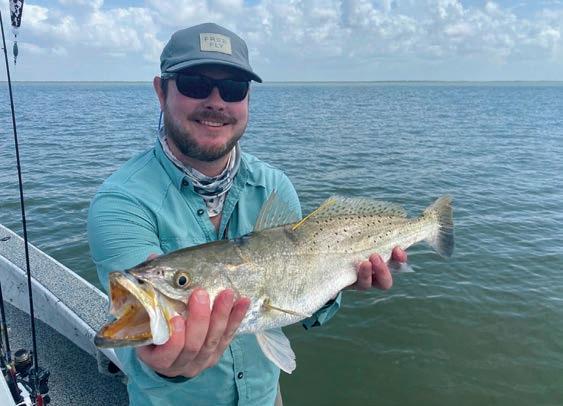
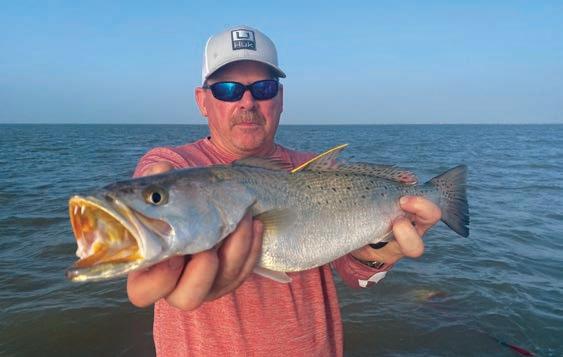
Most waders overlook the grassbeds in West Bay in September, but they still hold fish, redfish especially. Guts and cuts along the south shoreline also often get overlooked. I don’t know why anglers forget about West Bay in September, but it’s a good place to get away from the crowds.
Reefs along the north shoreline of West Bay hold trout, redfish and black drum that can be taken readily on live shrimp. Shell Island, Twin Island and all the points along the north shoreline are littered with shell. Redfish have been known to school in large numbers in late September in these locales.
The bruiser redfish will be on the beachfront and along the jetty rocks. Cracked blue crabs and fresh pogies are a nice snack for big spawners.
Lots of tarpon were found along the gulf beach from Matagorda to Port O’Connor in August and those same migrating schools should still be there this month. Our tarpon fishery is an untapped resource, but it would blow your mind to see all the huge schools of ‘poons rolling and daisy-chaining so close to the beach.
Teal season runs Sept. 9-24 and we will be hunting the mornings and fishing the afternoons. Few things rival acrobatic teal cutting their wings over a marsh or prairie pond. It’s always a good idea to practice a few rounds of clays before heading to the blind.
Please do what is best for our fishery. Treat it like you would treat your own backyard pond – you surely wouldn’t kill everything in it.
Sunrise Lodge and Properties is a full service lodge and real estate company. Feel free to call us for all your coastal fishing, hunting, and real estate needs.
 Bink Grimes is a full-time fishing and hunting guide, freelance writer and photographer, and owner of Sunrise Lodge on Matagorda Bay.
Bink Grimes is a full-time fishing and hunting guide, freelance writer and photographer, and owner of Sunrise Lodge on Matagorda Bay.
View The Video Open Camera and hover over QR Code. When link appears at top of screen
in
Cast and Blast Season Kicks Off in September 56 | September 2023
BINK GRIMES
tap to open
YouTube.


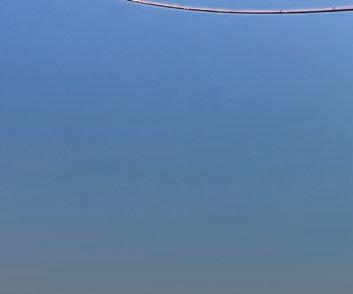
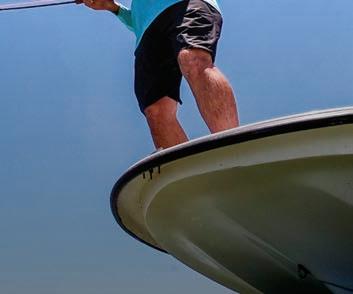
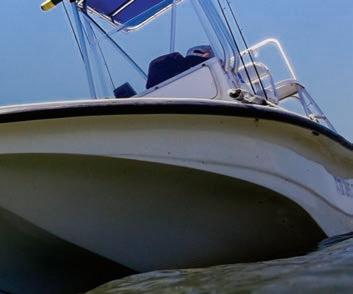







a weekend on Texas’s only tropical island, where you can catch your limit from the jetties, in the bay or out in the Gulf. It’s an experience no angler should miss, so plan your trip today. TSFMAG.com | 57
Yardw k. ESCAPE Spend
Port O'Connor Seadrift
MID-COAST BAYS With the Grays
As you already know too well, fishing in this summer’s heat has been more brutal than years past. Consistently low tides and higher than normal winds many days have kept us away from some of our usual summertime locales. That’s not to say we haven’t ventured to the middle of San Antonio Bay or even the surf whenever possible, but certainly not as often as in the past. Windy weekends this summer reduced fishable real estate making for some really congested waters. With schools and sports starting up again, I look for some of that congestion to ease quite a bit and I couldn’t be happier.
aware that the fishery always manages to recover in some amount, but fishing pressure will only continue to grow. The only influence we can hope to have going forward is through regulations that not only help conserve what we still have, but also enable the fishery to grow.
Telephone 361-785-6708
Email bayrats@tisd.net
Website www.bayrat.com
Facebook @captsgaryandshelliegray
March 16, 2022 through August 31, 2023, TPWD implemented emergency speckled trout regulations for the middle and lower coast regions in effort to boost recovery from the February 2021 freeze. The daily bag limit was reduced from 5 fish to 3, with a narrowed retention slot of 17to 23-inches, versus the prior length regulations of 15- to 25-inches, wherein anglers could retain one per day longer than 25.
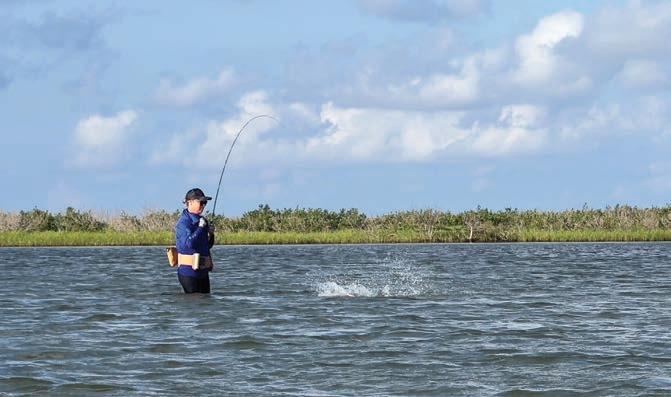

Beginning September 1, the emergency order will expire and revert back to the prior bag and length regulations. Considering the state of the fishery and looking to the future, rather than reinstating the prior regulations, I would personally support a daily bag limit of 3 trout with a slot of 15- to 20-inches, with no fish longer than 20 inches being retained. I expect to receive some negative feedback, but I will also point out that fishing pressure has exploded during the last 10 years. While I love to see others enjoying fishing as much as I always have, I also know that the only way we can withstand this kind of pressure and still maintain a healthy fishery is to become more conservative with our catch. We can never predict what Mother Nature will send our way, whether drought, flood, red tide outbreaks, or freezes. And yes, I am also
Some might wonder why I do not support a 17-inch minimum. So, here’s my take, based on my very experienced observations. Here on the middle coast, our bays are populated mostly with trout less than 16 inches. What I observed during the 18 month stretch was not what I think TPWD envisioned when they enacted the temporary changes. For as long as I can remember, we have always had dolphins in the areas we fish. While I cannot say their numbers have increased, what I can say is that dolphin behavior has definitely become more aggressive. They have learned that boat and wade fishermen are throwing back a lot more of their catch than in years past. This “learned” behavior has kept dolphins lurking right next to anglers because they know lots of stunned fish are being released. What an easy meal for these creatures. Unfortunately, this has created a growing dislike for dolphins amongst anglers. I love dolphins probably more than most but this learned behavior is not healthy for them. It’s really not healthy for young dolphins that grow up learning this behavior instead of learning to hunt their quarry without the influence of anglers. Hopefully, with fewer throwbacks, dolphins might unlearn this behavior.
Our weather will hopefully begin cooling off soon. In years past we have come to expect a cool front to blow through around midSeptember. I am keeping my fingers crossed that it’ll arrive sooner rather than later. In the meantime, I will continue fishing summertime patterns. Hard sandy bottoms and mid-bay reefs will be my go-to places, starting shallow early and transitioning to waist-deep or more as the day heats up.
A new lure we’ve been having success with is the Lit’l P&V scented twitchbait from Bass Assassin. The erratic movement of this soft plastic is great for enticing the less than enthusiastic and somewhat lazy summertime fish to bite. I get the best action out of them with my Waterloo 6’7 HP Lite rod, rigged on an 1/8-ounce jigheads.
While we wait for cooler weather to arrive, please remember to stay hydrated and pack your patience on weekends. There’s enough water out there for everyone, so please be considerate of others and don’t crowd an area just because you see other anglers hooking up.
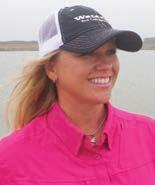 Captain Shellie Gray was born in Port Lavaca and has been guiding in the Seadrift/ Port O’Connor area full time for the past 19 years. Shellie specializes in wading for trout and redfish year round with artificial lures.
Captain Shellie Gray was born in Port Lavaca and has been guiding in the Seadrift/ Port O’Connor area full time for the past 19 years. Shellie specializes in wading for trout and redfish year round with artificial lures.
CAPT. SHELLIE GRAY
Kole Schmitt was proud to show off his first “keeper” trout on his first wading trip with me using artificials.
58 | September 2023
Karen Petru had her work cut out for her landing this big red.


TSFMAG.com | 59
HOOKED UP WITH Rowsey
Upper Laguna/ Baffin
David Rowsey has 30 years in Baffin and Upper Laguna Madre; trophy trout with artificial lures is his specialty. David has a great passion for conservation and encourages catch and release of trophy fish.
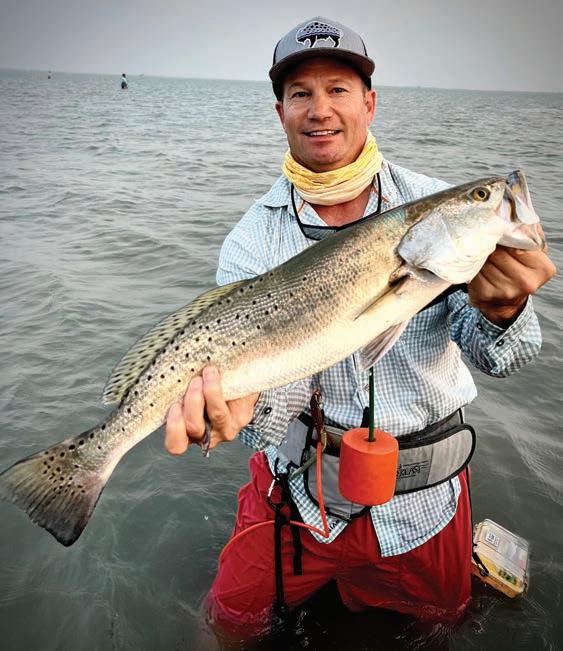
Telephone 361-960-0340
Website


www.DavidRowsey.com
Email david.rowsey@yahoo.com
I will readily admit that gun smoke and feathers drifting in the wind is where my brain is right now. It has been an incredibly full year of fishing and I just need my nostrils full of burnt powder and a sweaty dog this month. Most of y’all get it, and the ones that don’t need to get out in the field for another “Texas holiday” known as the opening day of dove season.
There is so much going on in the sport of saltwater trout fishing that I almost do not even know where to start.

Texas Parks and Wildlife commissioners meeting took place on August 23-24. I was there for the public comment session and spoke to what I see in the trout fishery, and my opinion on what is the most sustainable for the fishery and users. One thing I’ve learned over all my adult years is that pleasing everyone is simply impossible, so my take on it all comes down to what is best for the fishery, first and foremost.
the end of the month as the heat wave breaks and our baitfish start gathering up to make a push into the gulf come September.
Look for patterns to follow the concentrated bait in areas of flats for nighttime feeding, and deep-water access for the trout and mullet to congregate within as they head a little further north toward gulf passes each day. In this area, spoil islands, along with the east and west shorelines of the upper Laguna Madre will be the main corridors for the migration. Any of these areas have potential to produce big, but don’t assume you will find them in the same spot two days in a row. Some days they move 200 yards and others maybe a 1/2 mile. Bait activity will tell you the story before you even get out of the boat. Pay attention to your surroundings and be willing to adjust your starting point on any given morning. If it doesn’t look right, it’s probably not. Move with them!
I’ll be opening my books this month for multi-day charters. December through May of 2024 dates will get swooped up pretty fast, so contact me sooner than later if wading Baffin and the Laguna during these months is on your radar. There is still no place better to have a chance at a giant trout than our Mother Lagoon, and the reason we fight so hard to protect her.
Remember the buffalo! -Capt David
@captdavidrowsey
Watching where we have come from in the 1990s through the 2000s to where we are now is just sad to me. Anyone who thinks the fishery is in great shape either isn’t old enough to have experienced those days or is just content with the fact that there are at least some trout (of any size) swimming around in the bay. Before my ashes are spread across Baffin, I hope all of you get to experience a day of ten trout over eight pounds. I know it sounds far-fetched, but it used to happen!!
There are as many armchair biologists out here as there are seagulls, me included. That being said, we all know what we want out of the fishery. In my case, it’s a 2 trout limit, 16- to 20-inch retention slot, with the option to buy a trophy tag for anything over 20 inches. For the number of users currently targeting trout, I think this would be the most sustainable to insure not only numbers, but also give us our quality fishery back.
Why 16 inches, you may ask? Well, establishing this as a minimum length would guarantee that each female will have multiple opportunities to spawn before she is taken from the system by hooks. Regardless of what the minimum is, you will always have a pile of nonkeeper fish just shorter than the minimum slot size.
Like I said, there are many opinions on the subject, but the bottom line is something has to be done if we want to have quality fish in the bay for the future. Coastal Fisheries is open to your comments via their public email, but plan on a canned statement follow up. The most important thing is that they have heard from you. I, strongly, encourage you to email them your concerns: cfish@tpwd.texas.gov
Bay waters throughout the month will stay on the warm side; however, I think you will find a little relief from the heat on your morning wades. The bite should be way more consistent towards
DAVID ROWSEY
Rowsey
View The Video Open Camera and hover over QR Code. When link appears at top of screen tap to open in YouTube.
60 | September 2023
Seems that Corey Ferguson always manages to get it done every trip on big trout. Beautiful summertime 27-incher that was released to spawn again. Houdini color Bass Assassin was too much for her to resist.

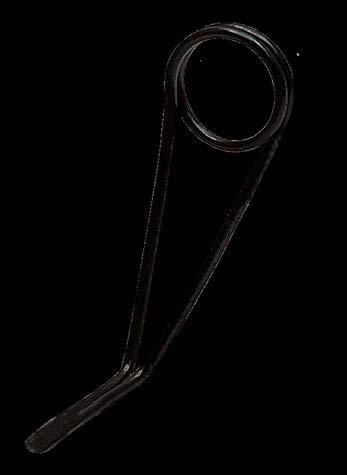




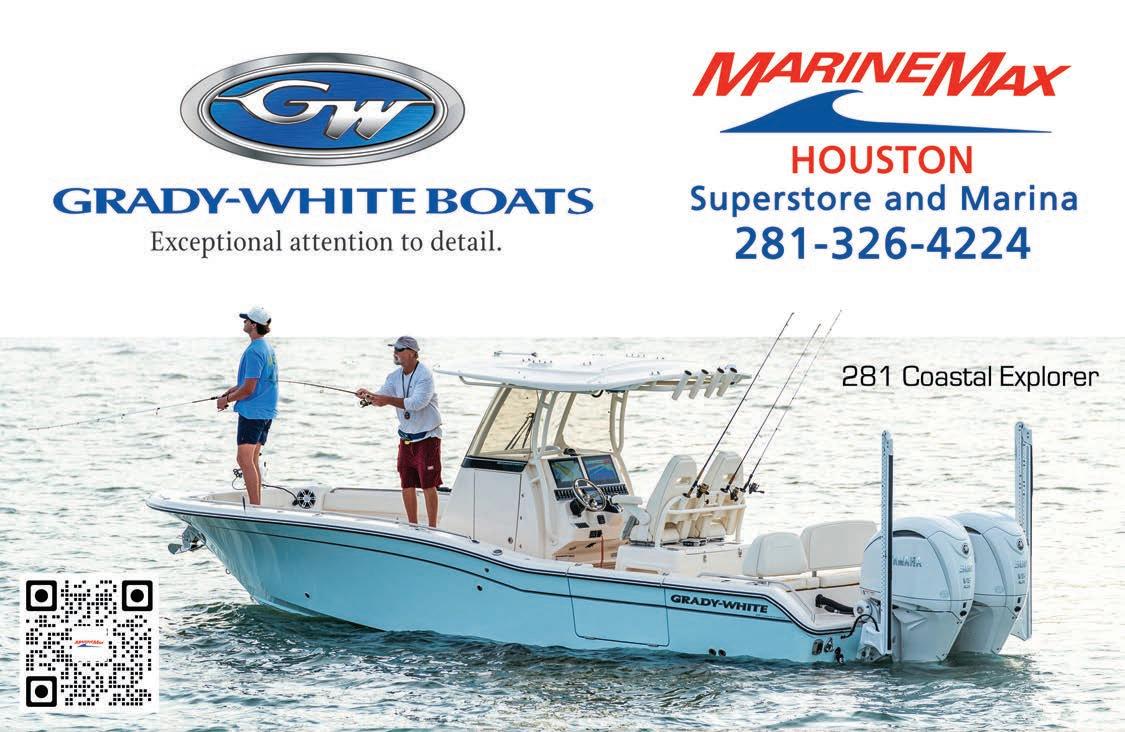
(860) 749-3476 Sales@REC.com www.REC.com GUIDE CHOICE MATTERS MADE IN USA ALLNEW RecoilXL® Original Recoil® 50% TALLER AVERAGE GUIDE HEIGHT RECOIL XL® combines all the features of REC RECOIL® guides with an entirely new fieldtested frame design. This design utilizes the existing loop diameter of RECOIL guides with a significantly higher guide height. This revolutionary guide design increases rod performance by significantly reducing line slap on the blank and reducing guide weight and bulk. By significantly reducing line slap overall casting distance is increased. With a higher guide height, smaller guide sizes can be used to achieve the same “choke-down” effect. This reduction in guide train size results in decreased guide weight and bulk. TSFMAG.com | 61
Port Mansfield
WAYNE’S Mansfield Report
September is just days away and I couldn’t be more excited. Not because we will be out of the heat, that’s still a ways off, it’s more about what is rapidly approaching. September is all about transitions; reduced boat traffic, a hint of cooler air, and rising tides. We are already seeing schools of reds forming close to deep water and as tides increase they’ll become more noticeable on the flats. The bottom line is that fish just start to become more active as fall approaches.
to do their part moving forward by at least having the conversation with clients and reminding them of where we’ve been and where we are trying to go. Truth be told, we as guides are the very first to see what is unfolding in our waters and that’s relevant. I often express my observations to my colleagues at TPWD and Harte Research Institute to help keep them abreast of what the LLM looks like on a day-to-day basis. That said, and to keep it simple, why don’t we as anglers “Just Keep Three?”
Telephone 210-287-3877
Email captwayne@kwigglers.com

The last couple of months have been challenging for the guide who likes to wade in knee-deep water most of the time. I cannot recall seeing the south/ southwest winds blow so consistently for such a long period of time. During those hot days I’ve learned a lot and, to be quite honest, some of those days challenged my spirit. Needless to say, we figured it out best we could and pressed on.
That said, as the south/southwest winds eased and shifted to the southeast, you could feel the difference almost instantly. Fish started blowing up on topwaters more frequently and really thumping soft plastics. They seemed to fight harder, which I also credit to the shift in the weather, just as I did as an angler. I believe (hope) those pesky “convection oven” southwest winds are finally behind us and I am so much looking forward to fall-like fishing beginning to develop.

Our smaller trout population remains very strong as witnessed by the numbers we’ve been catching in the 10- to 16-inch size range on just about every outing. The “emergency regulations” of 17- to 23-inches with bag limit of 3 trout will revert back to the prior regulations of 15- to 25-inches and bag limit of 5 trout, with one allowed over 25” per day – effective September 1, 2023.
I am personally quite disappointed to see this coming because it’s just now that we are seeing what the emergency regulations were intended to do for our fishery. We have protected a ton of trout between 15-17 inches and a lot of females over 23 inches. So now, unfortunately, those females we’ve been protecting will once again become candidates for the ice chest and those up-and-comers will follow suit; not to mention all those soon-to-be-trophy 25-inchers.
I’ve said it forever; just because the law allows it does not mean we have to capitalize on it. I sure am hoping that guides will continue
Back to fishing. As mentioned, water levels should increase a bit and the flats will start to come alive. Through this current heat wave, a lot of fish have been holding deep but as we transition, they will be migrating shallower and making my life a lot easier. I won’t be forced to work “nook and cranny” spots as much as more open water areas with structure such as potholes and scattered grassbeds becoming the preferred target areas.
Flounder have been showing in encouraging numbers. We found an area recently that gave our group eight solid fish with one of 4.5 pounds during a short wade. (See photo with Mason Monroe). When you catch flounder like that you know you are living right!
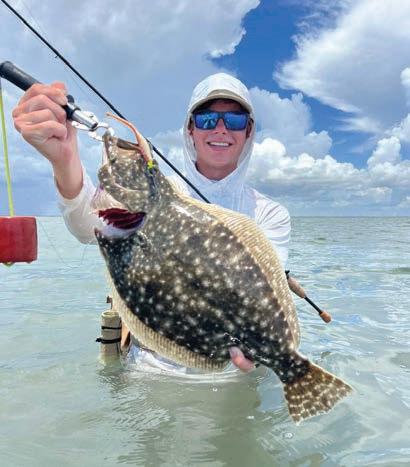
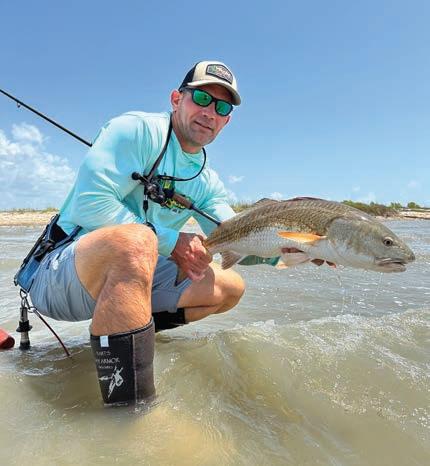
Baits of choice have been the new junior-size Ball Tail Shad in the full range of colors. On that flounder session I mentioned, I took the opportunity to test the flounder’s willingness to take other lures and switched to the proven 4-inch KWiggler Paddle Tail. Surprisingly, even with my group hooking-up repeatedly, I found no takers. I stayed with it fully twenty minutes just to try and prove a point which didn’t work in my favor, but was nonetheless a valuable lesson. Not scientifically proven, but sometimes fish are specific in what they want to eat. Keep that in mind and feed ‘em what they want.
Until next time, remember fresh is better than frozen…
View The Video Open Camera and hover over QR Code. When link appears at top of screen tap to open in YouTube.
Captain Wayne Davis has been fishing the Lower Laguna-Port Mansfield for over 20 years. He specializes in wade fishing with lures.
WAYNE DAVIS
Larry Higgins with a beautiful late-summer shoreline redfish.
62 | September 2023
Mason Moore – 4.5 pound flounder…Wow!
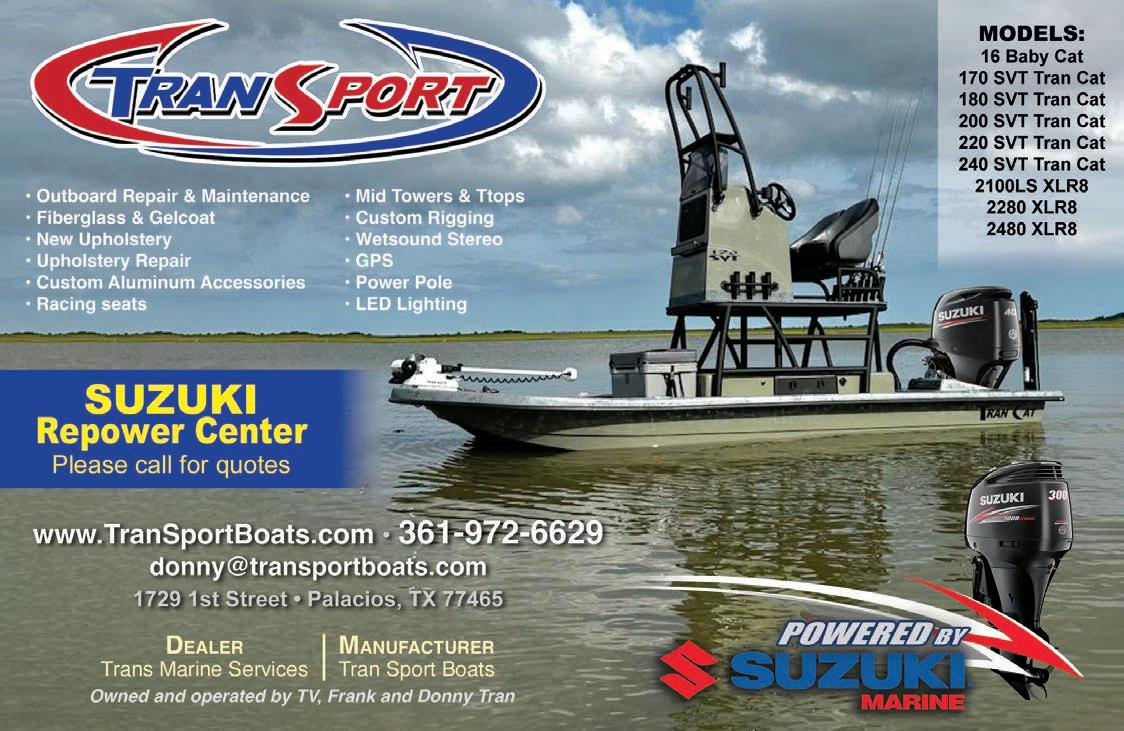
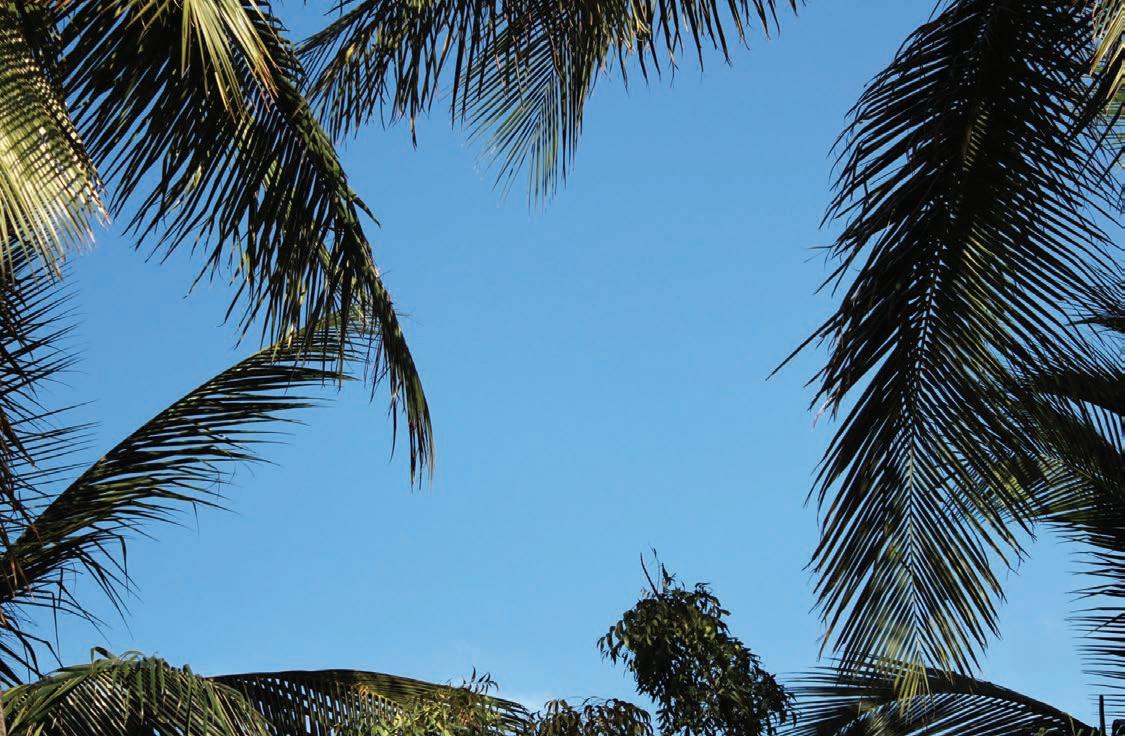
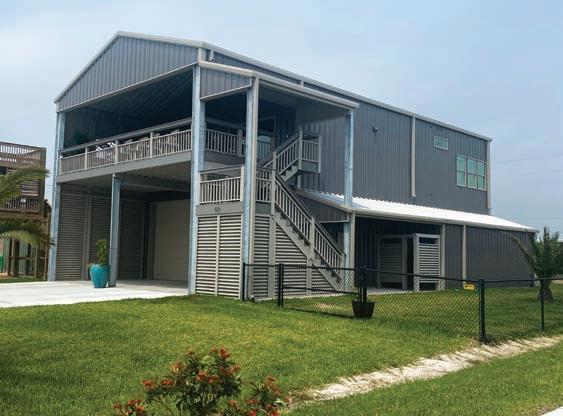
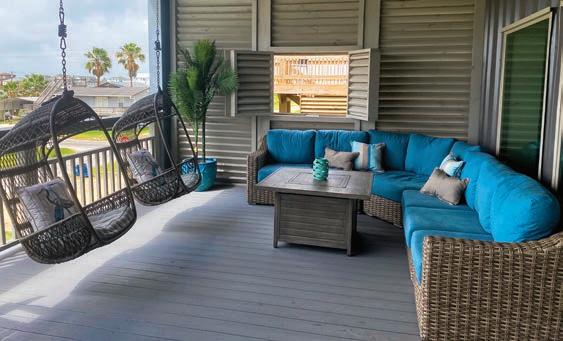

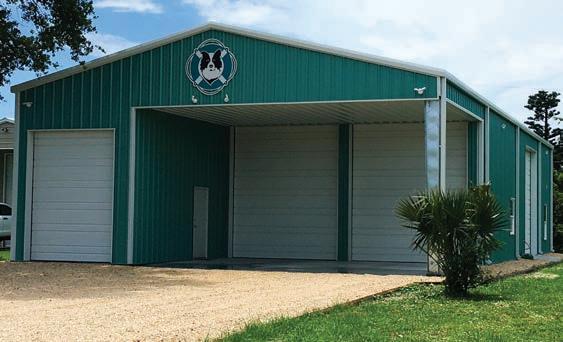

Call us for custom buildings and homes on your own property! 361-576-3825 Office | 361-576-3828 Fax 36 Hunters Circle, Victoria, TX 77905 www.RafterJConstruction.com Barndominiums • Metal Buildings • Boat and Mini Storage • Metal Frame Homes • Commercial Buildings
TSFMAG.com | 63
“We contracted the construction of the TSFMag office building with Farrell Jackson. Jackson also built my son’s bay house here in Seadrift. We were completely satisfied with both projects…a professional and trustworthy contractor.” ~ Everett Johnson | Editor/Publisher, TSF Mag
Cell 956-266-6454
Website www.tightlinescharters.com

SOUTH PADRE Fishing Scene
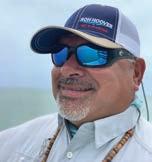
It’s been a busy summer with boat launches and parking areas full from early morning until well into afternoon. Countless times I have noticed people launching before daylight with their vehicle headlights on. Don’t be that guy. It is common courtesy to switch off the main beams to avoid blinding the guy trying to back down in the next lane. Another courtesy reminder; when running the open bay, especially on weekends, try to use the ICW to get from spot to spot whenever practical. I know this may not always be possible, but when approaching an area occupied by other boaters, especially on the flats, please give your fellow anglers as wide a berth as possible. The same as launch ramp etiquette, we can all contribute to helping one another enjoy this wonderful pastime.
We finished August with a bang. Redfish were plentiful despite low tides and super-heated water. Trout ran toward the small side on average but a handful of keepers could be managed on most trips. The snook bite was phenomenal when the tides were favorable.

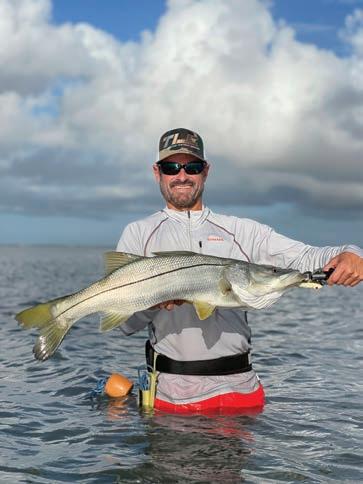
September is usually a wet month, which produces a slight decline in water temperatures, while also helping reduce salinity in some areas. The tides, I expect, will begin to rise soon. Higher tides will do two things. It will cause fish to spread over wider areas as the shallowest flats will become more accessible to both bait and game fish, and cooler water coming in from the gulf will allow fish to stay shallow for extended periods compared to recent months. Also, the opening of hunting seasons draws many anglers away from the water and into the fields in September, making our bay waters less congested and our fish more approachable.
Redfish action has been superb, and if that’s any indication, I am excited at our prospects heading into the fall season. With the tides continuing to rise throughout the month, I am expecting even more tailing action as the reds move further into the backwaters than we saw in August. The coming of fall also gives us friendlier wind patterns that increases our ability to spot schools cruising the flats and fish tailing and feeding in shallow water. If my memory is good, I believe I have seen more tailing recently than the previous ten years. Currently, we are seeing redfish gathering in small groups, I call it podding, a prelude to the larger schools commonly seen later in fall. When the reds are tailing, they are head down, grubbing the bottom for small crabs and shrimp. Their tails stick above the water, happily waving as they gorge on crustaceans. Because they are occupied with feeding, they become less wary than normal and very approachable for wading
anglers that move forward cautiously. This is when a precise cast is almost a sure bet for a hookup.
We are doing well on redfish with ZMan baits like the Paddlerz in Pearl and the Streakz in Space Guppy. The KickerCrabZ in natural colors have also been steady producers. We are rigging these on Eye Strike and Trout Eye jigs. When fishing heavier grass we use the weedless Texas Eye Finesse.
Our trout have been smaller on average, no surprise given the elevated water temperatures. I am hopeful to see better fish coming to hand as the water begins to cool. If you’re looking for plenty of action, stick to the edges of the ICW and shallow areas nearby. Depending the amount of rain in September and potential for reduced salinity, I will likely focus my trout effort closer to the passes with stronger tide influence. Stay away from backcountry drains that dump loads of fresh water into the system.
Slicks, a telltale sign of trout feeding, will remain prevalent this month. Remember that the smaller the slick the better it is as an indicator of the location of feeding activity. Targeting larger trout this month, I recommend drop-offs from shallow flats that are holding concentrations of mullet and other forage species such as shad. Preferred trout baits are ZMan Streakz in Space Guppy and Paddlerz in Pearl, rigged on 1/8 Trout Eye jigs, and 1/4 oz when fishing deeper.
Here’s a tip if you’re looking to add a new rod. I highly recommend the new Excel G2 Green Rod from Fishing Tackle Unlimited. It is available in three actions; Finesse, Classic, and Corky. Top quality components and craftsmanship make this rod light and durable. The sensitivity and backbone strength are superior. Visit either of their two Houston stores and check them out.
View The Video Open Camera and hover over QR Code. When link appears at top of screen tap to open in YouTube.
A Brownsville-area native, Capt. Ernest Cisneros fishes the Lower Laguna Madre from Port Mansfield to Port Isabel. Ernest specializes in wading and poled skiff adventures for snook, trout, and redfish.
CISNEROS
Arroyo Colorado to Port Isabel CAPT. ERNEST
Hayley Gwyn’s first snook; one of eight she landed on this trip.
64 | September 2023
Not to be outdone, Chris Gwyn also got in on the action with this beauty.

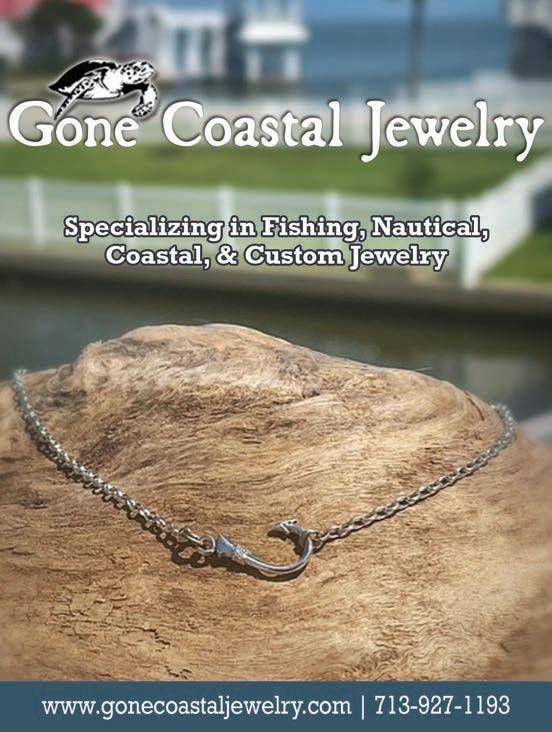
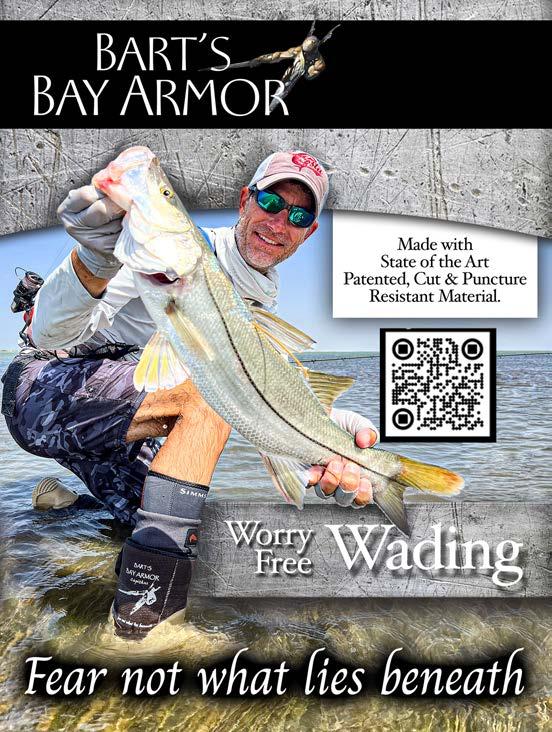



TSFMAG.com | 65
FISHING REPORTS AND FORECASTS from Big Lake to Boca Chica

Trinity Bay - East Bay - Galveston Bay | James Plaag
Silver King Adventures - silverkingadventures.com - 409.935.7242
James says he’ll be focusing mostly on the nearshore Gulf to hunt roaming schools of tarpon during September, and that the patterns which best produce trout will remain much the same as they have all summer. “Barring any storms, and given the typical calm wind patterns of September, tarpon fishing can be great this month. I’ll be searching for them as often as I can, looking for fish rolling at the surface, or working around concentrations of bait and bird activity in the open Gulf. Folks interested in fishing for trout in the bays should continue to focus on areas in deep water, mostly close to the ship channel or ICW. Keying on areas with plenty of slicks popping and/or working birds will lead to the best results. Deploying an anchor and making repeated casts at structures sticking up off the bottom works best. In those kinds of places, it’s important to set the boat in the right place, to allow for throwing lures around the structures and retrieving them in directions with or indirectly with the current. Depth and speed of presentation are critical in these situations too.”
Jimmy West | Bolivar Guide Service - 409.996.3054
Jim always gets excited for the coming hunting seasons once September looms on the horizon. “Dove season will start on the first, and teal season cranks up soon after that. I’ll be hunting a lot this month. The prospects for fast shooting on the dove side look great. Hot, dry weather makes for excellent dove hunting. Folks interested in hunting the waterfowl will be reliant on having water on the prairies. People who have wells or other sources of water will have great hunting, while others will go without birds in this drought. All that can change, of course, if we get a tropical storm or some other big rain event. The fishing will remain much the same as it has all summer. Recently, we had a good run of catching trout in the surf, fish up to about six and a half pounds. During the calm spells, that pattern can remain productive in September. Otherwise, folks will do best fishing out in the middle, keying on slicks and rafts of bait and mud stirs in fairly deep water around some of the main reefs. The bite for waders on the shorelines is usually a short-lived, early-morning thing.”
West Galveston - Bastrop - Christmas - Chocolate Bays
Randall Groves | Groves Guide Service
979.849.7019 - 979.864.9323
In addition to the surf, which is always a good option for anglers targeting trout during the hot months, when winds calm enough to allow the water to run green to the beach, Randall also mentions another productive plan. “We’ll be targeting trout in fairly deep water, with some scattered shell on the bottom. At the end of summer, some of the shrimp start moving out of the backwater areas, heading through the open bay, toward the Gulf. When they do, the trout feed aggressively on them. Normally, we use slicks to locate the places where the action is occurring. When fishing slicks, we like to start off well upwind and upcurrent of small slicks for best results. On the best days, we find flocks of gulls hovering over the herds, waiting to grab shrimp as they jump out of the water, trying to avoid the attacking trout. When we find working birds, the action is usually fast on a variety of lures, including topwaters. More of the time, Norton Sand Eel Jr in colors like tequila gold and cayenne gold work better. We keep these rigged on a little heavier jigheads when we’re fishing out of the boat.”
Matagorda Bays |
Capt. Glenn Ging
Glenn’s Guide Service - 979.479.1460
www.glennsguideservice.com
The worst of the heat is pretty much over with for the year and relief from our first cool fronts is right around the corner. We’ll still see some hot days, though. The fishing in East Matagorda continues pretty consistent, with a nice mix of trout and redfish for drifters working mid-bay reefs. We are catching some really nice fish on the new Bass Assassin Lit’l P&V rigged on light jigheads, sometimes under Coastal Corks. Vudu shrimp under corks are working as well. Waders are doing well on live bait, fishing reefs on the east end of the bay and on the south shoreline over scattered shell in chest-deep water. West Matagorda is producing some nice tripletail here and there, mostly on live shrimp. There are decent numbers of speckled trout and black drum being caught on the shell reefs with live shrimp over that way too. Others are catching plenty of speckled trout and redfish by wading and throwing soft plastics and topwaters around the grassbeds on the south shoreline. The first cool fronts of the year should give us a few more days to fish the beachfront.
Palacios | Capt. Aaron Wollam
www.palaciosguideservice.com - 979.240.8204
We’ve had calmer winds, with a southeasterly heading much of the time lately, and fishing has improved dramatically. With the hot weather, our fish have moved close to deeper water; the trout bite has been steady out at the wells and deeper reefs in West Matagorda Bay on free-lined live shrimp and DSL lures in white ice and magic grass. Redfish are starting to show on area shorelines, mostly with deep water nearby, and we’re seeing a few schools. Pumpkinseed and pearl Norton Bull Minnows rubbed with Pro-Cure Shrimp Gel have been the best baits for reds. Tripletail this year are somewhat scarce, but we have landed a few, ranging from eight to about twelve pounds, using live shrimp about four to six feet under corks around visible structures. Giggers are finding better numbers of flounder on the south shoreline of West Matagorda Bay in places with sandy, grassy bottoms. They’re bringing in lots of solid 18-20” fish. We have lots of shad, shrimp and mullet in the bays, and action should pick up even more as the weather cools, especially in the back-bays and coves where gulls should be working over herds of migrating shrimp.”
Port O’Connor | Lynn Smith
Back Bay Guide Service - 361.935.6833
Lynn mentions a continuing need to fish in places with good tidal movements and where deep water and shallow flats lie in close proximity to one another, as the heat wave of summer rolls into September. “We’re all looking forward to some cooler weather, but September is usually another hot month. The patterns we’ve been fishing all summer will continue to produce best. I like to fish the surf as much as I can when winds die down and the clear water moves close to land. The trout bite is often great out there on topwaters early in the mornings in those situations. Best bet is to stay tight to the shore and fish the first and second guts until it gets hot, then move out into the deeper guts later. When we’re unable to get into the surf, we like to wade reefs and flats with deep water nearby. The bite is often best in the morning hours, when the tide is coming in. With so much bait in the water, it’s
66 | September 2023
The C.A.L. family of lures offer a wide variety of lure shapes for both freshwater and saltwater fishing. From small ponds to deep jigging ocean reefs, D.O.A. has you covered.



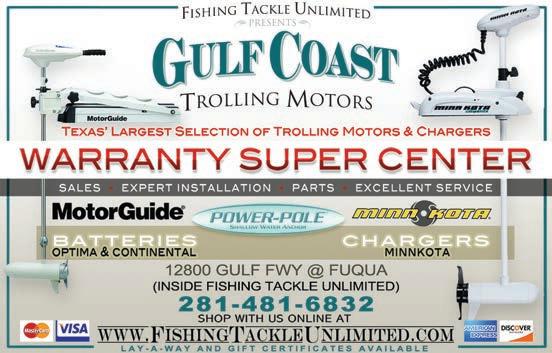
Made from tough soft plastic, each lure is made to match up perfectly to D.O.A. short and long shank jig heads.


www. doa lures.com Made in USA
5” Swim Bait
4” Shad Tail
3” Shad Tail C.A.L. 4” Jerk Bait
5.5” Jerk Bait C.A.L. Paddle Tail
Curl Tail 221981_DOA_10.5_TxSF_CAL Family_3.685 x 4.875.indd 1 10/5/22 2:34 PM TSFMAG.com | 67
C.A.L.
C.A.L.
C.A.L.
C.A.L.
C.A.L.
important to find areas with obviously active bait, meaning bait that’s showing fear from predators in the area. This usually means mullet that are moving fast and jumping a lot.”
Rockport | Blake Muirhead
Gator Trout Guide Service - 361.790.5203 or 361.441.3894
With the arrival of September, changes are definitely in the air for Blake. “The approaching fall season means a return to the cast-n-blast routine for me. This month, dove and teal seasons will arrive. I don’t do as many combination trips yet, but they’re coming. Until we get into big duck season, I’ll spend more of my time fishing than hunting, then it will become more of an even split. The fishing has remained steady in the Coastal Bend this summer, despite the blazing heat. We’ve had some decent days in the surf, and fishing for trout in the bays has been better in places close to deep water. In September, we catch plenty of trout in places where the reds are gathering up to move offshore to spend their lives as adults. The flats near the channels leading to Port Aransas all have the potential to hold big schools of reds this time of year. We normally key on big mud stirs, bird activity and nervous bait to find the migrating schools. The topwater bite is sporadically good for both trout and reds in September, but fishing with soft plastics and/or live bait is sometimes more productive.”
Upper Laguna Madre - Baffin Bay - Land Cut
Robert Zapata | rz1528@grandecom.net -
361.563.1160
I hope everyone is enjoying the fishing this summer, but I think we will all welcome a little bit cooler temperatures. The trout have been in the shallows, in about two feet of water or less, for just a few hours after sunrise. Natural-colored Bass Assassin Die Dappers rigged on sixteenth-ounce Spring-Lock jigheads are working well before they move out into deeper water as the sun gets higher in the sky. Look for them in areas with sandy potholes and grass lines. The redfish schools will still be around, especially on days when the wind is calm and in water depths of less than three feet. The key to success with catching the schooling reds is to not crash into them with the outboard. Stopping upwind at least 100 yards and then keeping up with them using the trolling motor works much better. I like to cast the Assassin Die Dappers in colors like sand trout and salt & pepper/chartreuse tail rigged on eighth-ounce jigheads or half-ounce weedless spoons to the outside edges of the schools so as not to spook the school too much. It’s also best not to pass directly over the schools in the boat.
Corpus Christi | Joe Mendez - www.sightcast1.com - 361.877.1230
Lots of people see September as a fall month, and the calendar verifies that part of it is, but the fishing patterns which work best in the Baffin Bay/Upper Laguna Madre area look much the same as they have throughout the hot months of summer. “We will be targeting trout on the deep, outer parts of flats, around the last visible grassbeds, and around the outer parts of rock formations, lying close to deep water. Should we receive a few significant cool fronts, the bite can be good tight to area shorelines and around the shallowest portions of the sand bars and rock formations in Baffin. The redfish will begin schooling and heading toward the passes this month. We find them best in the shallows early in the mornings by watching for the big wakes the schools make as they respond to passing boats. Later in the days, we find them swimming in deeper water, over bottoms without grass. In either scenario, we catch plenty by moving the boat upwind of the schools and making long casts around the edges of the concentrations.
P.I.N.S. Fishing Forecast | Eric Ozolins
361.877.3583 - Oceanepics.com
The migrations of baitfish along the beaches are beginning to take


shape. Dusky anchovies will kick it off and get driven in acre-size baitballs right up to the beach. Mackerel, skipjacks, jackfish, tarpon, sharks and other predators will be attacking them. Best bet is throwing a topwater or large spoon to avoid as many of the numerous skipjacks as possible. Hundreds, if not thousands of birds diving to snatch victims of the frays will identify the places with fast action. When these baitballs do get pushed almost up on the sand, sharks will practically beach themselves gorging on the anchovies. Be careful and alert when wading, not just for sharks but also for stingrays, still present in big numbers. The majority of action in September will revolve around bait presence. Aside from targeting fish around baitballs, the earlymorning action on trout around structures should be steady on both topwaters and soft plastics. Shark fishing will pick back up, with blacktip and bull sharks retreating from the shrimpers and coming to the beaches to feast on the anchovies and other migrating forage species. Anyone heading to the beach this time of year should keep an eye on the weather.
Port Mansfield | Ruben Garza
Snookdudecharters.com - 832.385.1431
Getaway Adventures Lodge - 956.944.4000
September is a really fun month, productive for both fishing and dove hunting. Which means a lot of cast-n-blasts charters for many local guides. September winds are often light in the mornings, and this is helpful to the people fishing. When winds are light over the LLM, the west shoreline is often the best place to target trout and redfish. Anywhere from Century Point to the Oak Mottes has excellent potential in this situation. Farther north, stretches from the mouth of Little Bay to Gladys Hole can also be outstanding. Topwaters work most every day, so smart anglers keep Mansfield Knockers in Ruby Tuesday handy. Soft plastics like KWiggler Ball
Tail Shad in Mansfield Margarita, Pollo Loco and Lagunaflauge are also productive. Closer to port, West Bay, Bennie’s Bar, the Pipeline and the Saucer are great areas. On the flats both north and south of the East Cut, redfish will be schooling in the shallows over sandy bottoms first thing in the mornings. Later, toward midday, they usually move to deeper water, following the schools of mullet. It’s hard to beat a gold weedless spoon when targeting the reds, but small topwaters also work well at times.
Lower Laguna Madre - South Padre - Port Isabel Aaron Cisneros | tightlinescharters.com - 956.639.1941
Trout fishing has remained steady. Trout of all sizes have been fairly plentiful on relatively deep, grassy flats. We’ve been finding our best numbers in depths of three to four feet, with the steadiest bite coming on ZMan Redbone Jerk ShadZ, rigged on eighth-ounce Eye Strike jigheads. We’ve been having our best luck when we’re working the lures low and slow, keeping them in contact with the bottom, and short-hopping them up out of the grass. Redfish have begun schooling in greater numbers. Most days, we’re finding a fast redfish bite in shallow water, on flats less than two feet deep. The redfish have been most active early in the mornings and again late in the evenings, but have been harder to catch during the hottest part of the days. We’ve been finding good numbers of tailing reds in the back-bays. A small topwater has been a great choice for targeting these reds early. Rigging with single hooks has helped considerably to overcome the floating grass situation. We typically switch to gold weedless spoons toward midday as the wind builds, rather than fighting the grass with topwaters. I expect these patterns will continue throughout the month.
68 | September 2023

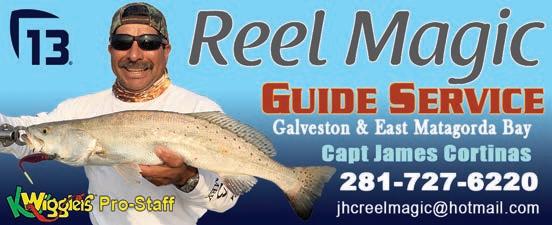


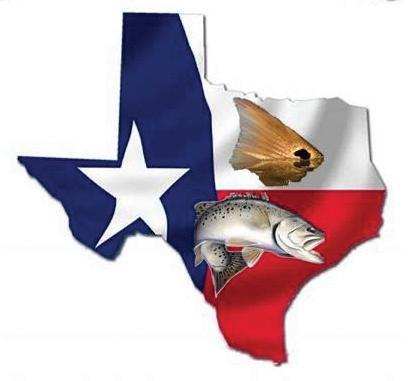
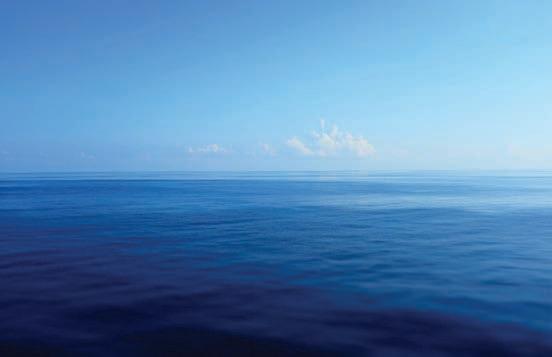

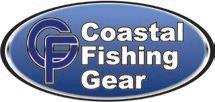


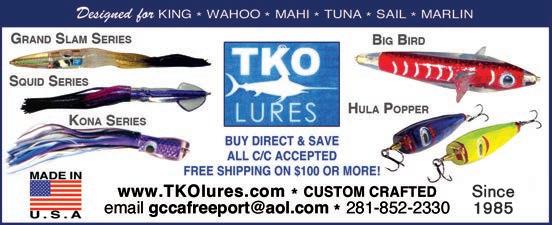


TEXAS SALTWATER FISHING HOLES USCG Licensed Captain Stan Sloan MATAGORDA BAY Speckled Trout / Redfish 832.693.4292 www.fishfcc.com Fin Tastic Coastal Charters Fishing Charters Galveston Offshore & Bay Full electronics & Bathroom. Included: bait, ice, ice water. Bring your own food and drink. Kingfish, Tuna, Mahi Mahi, Grouper, Snapper, Redfish, Flounder, Trout & more... 409-919-0833 | topgalvestoncharter.com Trips: 5,8,10,12 hours. Captain & Mate. Home of the & www.CoastalFishingGear.com | 281-736-6670 USE COUPON CODE TSFM15 FOR 15% OFF OF CFG ONLINE ORDERS PESCADO PARK RV PADS & BOAT STORAGE Baffin Bay near Kaufer-Hubert Boat Ramp DAN WARD 832-860-4600 dwpb@comcast.net TSFMAG.com | 69



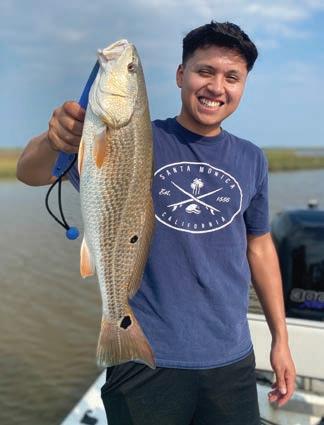


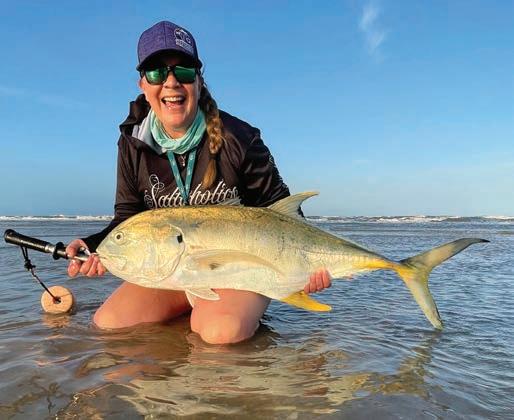

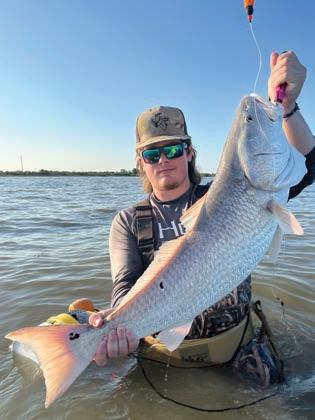
Brought To You By www.kingsailfishmounts.com
Devon Diaz Matagorda Bay - 22” first red!
Jim Collins Cold Pass, Galveston - pompano
Darrell Felix Baffin Bay - trout
Caden Deakle East Bay - 38” bull red
Angel Gidak with Kevin Gustainis West Matagorda Bay - first fish!
70 | September 2023
Nina Garrett Padre Island National Seashore - jack crevalle CPR
Photo Gallery Guidelines

First come – first published! Photos are judged on artistic merit and sporting ethic displayed. No stringer, cleaning table, or hanging board images allowed. Digital images only. Adjust camera to high or best quality. All images become property of TSFMag. Email to: Photos@TSFMag.com Include short description of your catch with name, date, bay system, etc.
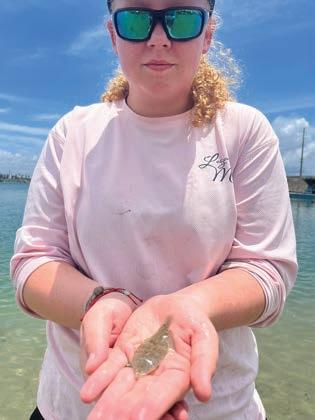
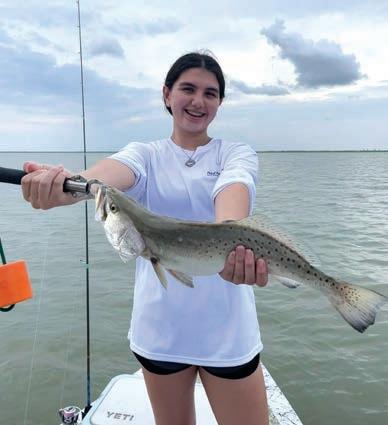
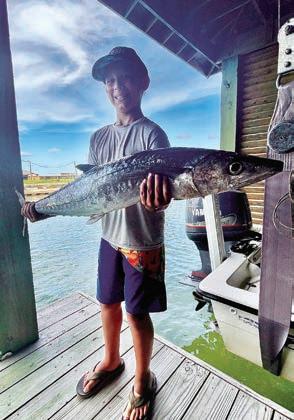
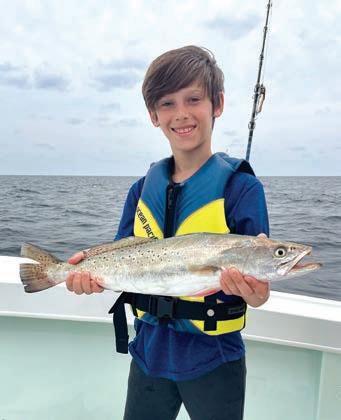



 Austin Diaz Matagorda Bay - 20” redfish
Reese Carroll Matagorda Island surf - trout
Abby Rodriguez West Galveston Bay - 4 lb trout
Jonathan Cazares Port Mansfield - 57.8 lb personal best red!
Todd Smith Sabine Pass - 27.5” 8 lb trout
Carson Carroll POC offshore - kingfish
Orlando Sauceda Copano Bay - 25” trout
Austin Diaz Matagorda Bay - 20” redfish
Reese Carroll Matagorda Island surf - trout
Abby Rodriguez West Galveston Bay - 4 lb trout
Jonathan Cazares Port Mansfield - 57.8 lb personal best red!
Todd Smith Sabine Pass - 27.5” 8 lb trout
Carson Carroll POC offshore - kingfish
Orlando Sauceda Copano Bay - 25” trout
TSFMAG.com | 71
Marley Crisp Corpus Christi - flounder
Gulf Coast
Got ideas, hints or recipes you’d like to share?

Email them to pam@tsfmag.com or send by fax: 361 792-4530
Cóctel de Camarones (Shrimp Cocktail)
INGREDIENTS
• 1-pound large shrimp: shelled, deveined, boiled

• juice of two limes
• ¼ cup finely chopped red onion
• ¼ cup chopped fresh cilantro, plus more for garnish
• ½ cup mayonnaise
• ¼ cup ketchup
• 1 teaspoon Louisiana Hot Sauce
• ½ tsp olive oil
• ½ tsp garlic powder
• ½ paprika
• salt and pepper to taste
PREPARATION
In a small bowl combine the lime juice, red onion, cilantro, mayonnaise, ketchup, hot sauce, olive oil, garlic powder, paprika. Add the cooked shrimp and mix well. Season with salt and pepper to your taste.
Serve with fried corn tortillas and garnish with chopped cilantro.
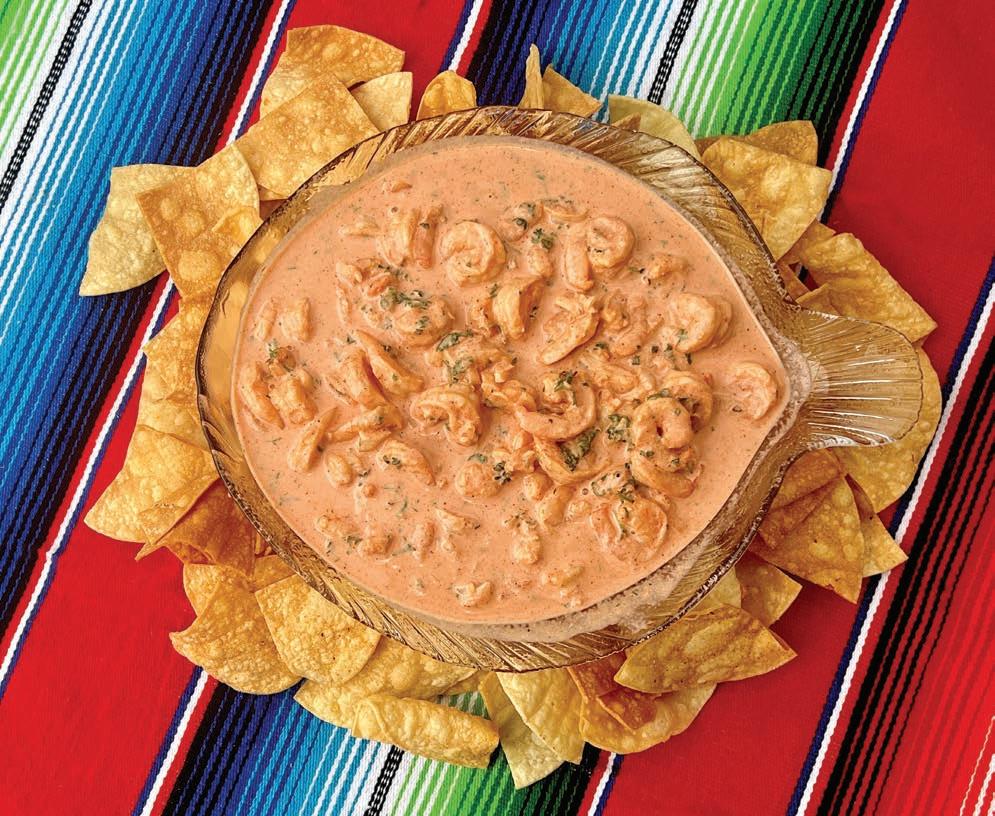
PAM JOHNSON
72 | September 2023
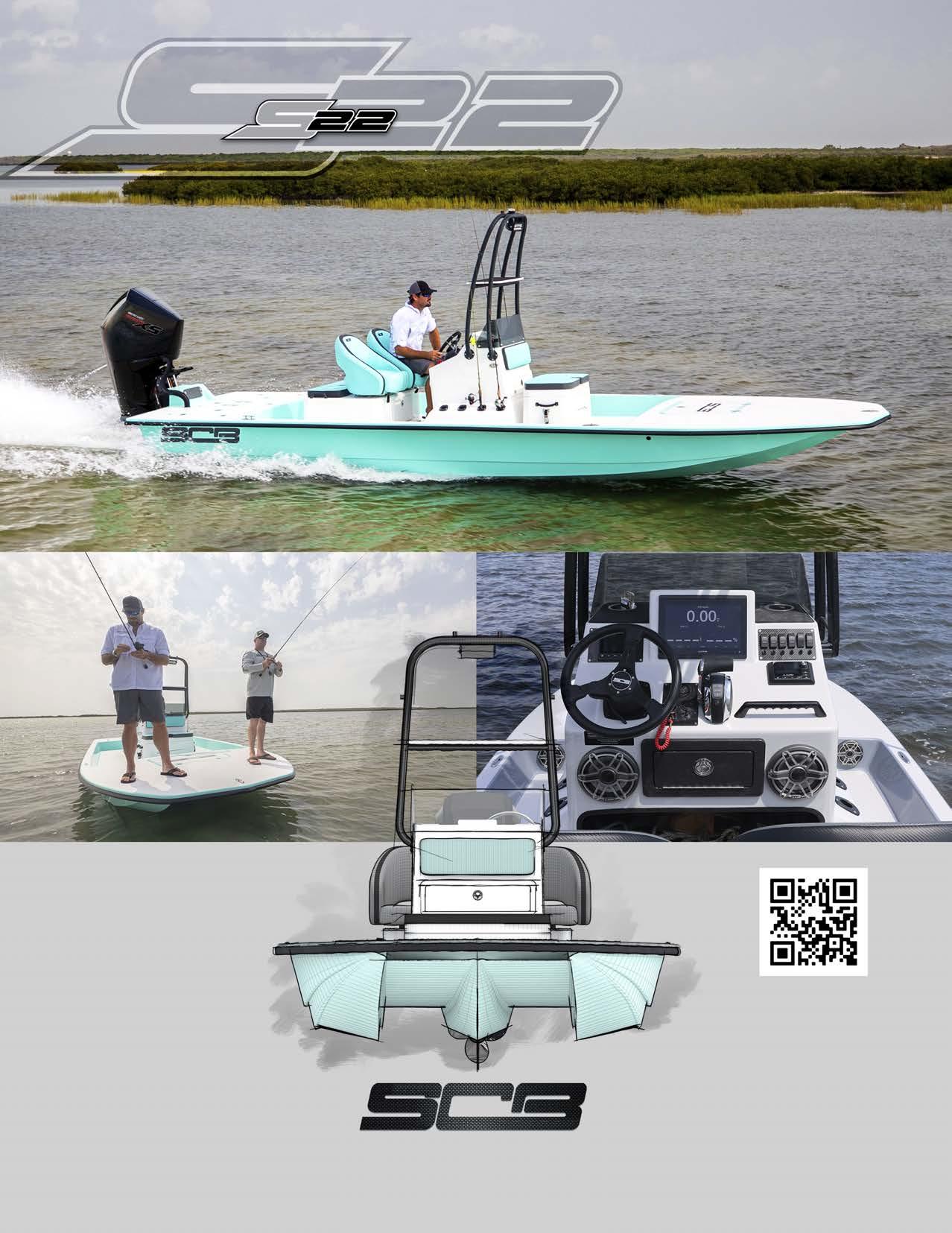
www.scbboats.com A DIVISION OF 956-233-9489 ® 10YEAR HULL WARRANTY BACKED WITH OUR ® DESIGN YOUR SCB ONLINE

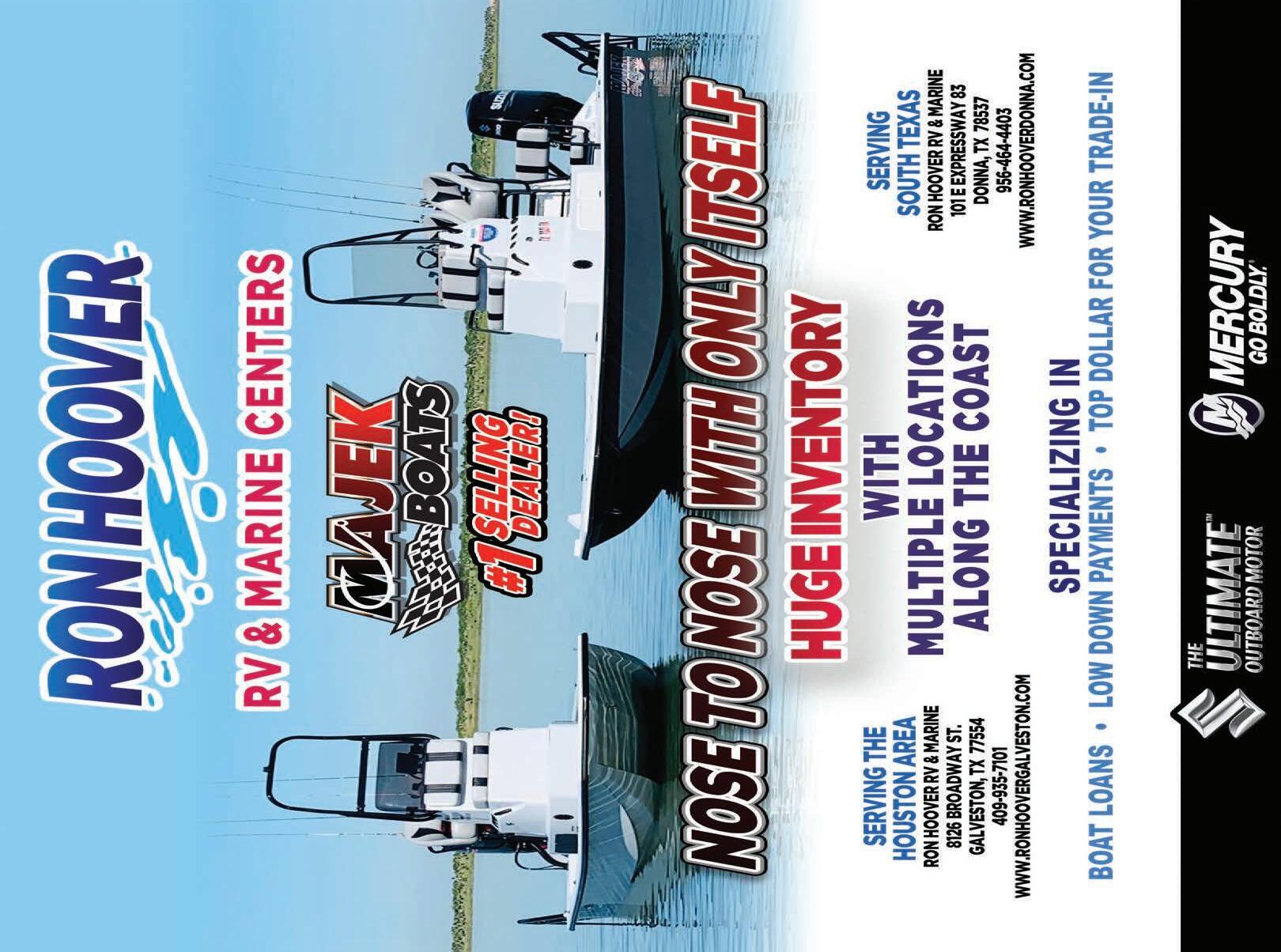


Brought to you by





Texas Saltwater Fishing Magazine l www.texassaltwaterfishingmagazine.com
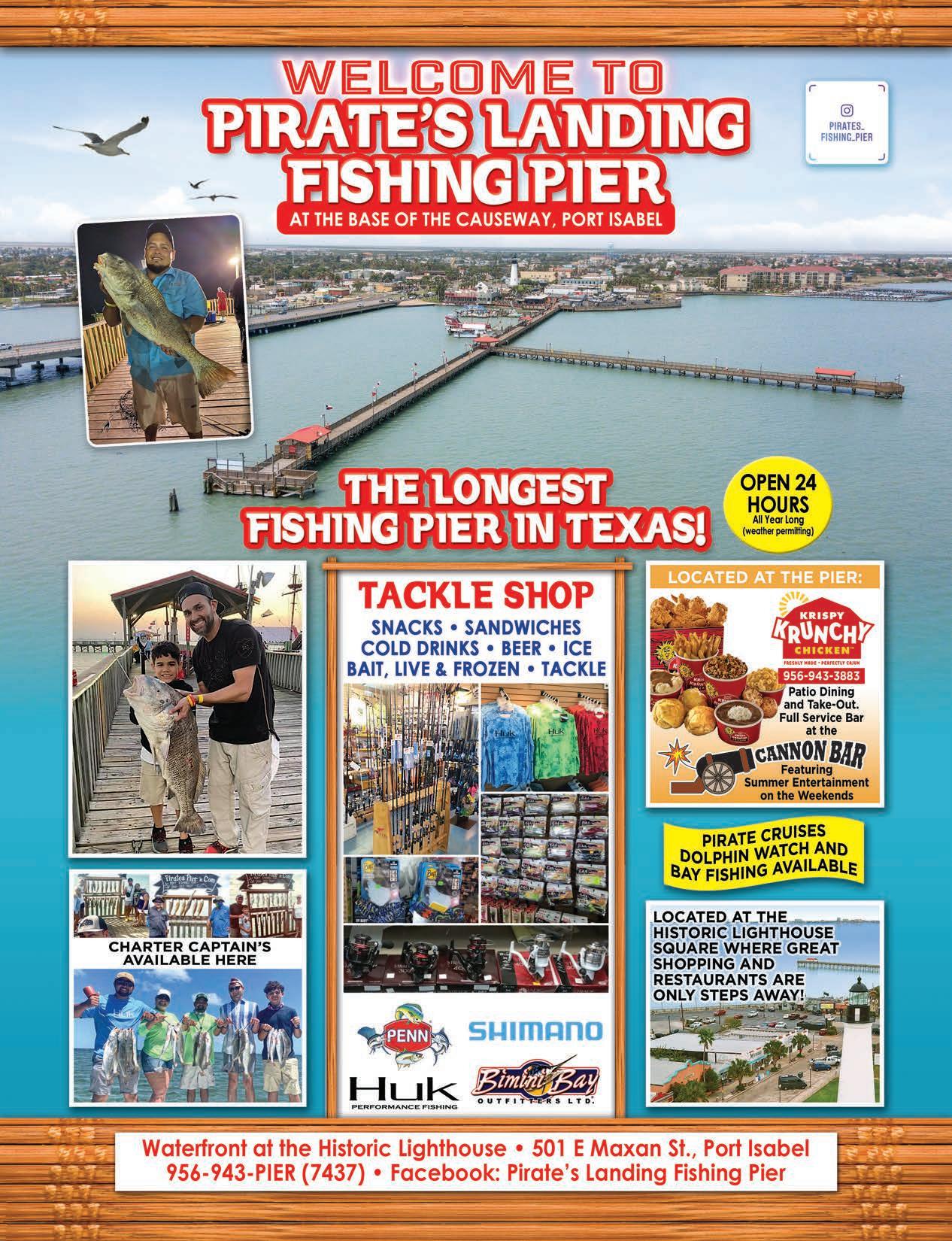




































 These giant reds were trying to eat our small specks as we reeled them in. Some succeeded!
These giant reds were trying to eat our small specks as we reeled them in. Some succeeded!






 STORY
STORY








 Different types of lures call for different types of presentations; anglers with better focus execute presentations more precisely.
Anglers deploying topwater lures benefit from maintaining eye-contact with the lures while making presentations.
Different types of lures call for different types of presentations; anglers with better focus execute presentations more precisely.
Anglers deploying topwater lures benefit from maintaining eye-contact with the lures while making presentations.


 The Captain describes details related to the catching of his longest trout to date
View The Video Open Camera and hover over QR Code. When link appears at top of screen tap to open in YouTube.
The Captain describes details related to the catching of his longest trout to date
View The Video Open Camera and hover over QR Code. When link appears at top of screen tap to open in YouTube.








 Typical bull redfish landed off Crystal Beach.
Typical bull redfish landed off Crystal Beach.




















 View The Video Open Camera and hover over QR Code. When link appears at top of screen tap to open in YouTube.
View The Video Open Camera and hover over QR Code. When link appears at top of screen tap to open in YouTube.








 Dave Roberts is an avid kayak-fishing enthusiast fishing primarily the inshore Upper Coast region with occasional adventures to surf and nearshore Gulf of Mexico.
View The Video Open Camera and hover over QR Code. When link appears at top of screen tap to open in YouTube.
Dave Roberts is an avid kayak-fishing enthusiast fishing primarily the inshore Upper Coast region with occasional adventures to surf and nearshore Gulf of Mexico.
View The Video Open Camera and hover over QR Code. When link appears at top of screen tap to open in YouTube.


















 Oz landed this 10-foot 10-inch dusky recently during the cold-water upwellings.
Oz landed this 10-foot 10-inch dusky recently during the cold-water upwellings.








































 Bink Grimes is a full-time fishing and hunting guide, freelance writer and photographer, and owner of Sunrise Lodge on Matagorda Bay.
Bink Grimes is a full-time fishing and hunting guide, freelance writer and photographer, and owner of Sunrise Lodge on Matagorda Bay.








 Captain Shellie Gray was born in Port Lavaca and has been guiding in the Seadrift/ Port O’Connor area full time for the past 19 years. Shellie specializes in wading for trout and redfish year round with artificial lures.
Captain Shellie Gray was born in Port Lavaca and has been guiding in the Seadrift/ Port O’Connor area full time for the past 19 years. Shellie specializes in wading for trout and redfish year round with artificial lures.





































































 Austin Diaz Matagorda Bay - 20” redfish
Reese Carroll Matagorda Island surf - trout
Abby Rodriguez West Galveston Bay - 4 lb trout
Jonathan Cazares Port Mansfield - 57.8 lb personal best red!
Todd Smith Sabine Pass - 27.5” 8 lb trout
Carson Carroll POC offshore - kingfish
Orlando Sauceda Copano Bay - 25” trout
Austin Diaz Matagorda Bay - 20” redfish
Reese Carroll Matagorda Island surf - trout
Abby Rodriguez West Galveston Bay - 4 lb trout
Jonathan Cazares Port Mansfield - 57.8 lb personal best red!
Todd Smith Sabine Pass - 27.5” 8 lb trout
Carson Carroll POC offshore - kingfish
Orlando Sauceda Copano Bay - 25” trout













